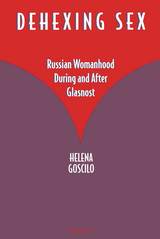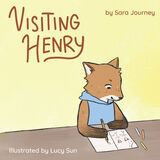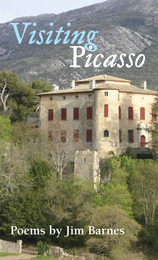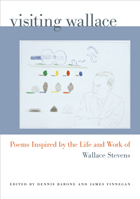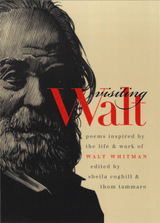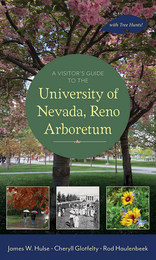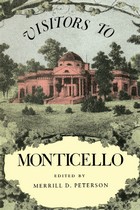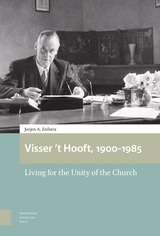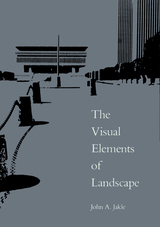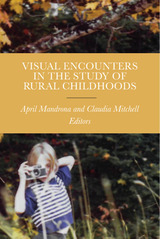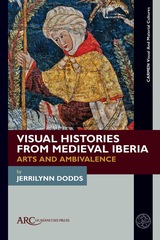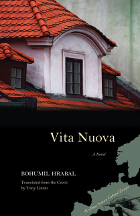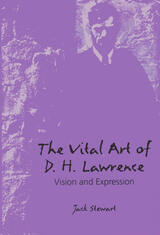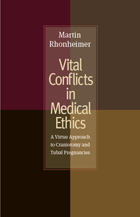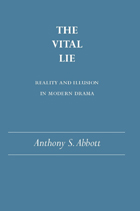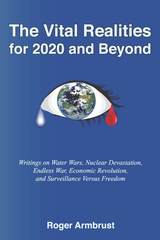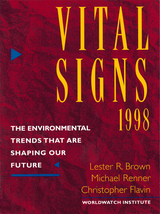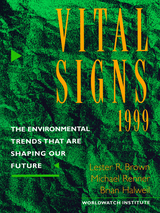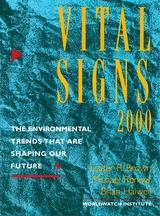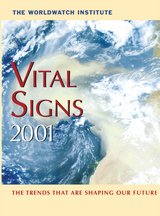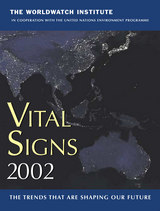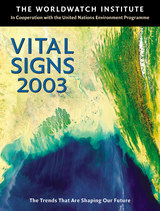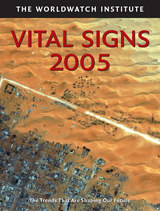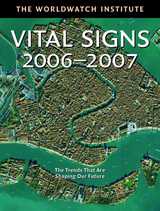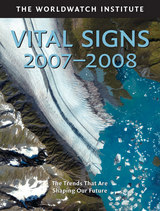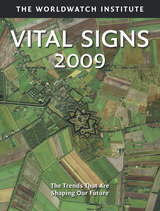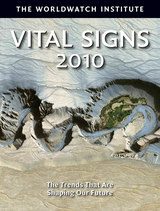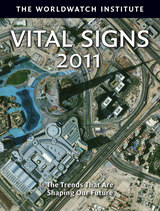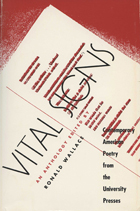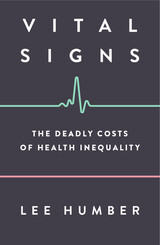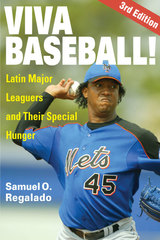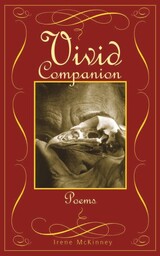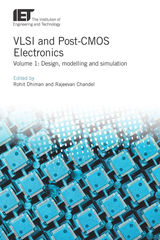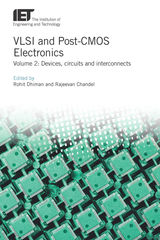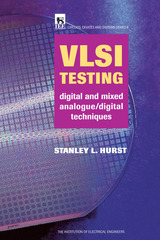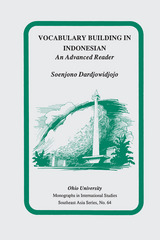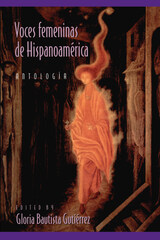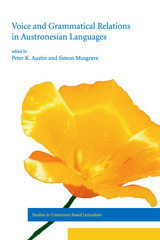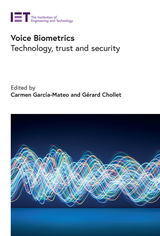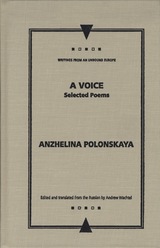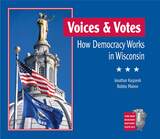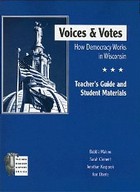Visions of War: World War II in Popular Literature and Culture
M. Paul Holsinger
University of Wisconsin Press, 1992 For Americans World War II was “a good war,” a war that was worth fighting. Even as the conflict was underway, a myriad of both fictional and nonfictional books began to appear examining one or another of the raging battles. These essays examine some of the best literature and popular culture of World War II. Many of the studies focus on women, several are about children, and all concern themselves with the ways that the war changed lives. While many of the contributors concern themselves with the United States, there are essays about Great Britain, Canada, France, Germany, Poland, Russia, and Japan.
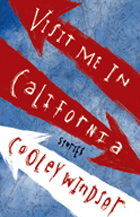 Visit Me in California: Stories
Cooley Windsor
Northwestern University Press, 2008 Deftly moving between the comic and the tragic, the sacred and the profane, this collection of short stories is populated by modern children, ancient poets, dying men, and your basic, mundane Greek gods. Windsor turns familiar stories from the Bible and from myth inside out, exploring the feelings of minor characters and looking at events from imaginative perspectives. His prose is rich with detail and emotion and he touches on themes of art and artifice, success and failure, family and its sacrifices, and expectations met or missed. In “The Last Israelite in the Red Sea,” a follower of Moses who dallies during their Exodus finds it more difficult to walk across the bottom of the temporarily displaced Red Sea without shoes. “Four of the Times My Sister Cried” follows a young narrator as his family rehearses for his mother’s death and then, as they must, lives without her. The wry “The Art of War” has characters from Homer to a courtesan talking shop about the battle of Troy from their perspectives. Set as a series of short pieces, “The Fleshly School of Poetry” tells of lessons learned and lessons taught. With its explorations of expectations, “Meet the Author” gives readers intimate portraits of various plans or coping mechanisms people put up when death draws close. “The End of the World” approaches the Rapture with a humorously practical spin: wouldn’t the angels need a plan to ensure that it goes smoothly? “In Parting” explores some of the troubles with family, especially when a sister’s child turns out to be a marionette. The geographically explicit “Three Mediums in San Francisco” touches on frustrated and imagined eroticism. The collection ends with “The Hilton Epiphany,” a fitting closer in which divinity comes to an unlikely person in an unlikely place.
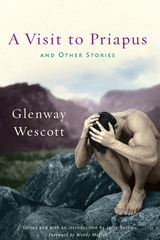 A Visit to Priapus and Other Stories
Glenway Wescott; Edited and with an introduction by Jerry Rosco; Foreword by Wendy Moffat
University of Wisconsin Press, 2013 Just as E. M. Forster's novel of gay love, Maurice, remained unpublished throughout his lifetime, Glenway Wescott's long story "A Visit to Priapus" was also destined to be a posthumous work, buried from 1938 until this century in Wescott's massive archive of manuscripts, journals, notebooks, and letters. The autobiographical story is about a literary man, frustrated in love, who puts aside his pride and makes a date with a young artist in Maine. Lavishly rendered in Wescott's elegant prose, the tale is explicit where it needs to be, but—as is typical of Wescott—it is filled with descriptive beauty and introspective lessons about sex and sexuality, love and creativity. Previously published in anthology form in the United Kingdom, "A Visit to Priapus" is presented for the first time in book form in America, containing previously uncollected stories, including three never before published. The result is a candid portrayal of the gifted but enigmatic writer who was famous in youth and remained a perceptive and compassionate voice throughout his long life. Drawn together from midcentury literary journals and magazines of the 1920s and 1930s, as well as from Wescott's papers, the stories were inspired by his life, from childhood to old age, from Wisconsin farm country to New York, London, Germany, and Paris.
Finalist, Gay General Fiction, Lambda Literary Awards
A Visitable Past: Views of Venice by American Artists, 1860-1915
Margaretta M. Lovell
University of Chicago Press, 1988 In this ambitious and imaginative study, Margaretta M. Lovell analyzes the large body of accomplished, sometimes startling, often brilliant work of American artists drawn to Venice's ragged splendor in the last century. Including major works by such diverse and talented painters as James McNeill Whistler, John Singer Sargent, and Maurice Prendergast, these richly varied paintings portray sleepy canals, architectural monuments, and scenes of picturesque everyday life while they also reveal surprising aspects of American culture.
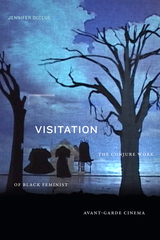 Visitation: The Conjure Work of Black Feminist Avant-Garde Cinema
Jennifer DeClue
Duke University Press, 2022 In Visitation, Jennifer DeClue shows how Black feminist avant-garde filmmakers draw from historical archives in order to visualize and reckon with violence suffered by Black women in the United States. DeClue argues that these filmmakers—including Kara Walker, Kara Lynch, Tourmaline, and Ja’Tovia Gary—create spaces of mourning and reckoning rather than voyeurism and pornotropy. Through their use of editing, performance, and cinematic experimentation, these filmmakers intervene in the production of Blackness and activate new ways of seeing Black women and telling their stories. Theorizing these films as a form of conjure work, DeClue shows how these filmmakers raise the specters of Black women from the past and invite them to reveal history from their point of view. In so doing, Black feminist avant-garde filmmakers channel spirits that haunt archives and create cinematic arenas for witnessing Black women battling for survival during pivotal and exceedingly violent moments in US history.
Duke University Press Scholars of Color First Book Award recipient
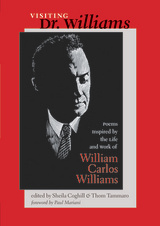 Visiting Dr. Williams: Poems Inspired by the Life and Work of William Carlos Williams
Sheila Coghill
University of Iowa Press, 2011 Loved for his decidedly American voice, for his painterly rendering of modern urban settings, and for his ability to re-imagine a living language shaped by the philosophy of “no ideas but in things,” William Carlos Williams (1883-1963) left an indelible mark on modern poetry. As each successive generation of poets discovers the “new” that lives within his work, his durability and expansiveness make him an influential poet for the twenty-first century as well. The one hundred and two poems by one hundred and two poets collected in Visiting Dr. Williams demonstrate the range of his influence in ways that permanently echo and amplify the transcendent music of his language.
Contributors include: Robert Creeley, David Wojahn, Maxine Kumin, James Laughlin, A. R. Ammons, Wendell Berry, Heid Erdrich, Frank O’Hara, Lyn Lifshin, Denise Levertov, Wallace Stevens, John Ashbery, Allen Ginsberg, and a host of others.
 Visiting Emily: Poems Inspired by the Life and Work of Emily Dickinson
Sheila Coghill
University of Iowa Press, 2000 This unique anthology gathers work by eighty poets inspired by Emily Dickinson. Beginning with Hart Crane's 1927 poem “To Emily Dickinson” and moving forward through the century to such luminary figures as Archibald MacLeish, John Berryman, Yvor Winters, Adrienne Rich, Richard Eberhart, Richard Wilbur, Maxine Kumin, Amy Clampitt, William Stafford, and Galway Kinnell, Visiting Emily offers both a celebration of and an homage to one of the world's great poets. If there was ever any doubt about Dickinson's influence on modern and contemporary poets, this remarkable collection surely puts it to rest. Gathered here are poems reflecting a wide range of voices, styles, and forms—poems written in traditional and experimental forms; poems whose tones are meditative, reflective, reverent and irreverent, satirical, whimsical, improvisational, and serious. Many of the poets draw from Dickinson's biography, while others imagine events from her life. Some poets borrow lines from Dickinson's poems or letters as triggers for their inspiration. Though most of the poems connect directly to Dickinson's life or work, for others the connection is more oblique.
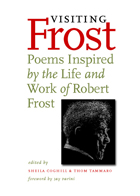 Visiting Frost: Poems Inspired by the Life and Work of Robert Frost
Sheila Coghill
University of Iowa Press, 2005 Like Emily Dickinson and Walt Whitman, Robert Frost looms large in the American literary landscape, straddling the 19th and 20th centuries like a poetic colossus: whosoever desires passage must, at some point, contend with the monolithic presence of Robert Frost. As they did in Visiting Emily and Visiting Walt, in Visiting Frost, Sheila Coghill and Thom Tammaro once again capture the conversations between contemporary poets and a legend whose voice endures. In his introduction to the collection, Frost biographer Jay Parini likens the poet to a “great power station, one who stands off by himself in the big woods, continuously generating electricity that future poets can tap into for the price of a volume of his poems.” A four-time Pulitzer Prize winner whose work is principally associated with the landscape and life in New England, Frost (1874-1963) was a traditional, psychologically complex, often dark and intense poet. In Visiting Frost, one hundred homage-paying poets--some who knew Frost, most only acquainted through his work--celebrate and reflect that intensity, in effect tapping into his electrical current. By reacting to specific Frost poems, by reinventing others, and by remembering aspects of Frost or by quarreling with him, the contributors speak on behalf of us whose lives have been brightened by the memorization and recitation of such poems as “The Road Not Taken” or “Stopping by Woods on a Snowy Evening.” As the poets pay tribute to Frost's place in American poetry and history, they suggest--more than forty years after his death--just how alive and vital he remains in our collective memory.
 Visiting Mackinac: 150 Years of Tourism at Michigan's Fabled Straits
Frank Boles
Michigan State University Press, 2025 The Straits of Mackinac have been a tourist destination for more than 150 years. The story of how tourism developed on Mackinac Island and in the adjacent communities of St. Ignace and Mackinaw City is brought to life in this fascinating book, with stories from the people who helped shape it. This complex work explores the factors that shaped this region into the tourist destination that it is today. It includes historical context of how conflicting ideas developed a seasonal tourist industry and examines how tourism at the Straits of Mackinac developed within regional and national contexts as the tourist industry boomed in the late nineteenth and twentieth centuries. This volume also shows how the people at the Straits responded to various national trends, such as when the automobile transformed the tourist experience and when independently published travel literature painted a less-than-rosy picture of the region.
Visiting Picasso
Jim Barnes
University of Illinois Press, 2006 Jim Barnes’s familiarity with the European poetic traditions has been deepened through long periods spent in France, Germany, and Italy, and through his translations of European poetry. In Visiting Picasso he repays Europe for its gifts to him in a series of poems that evoke the lush poetic history that ties European culture together, sometimes darkly. A heightened sense of place and purpose infuses the poems of Visiting Picasso with meaning drawn from actual landscapes, events, and observations.
Visiting Wallace: Poems Inspired by the Life and Work of Wallace Stevens
Dennis Barone
University of Iowa Press, 2009 The poetry of Wallace Stevens has inspired generations of poets of every school. Here, for the first time, is assembled an astonishing variety of poems, by a full range of poets, inspired by Stevens’s life and work. In its own way, each poem exhibits the torque and feel of his poetry, yet each also is deeply personal and conveys how meaningful Stevens was and remains for poets and poetry.
Whether whimsical or serious, solemn or light, the poems in Dennis Barone and James Finnegan’s Visiting Wallace are sure to inspire delight and thought. Alan Filreis’s brilliant foreword asks us to consider whether there is another modern poet who means as much to contemporary verse as Stevens: “seventy-six poems giving us seventy-six distinct Stevenses to follow and succeed.”
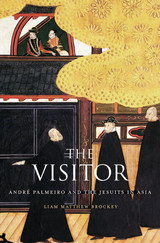 The Visitor: André Palmeiro and the Jesuits in Asia
Liam Matthew Brockey
Harvard University Press, 2014 In an age when few people ventured beyond their place of birth, André Palmeiro left Portugal on a journey to the far side of the world. Bearing the title “Father Visitor,” he was entrusted with the daunting task of inspecting Jesuit missions spanning from Mozambique to Japan. A global history in the guise of a biography, The Visitor tells the story of a theologian whose extraordinary travels bore witness to the fruitful contact—and violent collision—of East and West in the early modern era.
In India, Palmeiro was thrust into a controversy over the missionary tactics of Roberto Nobili, who insisted on dressing the part of an indigenous ascetic. Palmeiro walked across Southern India to inspect Nobili’s mission, recording fascinating observations along the way. As the highest-ranking Jesuit in India, he also coordinated missions to the Mughal Emperors and the Ethiopian Christians, as well as the first European explorations of the East African interior and the highlands of Tibet.
Orders from Rome sent Palmeiro farther afield in 1626, to Macau, where he oversaw Jesuit affairs in East Asia. He played a crucial role in creating missions in Vietnam and seized the opportunity to visit the Chinese mission, trekking thousands of miles to Beijing as one of China’s first Western tourists. When the Tokugawa Shogunate brutally cracked down on Christians in Japan—where neither he nor any Westerner had power to intervene—Palmeiro died from anxiety over the possibility that the last Jesuits still alive would apostatize under torture.
A Visitor's Guide to the University of Nevada, Reno Arboretum
James W. Hulse
University of Nevada Press, 2018 A Nevada State Arboretum, the University of Nevada, Reno campus is home to more than 3,000 trees representing more than 200 species and varieties. This attractive guidebook introduces readers to the university’s beautiful campus and its botanical treasures. Richly illustrated with both contemporary color and archival photos, this book captures the charm of the campus in all four seasons and shows how the grounds of the university have evolved over the years. Featuring 19 distinct tours around campus, a comprehensive map, and family-friendly interactive “tree hunts,” this guide showcases the campus' ecological diversity and interesting tree species and will appeal to first-time visitors as well as longtime residents.
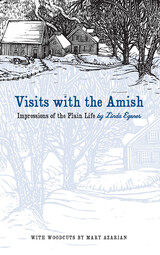 Visits with the Amish: Impressions of the Plain Life
Linda Egenes
University of Iowa Press, 2000 Who are the “plain people,” the men and women who till their fields with horse and plow, travel by horse and buggy, live without electricity and telephones, and practice “help thy neighbor” in daily life? Linda Egenes visited with her Old Order Amish neighbors in southeast Iowa for thirteen years before writing this informative and companionable introduction to their lifeways. Drawn to their slower pace of life and their resistance to the lures of a consumer society, Egenes found a warm welcome among the Amish, and in return she has given us an equally warm perspective on Amish family life as she experienced it. The Amish value harmony in family life above all, and Egenes found an abundance of harmony as she savored homemade ice cream in a kitchen where the refrigerator ran on kerosene, learned to milk a two-bucket cow, helped cook dinner for nine in a summer kitchen, spent the day in a one-room schoolhouse, and sang “The Hymn of Praise” in its original German at Sunday service. Whether quilting at a weekly sewing circle above the Stringtown Grocery, playing Dutch Blitz and Dare Base with schoolchildren, learning the intricacies of harness making, or mulching strawberries in a huge garden, Egenes was treated with the kindness, respect, and dignity that exemplify the strong community ties of the Amish. Her engaging account of her visits with the Amish, beautifully illustrated with woodcuts by Caldecott Medal winner Mary Azarian, reveals the serene and peaceful ways of a plain people whose lives are anything but plain.
 The Visoko Chronicle
Ivan Tavcar
Central European University Press, 2022 This historical novel—Visoška kronika in the Slovene original—is about two generations of the owners of the Visoko estate in the Duchy of Carniola, a predominantly Slovene province of the Habsburg Empire, in the seventeenth century. The events of the estate and the fate of its owners are affected by witchcraft persecutions, the mistreatment of Protestants, and the Thirty Years’ War. These themes are key to the construction of a Slovene national identity, which was going through a decisive phase as Tavčar was writing. By the time the novel was released in 1919, his nation had left the Habsburg Crown for the new Kingdom of Serbs, Croats, and Slovenes. The work is both romantic and realistic. The deeply romantic motive of crime, repentance, and punishment intertwines the lives of father and son. The very acquisition of the estate is connected to a murder, which casts a long shadow over the next generation. Tavčar insists on the principle of man’s full responsibility for his acts, which can be repaired with action and determination. The author’s bleak realistic description of the farm life at Visoko reflects his polemical view of the Slovene farmer of his time.
Visser 't Hooft, 1900-1985: Living for the Unity of the Church
Jurjen Zeilstra
Amsterdam University Press, 2020 God’s diplomat, the pope of the ecumenical movement, but also an acerbic theologian and a difficult person: this is how journalists characterised Willem Adolf Visser ’t Hooft (1900-1985). He was one of the best-known Dutch theologians outside the Netherlands and he left his mark on the world church. Even at an early age, he made profound efforts in support of international ecumenical youth and student organisations (Dutch Student Christian Movement, YMCA and World Student Christian Federation). He led the World Council of Churches during its formative stages (from 1938), and after its formal establishment in 1948 became its first general secretary, serving until 1966. To Visser ’t Hooft, the unity of the church was both an article of faith and a pragmatic organisation of church influence in a disunited world.
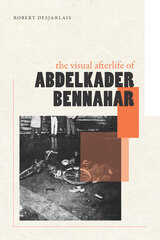 The Visual Afterlife of Abdelkader Bennahar
Robert Desjarlais
Duke University Press, 2025 On the night of October 17, 1961, thousands of Algerians peacefully demonstrated in the streets of Paris, protesting an illegal curfew imposed upon them by the French colonial government. The Paris police responded with deadly violence, by some accounts killing over two hundred people and wounding countless others. One of the victims was Abdelkader Bennahar, who was seriously beaten in Nanterre, a commune just west of Paris. Jewish-French photographer Élie Kagan took a number of photographs of Bennahar as he lay bleeding in the street. Bennahar was brought to a Nanterre hospital and reportedly died the next night. In The Visual Afterlife of Abdelkader Bennahar, Robert Desjarlais analyzes Kagan’s photographs and their affective force and political significance from the moment they first circulated through the decades that followed. By drawing on Kagan’s photographs and archival records to consider the trace remnants of Bennahar’s life and the fate of his body in death, Desjarlais offers a compelling account of one person’s “life death” through complicated strands of time and memory.
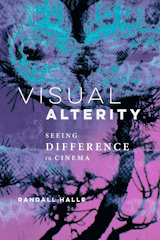 Visual Alterity: Seeing Difference in Cinema
Randall Halle
University of Illinois Press, 2021 Reconsidering the dynamics of perception Using cinema to explore the visual aspects of alterity, Randall Halle analyzes how we become cognizant of each other and how we perceive and judge another person in a visual field. Halle draws on insights from philosophy and recent developments in cognitive and neuroscience to argue that there is no pure "natural" sight. We always see in a particular way, from a particular vantage point, and through a specific apparatus, and Halle shows how human beings have used cinema to experiment with the apparatus of seeing for over a century. Visual alterity goes beyond seeing difference to being conscious of how one sees difference. Investigating the process allows us to move from mere perception to apperception, or conscious perception. Innovative and insightful, Visual Alterity merges film theory with philosophy and cutting-edge science to propose new ways of perceiving and knowing.
 Visual Archives of Sex
Heike Bauer, Melina Pappademos, Katie Sutton, and Jennifer Tucker, special issue editors
Duke University Press, 2021 Contributors to this special issue study the visual histories of sex by examining symbols, images, film, and other visual forms ranging from medieval religious icons to twenty-first-century selfies. They argue that engaging BIPOC, antiracist, queer, and feminist perspectives of the past is vital to understanding the complex historical relationships between sex and visual culture and how these relationships continue to shape sexual lives, bodies, myths, and desires. Essay topics include trans visual archives in Francoist Spain, a visual archive of British escort and nightclub hostess Ruth Ellis, pornography and queer pleasure in East Germany, swimsuit advertisements and “bikini blondes” in the age of the atom bomb, and teaching the history of sexuality with images. This issue also contains a roundtable on curating exhibitions devoted to sex and to queer and trans experience; conversations with historians, artists, and curators who study visual culture and the history of sexuality; and an exploration of the photographic archives of Carol Leigh, a.k.a. Scarlot Harlot.
Contributors. Heike Bauer, Roland Betancourt, Alexis L. Boylan, Topher Campbell, João Florêncio, Kyle Frackman, Javier Fernández Galeano, Sarah Jones, Carol Leigh, Conor McGrady, Ben Miller, Derek Conrad Murray, Lynda Nead, Melina Pappademos, Ashkan Sepahvand, David Serlin, Meg Slater, Katie Sutton, Annette F. Timm, Jennifer Tucker, Jeanne Vaccaro, Sunny Xiang
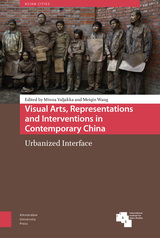 Visual Arts, Representations and Interventions in Contemporary China: Urbanized Interface
Edited by Minna Valjakka and Meiqin Wang
Amsterdam University Press, 2018 This edited volume provides a multifaceted investigation of the dynamic interrelations between visual arts and urbanization in contemporary Mainland China with a focus on unseen representations and urban interventions brought about by the transformations of the urban space and the various problems associated with it. Through a wide range of illuminating case studies, the authors demonstrate how innovative artistic and creative practices initiated by various stakeholders not only raise critical awareness on socio-political issues of Chinese urbanization but also actively reshape the urban living spaces. The formation of new collaborations, agencies, aesthetics and cultural production sites facilitate diverse forms of cultural activism as they challenge the dominant ways of interpreting social changes and encourage civic participation in the production of alternative meanings in and of the city. Their significance lies in their potential to question current values and power structures as well as to foster new subjectivities for disparate individuals and social groups.
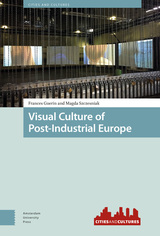 Visual Culture of Post-Industrial Europe
Frances Guerin
Amsterdam University Press, 2024 Visual Culture of Post-Industrial Europe investigates visual cultural projects in Europe from the 1970s onwards in response to industrial closures, resultant unemployment, diminished social services and shattered identities. Typically, art and visual cultural creations at one-time thriving European heartlands strive to make the industrial past visible, negotiable, and re-imaginable. Authors discuss varied and multiple types of art and visual culture that remember the sometimes-invisible past, create community in the face of social disintegration, and navigate the dissonance between past and present material reality. They also examine art and visual objects at post-industrial European sites for their aesthetic, historical, and sociological role within official and unofficial, government and community regeneration and re-vitalisation efforts. Sites range from former coal and steel plants in Duisburg, through shipyards and harbours of Gdansk and Hamburg, a Moscow paper factory and textile factories in Albania, to still-functioning Croatian metalworks.
Visual Cultures
Edited by James Elkins
Intellect Books, 2010 Visual Cultures is the first study of the place of visuality and literacy in specific nations around the world, featuring authoritative, insightful essays on the value accorded to the visual and the verbal in Japan, Poland, China, Russia, Ireland, and Slovenia. Focusing on the national instead of the global, distinguished art critic James Elkins offers a critique of general histories of visuality, such as those of Martin Jay or Jean Baudrillard, as well as a critique of local histories of visuality, as in Third Text and other postcolonial studies. The content is not only analytic, but also historical, tracing changes in the significance of visual and verbal literacy in each nation. Visual Cultures also explores questions of national identity and the many issues Elkins raises suggest a wealth of promising avenues for future research.
 Visual Cultures of Japanese Imperialism, Volume 8
Gennifer Weisenfeld, ed.
Duke University Press Under pressure of cultural colonization from the West and expanding an imperialist force and cultural colonizer within Asia, Japan occupied a unique space on the international landscape in the years from the beginning of the Meiji Period to the Pacific War. This special issue of positions examines the integral role that visual culture played both in representing and constituting this imperial reality. The articles, contributed by scholars in the fields of art history, cultural history, and Japanese literature, address the interactions between Japan, the West, and the rest of Asia. Costumes, architecture, tourism propaganda, pottery, and a host of other sources provide the raw materials for Visual Cultures of Japanese Imperialism, and the incisive essays built from these sources will change readers’ understanding of the visual culture(s) of imperialism. Contributors. Kim Brandt, Leo Ching, Carol Ann Christ, Christine Guth, Jordan Sand, Gennifer Weisenfeld, Cherie Wendelken
 Visual Disobedience: Art and Decoloniality in Central America
Kency Cornejo
Duke University Press, 2024 In Visual Disobedience, Kency Cornejo traces the emergence of new artistic strategies for Indigenous, feminist, and anticarceral resistance in the wake of torture, disappearance, killings, and US-funded civil wars in Central America. Cornejo reveals a direct line from US intervention to current forms of racial, economic, and gender injustice in the isthmus, connecting this to the criminalization and incarceration of migrants at the US-Mexico border today. Drawing on interviews with Central American artists and curators, she theorizes a form of “visual disobedience” in which art operates in opposition to nation-states, colonialism, and visual coloniality. She counters historical erasure by examining over eighty artworks and highlighting forty artists across the region. Cornejo also rejects the normalized image of the suffering Central American individual by repositioning artists as creative agents of their own realities. With this comprehensive exploration of contemporary Central American art, Cornejo highlights the role of visual disobedience as a strategy of decolonial aesthetics to expose and combat coloniality, heteropatriarchy, white supremacy, empire, and other systems of oppression.
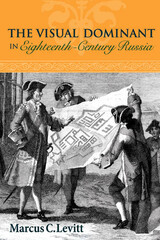 The Visual Dominant in Eighteenth-Century Russia
Marcus C. Levitt
Northern Illinois University Press, 2011
The Enlightenment privileged vision as the principle means of understanding
the world, but the eighteenth-century Russian preoccupation
with sight was not merely a Western import. In his masterful study,
Levitt shows the visual to have had deep indigenous roots in Russian
Orthodox culture and theology, arguing that the visual played a crucial
role in the formation of early modern Russian culture and identity.
Levitt traces the early modern Russian quest for visibility from jubilant
self-discovery, to serious reflexivity, to anxiety and crisis. The book
examines verbal constructs of sight—in poetry, drama, philosophy,
theology, essay, memoir—that provide evidence for understanding the
special character of vision of the epoch. Levitt’s groundbreaking work
represents both a new reading of various central and lesser known texts
and a broader revisualization of Russian eighteenth-century culture.
Works that have considered the intersections of Russian literature and
the visual in recent years have dealt almost exclusively with the modern
period or with icons. The Visual Dominant in Eighteenth-Century Russia
is an important addition to the scholarship and will be of major interest
to scholars and students of Russian literature, culture, and religion, and
specialists on the Enlightenment.
The Visual Elements Landscapes
John A. Jakle
University of Massachusetts Press, 1987 An examination of how visual and aesthetic dimensions amplify the functional interpretation of cultural landscape.
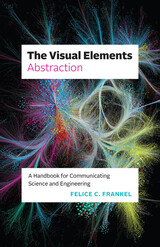 The Visual Elements—Abstraction: A Handbook for Communicating Science and Engineering
Felice C. Frankel
University of Chicago Press For anyone interested in visual communication, a training guide for evaluating and developing visual metaphors for the big ideas in science and technology, an essential skill for journal submissions, grant applications, and public understanding.
As a scientist, engineer, or other researcher, you may have written an abstract. In a paragraph, you explain the purpose of your research, your approach, the questions you have asked and answered, and your work’s impact. The abstract is a summary and an invitation—to read the paper, attend your talk, and join you in your thinking. You may even have been asked to create a visual abstract—a single image—to achieve the same goals. As a designer or public information officer, you may have had a similar brief—to explain a compelling subject with a visual for a journal cover or press release. And yet, this important skill—devising visual metaphors—isn’t typically taught. With her decades of experience creating compelling images and instructing MIT researchers, award-winning photographer and science communicator Felice C. Frankel helps readers evaluate and create their own visual abstractions.
Like in her other books in the Visual Elements series, on photography and design, Frankel asks readers to evaluate different choices—for example, in conveying the uncertainty of a hurricane’s path or the organization of the Standard Model for elementary particles. But in Abstraction, she offers more. With examples from science, engineering, and beyond, the book helps readers consider and evaluate the visuals around them and determine how they work and when they fail. Is this representation the best for communication? Will these abstractions continue to invite others to think more deeply about my research? Will they mislead? Will they help my ideas evolve? Frankel invites researchers to think about the many meanings behind their images—and, in turn, more deeply about their research.
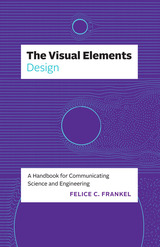 The Visual Elements—Design: A Handbook for Communicating Science and Engineering
Felice C. Frankel
University of Chicago Press, 2024 With insights and examples from designers at publications from Nature to the New York Times, an essential guide to creating figures and presentations.
In this short handbook, award-winning science communicator Felice C. Frankel offers a quick guide for scientists and engineers who want to share—and better understand—their research by designing compelling graphics for journal submissions, grant applications, presentations, and posters. Like all the books in the Visual Elements series, this handbook is also a training tool for researchers. Distilling her celebrated books and courses to the essentials, Frankel shows scientists and engineers, from students to primary investigators, the importance of thinking visually. This crucial volume in the Visual Elements series offers a wealth of engaging design examples. Case studies and advice from designers at prestigious publications and researchers’ own before-and-after examples show how even the smallest changes—to color, type, composition, and layering—can greatly improve communication. Ideal for researchers who want a foothold for presenting and preparing their work for everything from conferences to publications, the book explains the steps for creating a concise and communicative graphic to highlight the most important aspects of research—and to clarify researchers’ own thinking. The resulting book is an essential element of any scientist’s, engineer’s, or designer’s library.
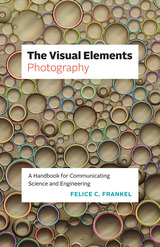 The Visual Elements—Photography: A Handbook for Communicating Science and Engineering
Felice C. Frankel
University of Chicago Press, 2023 For novice or pro, primary investigator or postdoc, the essentials for photographing science and technology for journals, grant applications, and public understanding.
Award-winning photographer Felice C. Frankel, whose work has graced the covers of Science, Nature, and Scientific American, among other publications, offers a quick guide for scientists and engineers who want to communicate—and better understand—their research by creating compelling photographs. Like all the books in the Visual Elements series, this short guide uses engaging examples to train researchers to learn visual communication. Distilling her celebrated books and courses to the essentials, Frankel shows scientists and engineers the importance of thinking visually. When she creates stunning images of scientific phenomena, she is not only interested in helping researchers to convey understanding to others in their research community or to gain media attention, but also in making these experts themselves “look longer” to understand more fully. Ideal for researchers who want a foothold for presenting and preparing their work for conferences, journal publications, and funding agencies, the book explains four tools that all readers can use—a phone, a camera, a scanner, and a microscope—and then offers important advice on composition and image manipulation ethics. The Visual Elements—Photography is an essential element in any scientist’s, engineer’s, or photographer’s library.
Visual Encounters in the Study of Rural Childhoods
Mandrona, April R.
Rutgers University Press, 2018 Visual Encounters in the Study of Rural Childhoods brings together visual studies and childhood studies to explore images of childhood in the study of rurality and rural life. The volume highlights how the voices of children themselves remain central to investigations of rural childhoods. Contributions look at representations and experiences of rural childhoods from both the Global North and Global South (including U.S., Canada, Haiti, India, Sweden, Slovenia, South Africa, Russia, Timor-Leste, and Colombia) and consider visuals ranging from picture books to cell phone video to television.
 Visual Futures: Exploring the Past, Present, and Divergent Possibilities of Visual Practice
Edited by Tracey Bowen and Brett Caraway
Intellect Books, 2021 A collection of thoughtful and incisive examinations of how we interact and engage with the visual elements of our environments.
In our everyday lives, we navigate a vast sea of visual imagery. Yet we rarely consider systematically how or why we derive meaning from this sea of the visual. Nor do we typically contemplate the effect it has on our motivations and actions as individuals and collectives. Visual Futures provides a new lens through which to analyze and challenge established perspectives, norms, and practices surrounding the visual.
This edited collection ruminates on how visuality and the visual provoke a new kind of cultural exchange and explores the relationships, intersections, and collisions between visuality and visual practices and one (or a combination) of the following: embodiment, spatial literacy, emerging languages, historical reflection, educative practices, civic development, and social development.
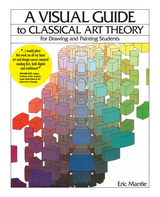 A Visual Guide to Classical Art Theory for Drawing and Painting Students
Mantle, Eric
Parkhurst Brothers, Inc., 2009 Eric Mantle presents the basics of classical theory in a clear and concise manner for all beginning drawing and painting students. His book features diagrams that illustrate every concept. Students will see the complexities of color theory and understand how to create the illusion of volume and depth on a 2-dimensional surface. “As an art student,” Professor Mantle recalls, “I was frequently frustrated by instructional books that gave lengthy verbal descriptions of visual concepts and then showed small and/or unclear diagrams of those concepts. As an art teacher, I found that my students would gain a clearer understanding of a visual concept if my verbal explanation was combined with a diagram of that concept.” A Visual Guide to Classical Art Theory is great for both traditional and non-traditional media. Each page, theory and diagram represents a different tool for the artist to use. Through their use, the artist will find an infinite number of solutions. Artists also may use the book to create a trompe-l’oeil effect in graffiti art or the illusion of volume and depth on the computer. A Visual Guide to Art Theory is presented in a unique, non-verbal format that clearly illustrates the effect of perspective on color, light and shade.
Visual Histories from Medieval Iberia: Arts and Ambivalence
Jerrilynn Dodds
Arc Humanities Press, 2024
This volume challenges popular assumptions and academic pieties regarding religion and identity on the Iberian Peninsula during the Middle Ages. Its studies of individual works of art and architecture uncoil complex histories from this religiously plural peninsula, intertwining social, cultural, and political identities across seven centuries. Chronicling relationships between religious groups that were neither idyllic nor irreconcilable, these works of art reveal instead expressions of religious separateness balanced within ambivalent and dynamic shared visual identities.
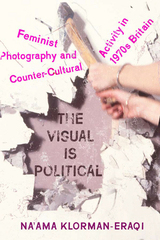 The Visual Is Political: Feminist Photography and Countercultural Activity in 1970s Britain
Na'ama Klorman-Eraqi
Rutgers University Press, 2019 The Visual is Political examines the growth of feminist photography as it unfolded in Britain during the 1970s and 1980s. This period in Britain was marked by instability following the collapse of the welfare state, massive unemployment, race riots, and workers’ strikes. However, this was also a time in which various forms of social activism emerged or solidified, including the Women’s Movement, whose members increasingly turned to photography as a tool for their political activism. Rather than focusing on the aesthetic quality of the images produced, Klorman-Eraqi looks at the application of feminist theory, photojournalism, advertising, photo montage, punk subculture and aesthetics, and politicized street activity to emphasize the statement and challenge that the photographic language of these works posed. She shows both the utilitarian uses of photography in activism, but also how these same photographers went on to be accepted (or co-opted) into the mainstream art spaces little by little, sometimes with great controversy. The Visual is Political highlights the relevance and impact of an earlier contentious, creative, and politicized moment of feminism and photography as art and activism.
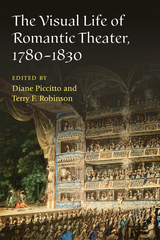 The Visual Life of Romantic Theater, 1780-1830
Edited by Diane Piccitto and Terry F. Robinson
University of Michigan Press, 2023 The Visual Life of Romantic Theater examines the dynamism and vibrancy of stage spectacle and its impact in an era of momentous social upheaval and aesthetic change. Situating theatrical production as key to understanding visuality ca. 1780-1830, this book places the stage front and center in Romantic scholarship—a field in a period long defined by its focus on poetry—by reenvisioning traditional approaches to artistic and social production. How, it asks, did dramaturgy and stagecraft influence aesthetic and sociopolitical concerns? How does a focus on visuality expand our understanding of the historical experience of theatergoing? In what ways did stage performance converge with visual culture beyond the theater? How did extra-theatrical genres engage with theatrical sight and spectacle? Finally, how does a focus on dramatic vision change the way we conceive of Romanticism itself? The volume’s essays by emerging and established scholars provide exciting and suggestive answers to these questions, along with a more capacious conception of Romantic theater as a locus of visual culture that reached well beyond playhouse walls.
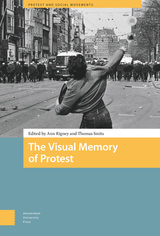 The Visual Memory of Protest
Ann Rigney
Amsterdam University Press, 2023 Social movements are not only remembered in personal experience, but also through cultural carriers that shape how later movements see themselves and are seen by others. The present collection zooms in on the role of photography in this memory-activism nexus. How do iconographic conventions shape images of protest? Why do some images keep movements in the public eye, while others are quickly forgotten? What role do images play in linking different protests, movements, and generations of activists? Have the affordances of digital media made it easier for activists to use images in their memory politics, or has the digital production and massive online exchange of images made it harder to identify and remember a movement via a single powerful image? Bringing together experts in visual culture, cultural memory, social movements, and digital humanities, this collection presents new empirical, theoretical, and methodological insights into the visual memory of protest.
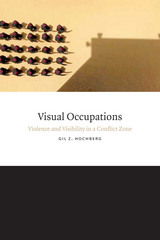 Visual Occupations: Violence and Visibility in a Conflict Zone
Gil Z. Hochberg
Duke University Press, 2015 In Visual Occupations Gil Z. Hochberg shows how the Israeli Occupation of Palestine is driven by the unequal access to visual rights, or the right to control what can be seen, how, and from which position. Israel maintains this unequal balance by erasing the history and denying the existence of Palestinians, and by carefully concealing its own militarization. Israeli surveillance of Palestinians, combined with the militarized gaze of Israeli soldiers at places like roadside checkpoints, also serve as tools of dominance. Hochberg analyzes various works by Palestinian and Israeli artists, among them Elia Suleiman, Rula Halawani, Sharif Waked, Ari Folman, and Larry Abramson, whose films, art, and photography challenge the inequity of visual rights by altering, queering, and manipulating dominant modes of representing the conflict. These artists' creation of new ways of seeing—such as the refusal of Palestinian filmmakers and photographers to show Palestinian suffering or the Israeli artists' exposure of state manipulated Israeli blindness —offers a crucial gateway, Hochberg suggests, for overcoming and undoing Israel's militarized dominance and political oppression of Palestinians.
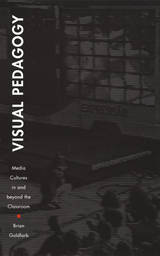 Visual Pedagogy: Media Cultures in and beyond the Classroom
Brian Goldfarb
Duke University Press, 2002 In classrooms, museums, health clinics and beyond, the educational uses of visual media have proliferated over the past fifty years. Film, video, television, and digital media have been integral to the development of new pedagogical theories and practices, globalization processes, and identity and community formation. Yet, Brian Goldfarb argues, the educational roles of visual technologies have not been fully understood or appreciated. He contends that in order to understand the intersections of new media and learning, we need to recognize the sweeping scope of the technologically infused visual pedagogy—both in and outside the classroom. From Samoa to the United States mainland to Africa and Brazil, from museums to city streets, Visual Pedagogy explores the educational applications of visual media in different institutional settings during the past half century. Looking beyond the popular media texts and mainstream classroom technologies that are the objects of most analyses of media and education, Goldfarb encourages readers to see a range of media subcultures as pedagogical tools. The projects he analyzes include media produced by AIDS/HIV advocacy groups and social services agencies for classroom use in the 1990s; documentary and fictional cinemas of West Africa used by the French government and then by those resisting it; museum exhibitions; and TV Anhembi, a municipally sponsored collaboration between the television industry and community-based videographers in São Paolo, Brazil. Combining media studies, pedagogical theory, and art history, and including an appendix of visual media resources and ideas about the most productive ways to utilize visual technologies for educational purposes, Visual Pedagogy will be useful to educators, administrators, and activists.
Visual Research Methods in Architecture
Edited by Igea Troiani and Suzanne Ewing
Intellect Books, 2020 This book offers a distinctive approach to the use of visual methodologies for qualitative architectural research. It presents a diverse selection of ways for the architect or architectural researcher to use their gaze as part of their research practice for the purpose of visual literacy. Its contributors explore and use, “critical visualizations,” which employ observation and socio-cultural critique through visual creations—texts, drawings, diagrams, paintings, visual texts, photography, film, and their hybrid forms—to research architecture, landscape design, and interior architecture. The visual methods intersect with those used in ethnography, anthropology, visual culture, and media studies. In presenting a range of interdisciplinary approaches, Visual Research Methods in Architecture opens up territory for new forms of visual architectural scholarship.
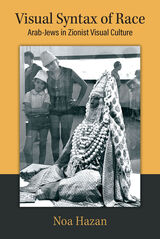 Visual Syntax of Race: Arab-Jews in Zionist Visual Culture
Noa Hazan
University of Michigan Press, 2022 Analyzing the visual syntax and display rhetoric applied in newspaper photos, national historical albums, and museum exhibitions, Noa Hazan shows that although racial thought was and still is verbally suppressed in Israel, it is vividly present in its nonverbal official and public visual sphere. The racist perspective of newspaper editors, book publishers, photographers, and museum curators were morally justified in its time by such patronizing ideals as realistic news coverage or the salvation of Jewish heritage assets. Although their perspectives played a dominant role in establishing a visual syntax of race in Israel, they were not seen as racially discriminating at the time. The racist motifs and actions are revealed here by colligating multiple cases into a coherent narrative in retrospect.
This book points to a direct influence of the anti-Semitic discourse in Europe toward Mizrahim in Israel, highlighting the shared visual stereotypes used in both Europe and the fledgling state of Israel. Engraved in their body, these cultural traits were depicted and understood as racial-biological qualities and were visually manipulated to silo Ashkenazim and Mizrahim in Israel as distinct racial types.
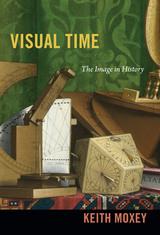 Visual Time: The Image in History
Keith Moxey
Duke University Press, 2013 Visual Time offers a rare consideration of the idea of time in art history. Non-Western art histories currently have an unprecedented prominence in the discipline. To what extent are their artistic narratives commensurate with those told about Western art? Does time run at the same speed in all places? Keith Moxey argues that the discipline of art history has been too attached to interpreting works of art based on a teleological categorization—demonstrating how each work influences the next as part of a linear sequence—which he sees as tied to Western notions of modernity. In contrast, he emphasizes how the experience of viewing art creates its own aesthetic time, where the viewer is entranced by the work itself rather than what it represents about the historical moment when it was created. Moxey discusses the art, and writing about the art, of modern and contemporary artists, such as Gerard Sekoto, Thomas Demand, Hiroshi Sugimoto, and Cindy Sherman, as well as the sixteenth-century figures Pieter Bruegel the Elder, Albrecht Dürer, Matthias Grünewald, and Hans Holbein. In the process, he addresses the phenomenological turn in the study of the image, its application to the understanding of particular artists, the ways verisimilitude eludes time in both the past and the present, and the role of time in nationalist accounts of the past.
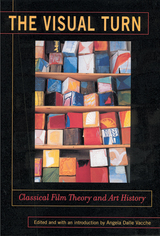 The Visual Turn: Classical Film Theory and Art History
Dalle Vacche, Angela
Rutgers University Press, 2002
A collection of cutting-edge articles that demonstrate an implicit dialogue between art historians and film specialists.
The Visual Turn is a cutting-edge dialogue between art historians and film theorists from the silent period to the aftermath of World War II. Its aim is to broaden the horizons of film studies, while making students of art history more comfortable when they approach the key texts of classical film theory.
Through pairings of articles, The Visual Turn demonstrates that an implicit dialogue between art historians and film specialists has enriched both fields for decades. By combining original essays, reprints, and translations from French and Italian, The Visual Turn makes this little-known dialogue between two disciplines speak about such rich issues as: iconophobia, iconophilia, and iconoclasm; haptic and optical images; cognitivism and aesthetics; visual form, history, and technology.
The Visual World of the Hungarian Angevin Legendary
Béla Zsolt Szakács
Central European University Press, 2016 Dispersed in two continents, four countries and six collections; many of its pages were cropped, cut into four, or lost forever; its history, origin, commissioner and audience are obscure; still, in its fragmented state it presents fifty-eight legends in abundant series of images, on folios fully covered by miniatures, richly gilded, using only one side of the fine parchment; a luxurious codex worthy of a ruler; a unique iconographic treasury of medieval legends; one of the most significant manuscripts of the medieval Hungarian Kingdom – these are all what we call the Hungarian Angevin Legendary.
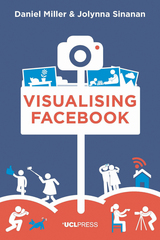 Visualising Facebook: A Comparative Perspective
Daniel Miller and Jolynna Sinanan
University College London, 2017 Since the growth of social media, human communication has become much more visual. This book presents a scholarly analysis of the images people post on a regular basis to Facebook. By including hundreds of examples, readers can see for themselves the differences between postings from a village north of London, and those from a small town in Trinidad. Why do women respond so differently to becoming a mother in England from the way they do in Trinidad? How are values such as carnival and suburbia expressed visually? Based on an examination of over 20,000 images, the authors argue that phenomena such as selfies and memes must be analysed in their local context. The book aims to highlight the importance of visual images today in patrolling and controlling the moral values of populations, and explores the changing role of photography from that of recording and representation, to that of communication, where an image not only documents an experience but also enhances it, making the moment itself more exciting.
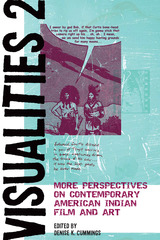 Visualities 2: More Perspectives on Contemporary American Indian Film and Art
Denise K. Cummings
Michigan State University Press, 2019 Echoing and expanding the aims of the first volume, Visualities: Perspectives on Contemporary American Indian Film and Art, this second volume contains illuminating global Indigenous visualities concerning First Nations, Aboriginal Australian, Maori, and Sami peoples. This insightful collection of essays explores how identity is created and communicated through Indigenous film-, video-, and art-making; what role these practices play in contemporary cultural revitalization; and how indigenous creators revisit media pasts and resignify dominant discourses through their work. Taking an interdisciplinary approach, Visualities Two draws on American Indian studies, film studies, art history, cultural studies, visual culture studies, women’s studies, and postcolonial studies. Among the artists and media makers examined are Tasha Hubbard, Rachel Perkins, and Ehren “Bear Witness” Thomas, as well as contemporary Inuit artists and Indigenous agents of cultural production working to reimagine digital and social platforms. Films analyzed include The Exiles, Winter in the Blood, The Spirit of Annie Mae, Radiance, One Night the Moon, Bran Nue Dae, Ngati, Shimásání, and Sami Blood.
 Visualities: Perspectives on Contemporary American Indian Film and Art
Denise K. Cummings
Michigan State University Press, 2011 In recent years, works by American Indian artists and filmmakers such as Jaune Quick-To-See Smith, Edgar Heap of Birds, Sherman Alexie, Shelley Niro, and Chris Eyre have illustrated the importance of visual culture as a means to mediate identity in contemporary Native America. This insightful collection of essays explores how identity is created and communicated through Native film-, video-, and art-making; what role these practices play in contemporary cultural revitalization; and how indigenous creators revisit media pasts and resignify dominant discourses through their work. Taking an interdisciplinary approach, Visualities: Perspectives on Contemporary American Indian Film and Art draws on American Indian Studies, American Studies, Film Studies, Cultural Studies, Women’s Studies, and Postcolonial Studies. Among the artists examined are Hulleah J. Tsinhnahjinnie, Eric Gansworth, Melanie Printup Hope, Jolene Rickard, and George Longfish. Films analyzed include Imprint, It Starts with a Whisper, Mohawk Girls, Skins, The Business of Fancydancing, and a selection of Native Latin films.
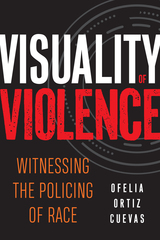 Visuality of Violence: Witnessing the Policing of Race
Ofelia Ortiz Cuevas
Temple University Press, 2025 Visuality of Violence unpacks the way visual documentations and depictions of the practice of racial violence are used in imperialism, capitalism, and neoliberalism in the United States. Ofelia Ortiz Cuevas traces the continuity of racial value through the shifting narratives of race by examining the long-running TV series, COPS, and the museum exhibition, Without Sanctuary, which features photographs of lynching. These case studies provide an innovative holistic mapping of the policing and incarceration of Black and Brown people.
Addressing the frequently ignored experiences of Asian and Native Americans, among others, in its comparative undertaking, Visuality of Violence exceeds intersectional mapping to uniquely charge the spectacle of racial violence as a foundational practice in its continued presence in contemporary society. Cuevas argues that the visual presentations of the racial body throughout history requires a reckoning and acknowledgement of the material and legal effects of the images, narratives, and practices used to maintain hegemonic racial order and inequality.
In holding a theoretical mirror to history, Visuality of Violence reveals liberal mythical reliance on the ideals of western law and its rationalities as the location of justice and freedom, thereby presenting its readers with a new understanding in the quest for peace and liberation.
In the series Critical Race, Indigeneity, and Relationality
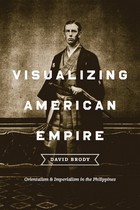 Visualizing American Empire: Orientalism and Imperialism in the Philippines
David Brody
University of Chicago Press, 2010 In 1899 an American could open a newspaper and find outrageous images, such as an American soldier being injected with leprosy by Filipino insurgents. These kinds of hyperbolic accounts, David Brody argues in this illuminating book, were just one element of the visual and material culture that played an integral role in debates about empire in late nineteenth- and early twentieth-century America.
Visualizing American Empire explores the ways visual imagery and design shaped the political and cultural landscape. Drawing on a myriad of sources—including photographs, tattoos, the decorative arts, the popular press, maps, parades, and material from world’s fairs and urban planners—Brody offers a distinctive perspective on American imperialism. Exploring the period leading up to the Spanish-American War, as well as beyond it, Brody argues that the way Americans visualized the Orient greatly influenced the fantasies of colonial domestication that would play out in the Philippines. Throughout, Brody insightfully examines visual culture’s integral role in the machinery that runs the colonial engine. The result is essential reading for anyone interested in the history of the United States, art, design, or empire.
 Visualizing Anthropology: Experimenting with Image-Based Ethnography
Edited by Anna Grimshaw and Amanda Ravetz
Intellect Books, 1995
Questions of vision and knowledge are central to debates about the world in which we live. Developing new analytical approaches toward ways of seeing is a key challenge facing those working across a wide range of disciplines. How can visuality be understood on its own terms rather than by means of established textual frameworks? Visualizing Anthropology takes up this challenge. Bringing together a range of perspectives anchored in practice, the book maps experiments in the forms and techniques of visual enquiry.
The origins of this collection lie in visual anthropology. Although the field has greatly expanded and diversified, many of the key debates continue to be focused around the textual concerns of the mainstream discipline. In seeking to establish a more genuinely visual anthropology, the editors have sought to forge links with other kinds of image-based projects. Ethnography is the shared space of practice. Understood not as a specialized method but as cultural critique, the book explores new collaborative possibilities linked to image-based work.
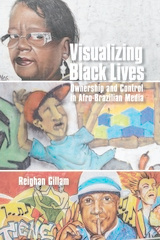 Visualizing Black Lives: Ownership and Control in Afro-Brazilian Media
Reighan Gillam
University of Illinois Press, 2022 A new generation of Afro-Brazilian media producers have emerged to challenge a mainstream that frequently excludes them. Reighan Gillam delves into the dynamic alternative media landscape developed by Afro-Brazilians in the twenty-first century. With works that confront racism and focus on Black characters, these artists and the visual media they create identify, challenge, or break with entrenched racist practices, ideologies, and structures. Gillam looks at a cross-section of media to show the ways Afro-Brazilians assert control over various means of representation in order to present a complex Black humanity. These images--so at odds with the mainstream--contribute to an anti-racist visual politics fighting to change how Brazilian media depicts Black people while highlighting the importance of media in the movement for Black inclusion. An eye-opening union of analysis and fieldwork, Visualizing Black Lives examines the alternative and activist Black media and the people creating it in today's Brazil.
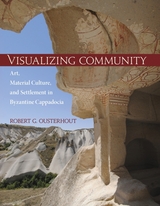 Visualizing Community: Art, Material Culture, and Settlement in Byzantine Cappadocia
Robert G. Ousterhout
Harvard University Press Cappadocia, a picturesque volcanic region of central Anatolia, preserves the best evidence of daily life in the Byzantine Empire and yet remains remarkably understudied, better known to tourists than to scholars. The area preserves an abundance of physical remains: at least a thousand rock-cut churches or chapels, of which more than one-third retain significant elements of their painted decoration, as well as monasteries, houses, entire towns and villages, underground refuges, agricultural installations, storage facilities, hydrological interventions, and countless other examples of non-ecclesiastical architecture. In dramatic contrast to its dearth of textual evidence, Cappadocia is unrivaled in the Byzantine world for its material culture.
Based upon the close analysis of material and visual residues, Visualizing Community offers a critical reassessment of the story and historiography of Byzantine Cappadocia, with chapters devoted to its architecture and painting, as well as to its secular and spiritual landscapes. In the absence of a written record, it may never be possible to write a traditional history of the region, but, as Robert Ousterhout shows, it is possible to visualize the kinds of communities that once formed the living landscape of Cappadocia.
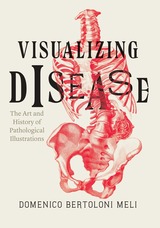 Visualizing Disease: The Art and History of Pathological Illustrations
Domenico Bertoloni Meli
University of Chicago Press, 2018 Visual anatomy books have been a staple of medical practice and study since the mid-sixteenth century. But the visual representation of diseased states followed a very different pattern from anatomy, one we are only now beginning to investigate and understand. With Visualizing Disease, Domenico Bertoloni Meli explores key questions in this domain, opening a new field of inquiry based on the analysis of a rich body of arresting and intellectually challenging images reproduced here both in black and white and in color.
Starting in the Renaissance, Bertoloni Meli delves into the wide range of figures involved in the early study and representation of disease, including not just men of medicine, like anatomists, physicians, surgeons, and pathologists, but also draftsmen and engravers. Pathological preparations proved difficult to preserve and represent, and as Bertoloni Meli takes us through a number of different cases from the Renaissance to the mid-nineteenth century, we gain a new understanding of how knowledge of disease, interactions among medical men and artists, and changes in the technologies of preservation and representation of specimens interacted to slowly bring illustration into the medical world.
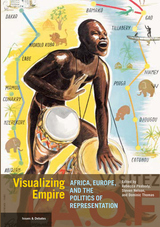 Visualizing Empire: Africa, Europe, and the Politics of Representation
Rebecca Peabody
J. Paul Getty Trust, The, 2021 An exploration of how an official French visual culture normalized France’s colonial project and exposed citizens and subjects to racialized ideas of life in the empire. By the end of World War I, having fortified its colonial holdings in the Caribbean, Latin America, Africa, the Indian Ocean, and Asia, France had expanded its dominion to the four corners of the earth. This volume examines how an official French visual culture normalized the country’s colonial project and exposed citizens and subjects alike to racialized ideas of life in the empire. Essays analyze aspects of colonialism through investigations into the art, popular literature, material culture, film, and exhibitions that represented, celebrated, or were created for France’s colonies across the seas.
These studies draw from the rich documents and media—photographs, albums, postcards, maps, posters, advertisements, and children’s games—related to the nineteenth- and twentieth-century French empire that are held in the Getty Research Institute’s Association Connaissance de l’histoire de l’Afrique contemporaine (ACHAC) collections. ACHAC is a consortium of scholars and researchers devoted to exploring and promoting discussions of race, iconography, and the colonial and postcolonial periods of Africa and Europe.
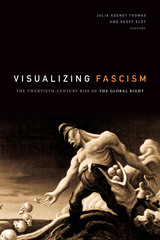 Visualizing Fascism: The Twentieth-Century Rise of the Global Right
Julia Adeney Thomas and Geoff Eley, editors
Duke University Press, 2020 Visualizing Fascism argues that fascism was not merely a domestic menace in a few European nations, but arose as a genuinely global phenomenon in the early twentieth century. Contributors use visual materials to explore fascism's populist appeal in settings around the world, including China, Japan, South Africa, Slovakia, and Spain. This visual strategy allows readers to see the transnational rise of the right as it fed off the agitated energies of modernity and mobilized shared political and aesthetic tropes. This volume also considers the postwar aftermath as antifascist art forms were depoliticized and repurposed in the West. More commonly, analyses of fascism focus on Italy and Germany alone and on institutions like fascist parties, but that approach truncates our understanding of the way fascism was indebted to colonialism and internationalism with all their attendant grievances and aspirations. Using photography, graphic arts, architecture, monuments, and film—rather than written documents alone—produces a portable concept of fascism, useful for grappling with the upsurge of the global right a century ago—and today.
Contributors. Nadya Bair, Paul D. Barclay, Ruth Ben-Ghiat, Maggie Clinton, Geoff Eley, Lutz Koepnick, Ethan Mark, Bertrand Metton, Lorena Rizzo, Julia Adeney Thomas, Claire Zimmerman
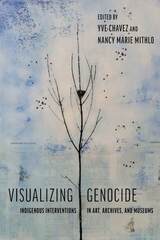 Visualizing Genocide: Indigenous Interventions in Art, Archives, and Museums
Edited by Yve Chavez and Nancy Marie Mithlo; Foreword by Charlene Villaseñor Black
University of Arizona Press, 2022 Visualizing Genocide examines how creative arts and memory institutions selectively commemorate or often outright ignore stark histories of colonialism. The essays confront outdated narratives and institutional methods by investigating contemporary artistic and scholarly interventions documenting settler colonialisms including land theft, incarceration, intergenerational trauma, and genocide. Interdisciplinary approaches, including oral histories, exhibition practices, artistic critiques, archival investigations, and public arts, are among the many decolonizing methods incorporated in contemporary curatorial practices.
Rather than dwelling simply in celebratory appraisals of Indigenous survival, this unprecedented volume tracks how massacres, disease, removals, abrogated treaties, religious intolerance, theft of land, and relocation are conceived by contemporary academics and artists. Contributors address indigeneity in the United States, Norway, Canada, Australia, and the Caribbean in scholarly essays, poems, and artist narratives. Missions, cemeteries, archives, exhibitions, photography, printmaking, painting, installations, performance, music, and museums are documented by fourteen authors from a variety of disciplines and illustrated with forty-three original artworks.
The authors offer honest critique, but in so doing they give hopeful and concrete strategies for the future. This powerful collection of voices employs Indigenous epistemologies and decolonial strategies, providing essential perspectives on art and visual culture.
Contributors
T. Christopher Aplin
Emily Arthur
Marwin Begaye
Charlene Villaseñor Black
Yve Chavez
Iris Colburn
Ellen Fernandez-Sacco
Stephen Gilchrist
John Hitchcock
Michelle J. Lanteri
Jérémie McGowan
Nancy Marie Mithlo
Anne May Olli
Emily Voelker
Richard Ray Whitman
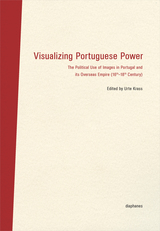 Visualizing Portuguese Power: The Political Use of Images in Portugal and its Overseas Empire (16th-18th Century)
Edited by Urte Krass
Diaphanes, 2015 Images play a key role in political communication and the ways we come to understand the power structures that shape society. Nowhere is this more evident than in the process of empire building, in which visual language has long been a highly effective means of overpowering another culture with one’s own values and beliefs.
With Visualizing Portuguese Power, Urte Krass and a group of contributors examine the visual arts within the Portuguese empire between the sixteenth and eighteenth centuries. With a focus on the political appropriation of Portuguese-Christian art within the colonies, the book looks at how these and other objects could be staged to generate new layers of meaning. Beyond religious images, the book shows that the appropriation of the visual arts to reinforce important political concepts also took place in the outside the religious sphere, including adaptations of local artistic customs to reinforce Portuguese power.
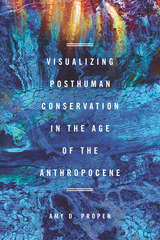 Visualizing Posthuman Conservation in the Age of the Anthropocene
Amy D. Propen
Ohio State University Press, 2018 How do we understand the lives of nonhuman animals and our relationship with and responsibilities to them? What are the artifacts or things that help configure such perceived responsibility? And what does it mean to practice conservation in the Anthropocene? Amy D. Propen seeks to answer these questions in Visualizing Posthuman Conservation in the Age of the Anthropocene, which brings a visual-material rhetorical approach into conversation with material feminisms and environmental humanities to describe how technologies, environments, bodies, and matter work together to shape and reshape how we coexist with our nonhuman kin.
Through case studies in which visual technologies and science play a prominent role in arguments to protect threatened marine species—from photographs showing the impact of ocean plastics on vulnerable sea birds, to debates about seismic testing and its impact on marine species, to maps created from GPS tracking projects—Propen advances a notion of posthuman environmental conservation that decenters the human enough to consider ideas about the material world from the vantage point of the nonhuman animal. In so bringing together work in environmental humanities, animal studies, human geography, and visual-material rhetoric, Propen further shows how interdisciplinary ways of knowing can further shape and illuminate our various lived and embodied experiences.
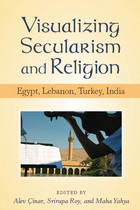 Visualizing Secularism and Religion: Egypt, Lebanon, Turkey, India
Alev Cinar, Srirupa Roy and Maha Yahya, Editors
University of Michigan Press, 2012 Over the past two decades secular polities across the globe have witnessed an increasing turn to religion-based political movements, such as the rise of political Islam and Hindu nationalism, which have been fueling new and alternative notions of nationhood and national ideologies. The rise of such movements has initiated widespread debates over the meaning, efficacy, and normative worth of secularism. Visualizing Secularism and Religion examines the constitutive role of religion in the formation of secular-national public spheres in the Middle East and South Asia, arguing that in order to establish secularism as the dominant national ideology of countries such as Turkey, Lebanon, and India, the discourses, practices, and institutions of secular nation-building include rather than exclude religion as a presence within the public sphere. The contributors examine three fields---urban space and architecture, media, and public rituals such as parades, processions, and commemorative festivals---with a view to exploring how the relation between secularism, religion, and nationalism is displayed and performed. This approach demands a reconceptualization of secularism as an array of contextually specific practices, ideologies, subjectivities, and "performances" rather than as simply an abstract legal bundle of rights and policies.
 Visualizing Taste: How Business Changed the Look of What You Eat
Ai Hisano
Harvard University Press, 2019 Ai Hisano exposes how corporations, the American government, and consumers shaped the colors of what we eat and even the colors of what we consider “natural,” “fresh,” and “wholesome.”
The yellow of margarine, the red of meat, the bright orange of “natural” oranges—we live in the modern world of the senses created by business. Ai Hisano reveals how the food industry capitalized on color, and how the creation of a new visual vocabulary has shaped what we think of the food we eat. Constructing standards for the colors of food and the meanings we associate with them—wholesome, fresh, uniform—has been a business practice since the late nineteenth century, though one invisible to consumers. Under the growing influences of corporate profit and consumer expectations, firms have sought to control our sensory experiences ever since.
Visualizing Taste explores how our perceptions of what food should look like have changed over the course of more than a century. By examining the development of color-controlling technology, government regulation, and consumer expectations, Hisano demonstrates that scientists, farmers, food processors, dye manufacturers, government officials, and intermediate suppliers have created a version of “natural” that is, in fact, highly engineered. Retailers and marketers have used scientific data about color to stimulate and influence consumers’—and especially female consumers’—sensory desires, triggering our appetites and cravings. Grasping this pivotal transformation in how we see, and how we consume, is critical to understanding the business of food.
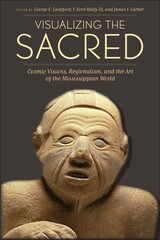 Visualizing the Sacred: Cosmic Visions, Regionalism, and the Art of the Mississippian World
Edited by George E. Lankford, F. Kent Reilly III, and James F. Garber
University of Texas Press, 2011 The prehistoric native peoples of the Mississippi River Valley and other areas of the Eastern Woodlands of the United States shared a complex set of symbols and motifs that constituted one of the greatest artistic traditions of the pre-Columbian Americas. Traditionally known as the Southeastern Ceremonial Complex, these artifacts of copper, shell, stone, clay, and wood were the subject of the groundbreaking 2007 book Ancient Objects and Sacred Realms: Interpretations of Mississippian Iconography, which presented a major reconstruction of the rituals, cosmology, ideology, and political structures of the Mississippian peoples. Visualizing the Sacred advances the study of Mississippian iconography by delving into the regional variations within what is now known as the Mississippian Iconographic Interaction Sphere (MIIS). Bringing archaeological, ethnographic, ethnohistoric, and iconographic perspectives to the analysis of Mississippian art, contributors from several disciplines discuss variations in symbols and motifs among major sites and regions across a wide span of time and also consider what visual symbols reveal about elite status in diverse political environments. These findings represent the first formal identification of style regions within the Mississippian Iconographic Interaction Sphere and call for a new understanding of the MIIS as a network of localized, yet interrelated religious systems that experienced both continuity and change over time.
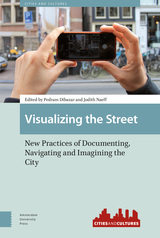 Visualizing the Street: New Practices of Documenting, Navigating and Imagining the City
Edited by Pedram Dibazar and Judith Naeff
Amsterdam University Press, 2019 From user-generated images of streets to professional architectural renderings, and from digital maps and drone footages to representations of invisible digital ecologies, this collection of essays analyses the emergent practices of visualizing the street. Today, advancements in digital technologies of the image have given rise to the production and dissemination of imagery of streets and urban realities in multiple forms. The ubiquitous presence of digital visualizations has in turn created new forms of urban practice and modes of spatial encounter. Everyone who carries a smartphone not only plays an increasingly significant role in the production, editing and circulation of images of the street, but also relies on those images to experience urban worlds and to navigate in them. Such entangled forms of image-making and image-sharing have constructed new imaginaries of the street and have had a significant impact on the ways in which contemporary and future streets are understood, imagined, documented, navigated, mediated and visualized. Visualizing the Street investigates the social and cultural significance of these new developments at the intersection of visual culture and urban space. The interdisciplinary essays provide new concepts, theories and research methods that combine close analyses of street images and imaginaries with the study of the practices of their production and circulation. The book covers a wide range of visible and invisible geographies — From Hong Kong’s streets to Rio’s favelas, from Sydney’s suburbs to London’s street markets, and from Damascus’ war-torn streets to Istanbul’s sidewalks — and engages with multiple ways in which visualizations of the street function to document street protests and urban change, to build imaginaries of urban communities and alternate worlds, and to help navigate streetscapes.
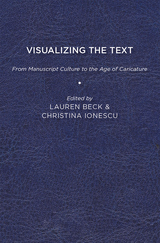 Visualizing the Text: From Manuscript Culture to the Age of Caricature
Lauren Beck
University of Delaware Press, 2017 This volume presents in-depth and contextualized analyses of a wealth of visual materials. These documents provide viewers with a mesmerizing and informative glimpse into how the early modern world was interpreted by image-makers and presented to viewers during a period that spans from manuscript culture to the age of caricature. The premise of this collection responds to a fundamental question: how are early modern texts, objects, and systems of knowledge imaged and consumed through bimodal, hybrid, or intermedial products that rely on both words and pictures to convey meaning? The twelve contributors to this collection go beyond traditional lines of inquiry into word-and-image interaction to deconstruct visual dynamics and politics—to show how images were shaped, manipulated, displayed, and distributed to represent the material world, to propagate official and commercial messages, to support religious practice and ideology, or to embody relations of power. These chapters are anchored in various theoretical and disciplinary points of departure, such as the history of collections and collecting, literary theory and criticism, the histories of science, art history and visual culture, word-and-image studies, as well as print culture and book illustration. Authors draw upon a wide range of visual material hitherto insufficiently explored and placed in context, in some cases hidden in museums and archives, or previously assessed only from a disciplinary standpoint that favored either the image or the text but not both in relation to each other. They include manuscript illuminations representing compilers and collections, frontispieces and other accompanying plates published in catalogues and museographies, astronomical diagrams, mixed pictographic-alphabetic accounting documents, Spanish baroque paintings, illustrative frontispieces or series inspired by or designed for single novels or anthologies, anatomical drawings featured in encyclopedic publications, visual patterns of volcanic formations, engravings representing the New World that accompany non-fictional travelogues, commonplace books that interlace text and images, and graphic satire. Geographically, the collection covers imperial centers (Great Britain, France, the Netherlands, and Spain), as well as their colonial periphery (New France; Mexico; Central America; South America, in particular Brazil; parts of Africa; and the island of Ceylon). Emblematic and thought-provoking, these images are only fragments of the multifaceted and comprehensive visual mosaic created during the early modern period, but their consideration has far reaching implications.
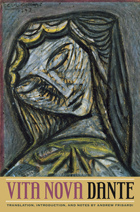 Vita Nova
Dante Alighieri, translated by Andrew Frisardi
Northwestern University Press, 2012 Receipient, 2013 Guggenheim Fellowship
Dante’s Vita Nova (circa 1292–1295) depicts the joys and sorrows, the discoveries and conflicts of Dante’s early love for Beatrice—who would achieve later and even greater fame in Commedia—starting with his first sighting of her and culminating in his prevision of Beatrice among the beatified in heaven. Award-winning translator and poet Andrew Frisardi channels the vigor and nuance of Dante’s first masterpiece for a modern audience. The “little book,” as Dante calls it, consists of thirty-one lyric poems—mostly sonnets—embedded in a prose narrative, which both recounts an apparently autobiographical set of events also evoked in the poems and offers analysis of the poems’ construction in the medieval critical tradition of divisio textus, or division of the text. Dante selected poetry he had written before age twenty-eight or so and wrote the prose to shape it into a story. The poems anthologize Dante’s growth as a poet, from the influence of his earliest mentors to the stylistic and thematic breakthroughs of his poetic coming-of-age. The interplay of poetry and prose in Vita Nova, along with the further distinction in the latter between autobiography and critical divisioni, presents a particular challenge for any translator. Frisardi faithfully voices the complex meter and rhyme schemes of the poetry while capturing the tone of each of the prose styles. His introduction and in-depth annotations provide additional context for the twenty-first-century reader.
Vita Nuova: A Novel
Bohumil Hrabal
Northwestern University Press, 2010 Vita Nuova is the second in a trilogy of memoirs written from the perspective of Bohumil Hrabal’s wife, Elis.ka, about their life in Prague from the 1950s to the 1970s, when Communist repression of artists was at its peak. Hrabal’s inimitable humor, which in Elis.ka’s ruminations ranges from bawdy slapstick to cutting irony, is all the more penetrating for being directed at himself. Vita Nuova showcases Hrabal’s legendary bohemian intellectual life, particularly his relationship with Vladimír Boudník. Hrabal creates a shrewd, lively portrait of Eastern European intellectual life in the mid-twentieth century.
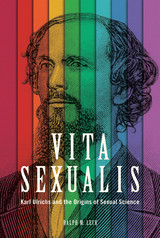 Vita Sexualis: Karl Ulrichs and the Origins of Sexual Science
Ralph M. Leck
University of Illinois Press, 2020 Karl Ulrichs's studies of sexual diversity galvanized the burgeoning field of sexual science in the nineteenth century. But in the years since, his groundbreaking activism has overshadowed his scholarly achievements. Ulrichs publicly defied Prussian law to agitate for gay equality and marriage, and founded the world's first organization dedicated to the legal and social emancipation of homosexuals. Ralph M. Leck returns Ulrichs to his place as the inventor of the science of sexual heterogeneity. Leck's analysis situates sexual science in a context that includes politics, aesthetics, the languages of science, and the ethics of gender. Although he was the greatest nineteenth-century scholar of sexual heterogeneity, Ulrichs retained certain traditional conjectures about gender. Leck recognizes these subtleties and employs the analytical concepts of modernist vita sexualis and traditional psychopathia sexualis to articulate philosophical and cultural differences among sexologists. Original and audacious, Vita Sexualis uses a bedrock figure's scientific and political innovations to open new insights into the history of sexual science, legal systems, and Western amatory codes.
The Vital Art of D.H. Lawrence: Vision and Expression
Jack Stewart
Southern Illinois University Press, 1999
D. H. Lawrence, asserts Jack Stewart, expresses a painter’s vision in words, supplementing visual images with verbal rhythms. With the help of twenty-three illustrations, Stewart examines Lawrence’s painterly vision in The White Peacock, Sons and Lovers, The Rainbow, Women in Love, Kangaroo, and The Plumed Serpent. He concludes by synthesizing the themes that pervade this interarts study: vision and expression, art and ontology.
 Vital Connections
Silvia Borzutzky
University of Notre Dame Press, 2002 Vital Connections is the first book-length treatment in English of the evolution of social security in Chile and its privatization under the Pinochet regime. Borzutzky's study contains a dynamic history of Chilean politics, a sophisticated discussion of social inequalities, and an in-depth analysis of social security policies in Chile from 1924 to the present. Her work focuses on three critical historical periods: the mid-1920s, the late 1960s, and the early to mid-1970s. In each of these key epochs, Chile experienced a crisis which prompted a reform of its socioeconomic organization and, consequently, of its social security system.
Throughout this concise, readable book, Borzutzky argues that Chile's social security system presented to the world a positive image, while hiding a political reality that was steeped in profound inequality. According to Borzutzky, Chile's social security system helped to create a "narrative" that portrayed the country as a unified society with a legitimate political system. Efforts on the part of the Chilean people to make this narrative a reality threatened those in power and ultimately led the Pinochet regime to destroy the political system and create a new "narrative" that stressed individualism, but in actuality perpetuated rampant human rights abuses.
Borzutzky's timely analysis is particularly relevant to current considerations of social security reforms. Chile's social security system is often presented as a model for the rest of Latin America and other regions of the world, including the United States. Borzutzky's book highlights the impact of privatization on various segments and aspects of society, including women and the fiscal budget.
With an impressive array of historical and current data to support her statements, Borzutzky offers a compelling counter-argument to privatization and to tradtional interpretations of Chilean politics. She offers a new window on the intimate connections between politics, policies, and the distribution of socioeconomic resources in Chile.
SILVIA BORZUTZKY is a lecturer in the Social and Decision Sciences Department and the Heinz School at Carnegie Mellon University.
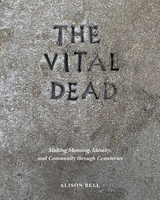 The Vital Dead: Making Meaning, Identity, and Community through Cemeteries
Alison Bell
University of Tennessee Press, 2022 What can a cemetery tell us about the social and cultural dynamics of a place and time? Anthropologist Alison Bell suggests that cemeteries participate in the grassroots cultural work of crafting social connections, even as they test the transcendental durability of the deceased person and provide a measure of a culture’s values. In The Vital Dead, Bell applies this framework to the communities of Virginia’s Shenandoah Valley and the cemeteries that have both claimed them and, paradoxically, sustained them.
Bell surveys objects left on graves, images and epitaphs on grave markers, and other artifacts of material culture to suggest a landscape of symbols maintaining relationships across the threshold of death. She explores cemetery practice and its transformation over time and largely presents her interpretations as a struggle against alienation. Rich in evocative examples both contemporary and historical, Bell’s analysis stems from fieldwork interviews, archival sources, and recent anthropological theory. The book’s chapters range across cemetery types, focusing on African American burials, the grave sites of institutionalized individuals, and modern community memorials. Ultimately, The Vital Dead is an account of how lives, both famous and forgotten, become transformed and energized through the communities and things they leave behind to produce profound and unexpected narratives of mortality. Bell’s deft storytelling coupled with skill for scholarly analysis make for a fascinating and emotionally moving read.
Groundbreaking in its approach, The Vital Dead makes important contributions to cemetery and material culture studies, as well as the fields of anthropology, archaeology, history, geography, and folklore.
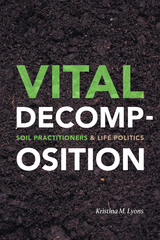 Vital Decomposition: Soil Practitioners and Life Politics
Kristina M. Lyons
Duke University Press, 2020 In Colombia, decades of social and armed conflict and the US-led war on drugs have created a seemingly untenable situation for scientists and rural communities as they attempt to care for forests and grow non-illicit crops. In Vital Decomposition Kristina M. Lyons presents an ethnography of human-soil relations. She follows state soil scientists and peasants across labs, greenhouses, forests, and farms and attends to the struggles and collaborations between farmers, agrarian movements, state officials, and scientists over the meanings of peace, productivity, rural development, and sustainability in Colombia. In particular, Lyons examines the practices and philosophies of rural farmers who value the decomposing layers of leaves, which make the soils that sustain life in the Amazon, and shows how the study and stewardship of the soil point to alternative frameworks for living and dying. In outlining the life-making processes that compose and decompose into soil, Lyons theorizes how life can thrive in the face of the violence, criminalization, and poisoning produced by militarized, growth-oriented development.
 Vital Enemies: Slavery, Predation, and the Amerindian Political Economy of Life
By Fernando Santos-Granero
University of Texas Press, 2009 Analyzing slavery and other forms of servitude in six non-state indigenous societies of tropical America at the time of European contact, Vital Enemies offers a fascinating new approach to the study of slavery based on the notion of "political economy of life." Fernando Santos-Granero draws on the earliest available historical sources to provide novel information on Amerindian regimes of servitude, sociologies of submission, and ideologies of capture. Estimating that captive slaves represented up to 20 percent of the total population and up to 40 percent when combined with other forms of servitude, Santos-Granero argues that native forms of servitude fulfill the modern understandings of slavery, though Amerindian contexts provide crucial distinctions with slavery as it developed in the American South. The Amerindian understanding of life forces as being finite, scarce, unequally distributed, and in constant circulation yields a concept of all living beings as competing for vital energy. The capture of human beings is an extreme manifestation of this understanding, but it marks an important element in the ways Amerindian "captive slavery" was misconstrued by European conquistadors. Illuminating a cultural facet that has been widely overlooked or miscast for centuries, Vital Enemies makes possible new dialogues regarding hierarchies in the field of native studies, as well as a provocative re-framing of pre- and post-contact America.
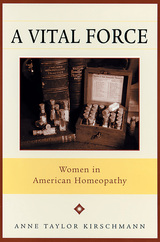 A Vital Force: Women in American Homeopathy
Kirschmann, Anne Taylor
Rutgers University Press, 2003 Homeopathy, as a medical system, presented a significant institutional and economic challenge to conventional medicine in the nineteenth century. Although contemporary critics portrayed homeopathic physicians as part of a sect whose treatment of disease was beyond the pale of acceptable medical practice, homeopathy was in many ways similar to established medicine. Anne Taylor Kirschmann explores the strategic choices and consequences for women practitioners. Not only were female homeopaths respected within their communities, they also enjoyed considerable professional advantages not available to women within regular medicine. A Vital Force: Women in American Homeopathy offers a new interpretation of women’s roles in modern medicine. Kirschmann strengthens and clarifies the history of homeopathic women physicians and creates a framework of comparison to “regular,” or orthodox, physicians. Women medical practitioners chose homeopathy in dramatic numbers from the mid-nineteenth through the early twentieth centuries, although the reasons for this preference varied over time. Linked to social reform movements in the nineteenth century, anti-modernism in the late nineteenth and early twentieth, and countercultural ideals of the 1960s and 1970s, women's advocacy of homeopathy has been intertwined with broad social and cultural issues in American society.
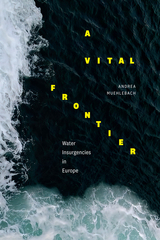 A Vital Frontier: Water Insurgencies in Europe
Andrea Muehlebach
Duke University Press, 2023 In A Vital Frontier Andrea Muehlebach examines the work of activists across Europe as they organize to preserve water as a commons and public good in the face of privatization. Traversing social, political, legal, and hydrological terrains, Muehlebach situates water as a political fault line at the frontiers of financialization, showing how the seemingly relentless expansion of capital into public utilities is being challenged by an equally relentless and often successful insurgence of political organizing. Drawing on ethnographic research, Muehlebach presents water protests as a vital politics that comprises popular referenda, barricades in the streets, huge demonstrations, the burning of utility bills, and legal disputes over transparency and contracts. As Muehlebach documents, Europe’s water activists articulate their own values of democracy and just price, raising far-reaching political questions about private versus common property and financing, liberal democracy, sovereignty, legality, and collective infrastructural responsibility in the face of financialization and commodification. Muehlebach shows that water-rights activists can successfully resist financial markets by exposing the commodification of water as the theft of life itself.
The Vital Lie: Reality and Illusion in Modern Drama
Anthony S. Abbott
University of Alabama Press, 1988 The Vital Lie is the first book to examine the reality-illusion conflict in modern drama from Ibsen to present-day playwrights. The book questions why vital lies, lies necessary for life itself, are such an obsessive concern for playwrights of the last hundred years. Using the work of fifteen playwrights, Abbott seeks to discover if modern playwrights treat illusions as helpful or necessary to life, or as signals of sicknesses from which human beings need to be cured. What happens to characters when they are forced to face the truth about themselves and their worlds without the protection of their illusions? The author develops a three-part historical analysis of the use of the reality-illusion theme, from its origins as a metaphysical search to its current elaborations as a theatrical game.
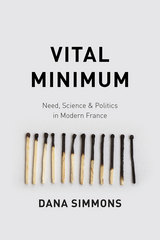 Vital Minimum: Need, Science, and Politics in Modern France
Dana Simmons
University of Chicago Press, 2015 What constitutes a need? Who gets to decide what people do or do not need? In modern France, scientists, both amateur and professional, were engaged in defining and measuring human needs. These scientists did not trust in a providential economy to distribute the fruits of labor and uphold the social order. Rather, they believed that social organization should be actively directed according to scientific principles. They grounded their study of human needs on quantifiable foundations: agricultural and physiological experiments, demographic studies, and statistics.
The result was the concept of the "vital minimum"--the living wage, a measure of physical and social needs. In this book, Dana Simmons traces the history of this concept, revealing the intersections between technologies of measurement, such as calorimeters and social surveys, and technologies of wages and welfare, such as minimum wages, poor aid, and welfare programs. In looking at how we define and measure need, Vital Minimum raises profound questions about the authority of nature and the nature of inequality.
The Vital Realities for 2020 and Beyond: Writings on Water Wars, Nuclear Devastation, Endless War, Economic Revolution, and Surveillance Versus Freedom
Roger Armbrust
Parkhurst Brothers, Inc., 2019 This collection of writings by journalist Roger Armbrust focuses on national and international public policy concerns. Armbrust is particularly concerned with water resource policy, both nationally and internationally, the increasing likelihood of nuclear war, given the proliferation of nuclear powers and the destruction of nuclear treaties. Armbrust is concerned that the USA seems to be at war somewhere nearly always, a condition that enhances the power of the military-industrial complex in this country and abroad. Economic instability exacerbated by mounting public and private debt is another of his recurring themes. The continuum of government-and corporate efforts to stifle sustainable economic progress of poorer peoples leads to social instability worldwide.
Vital Signs 1998: The Environmental Trends That Are Shaping Our Future
The Worldwatch Institute
Island Press, 1998 The new Vital Signs 1998 gives you more than 100 charts, graphs and tables that show you the worldwide trends that are changing our lives, for better and for worse. It includes the latest data on critical global trends, presented in simple but compelling graphics, along with concise, thoughtful analysis.
Vital Signs 1999: The Environmental Trends That Are Shaping Our Future
The Worldwatch Institute
Island Press, 2015 The global trends documented in Vital Signs 1999—from a decline in nuclear power generating capacity to the proliferation of genetically modified crops—will play a large part in determining the quality of our lives and our children's lives in the next decade.
Vital Signs 2000: The Environmental Trends That Are Shaping Our Future
The Worldwatch Institute
Island Press, 2015 The global trends documented in Vital Signs 2000—from the rapid rise in the sales of energy-efficient compact fluorescent lamps to the worldwide overpumping of growndwater—will play a large role in determining the quality of our lives and our children's lives in the next decade.
Vital Signs 2001: The Trends That Are Shaping Our Future
The Worldwatch Institute
Island Press, 2015 The global trends documented in Vital Signs 2001—from the rapid increase in the use of wind power to the continued warming of the planet—will play a large role in determining the quality of our lives and our children's lives in this new century.
Vital Signs 2005: The Trends That Are Shaping Our Future
The Worldwatch Institute
Island Press, 2015 This much-anticipated edition of Vital Signs covers 35 global trends that are shaping our future. From carbon emissions to loss of wetlands, each trend provides a brief status report on the topic plus graphs and charts that offer a visual comparison over time. Categories include Food, Economics, Transportation, Health, Governance, Energy and Climate, and Conflict and Peace.
Vital Signs 2006-2007: The Trends That Are Shaping Our Future
The Worldwatch Institute
Island Press, 2015 This report tracks and analyzes 44 trends that are shaping our future, and includes graphs and charts to provide a visual comparison over time. Categories of trends include: Food, Agricultural Resources, Energy and Climate, Global Economy, Resource Economics, Environment, War and Conflict, Communications and Transportation, Population and Society, and Health and Disease.
Vital Signs 2007-2008: The Trends That Are Shaping Our Future
The Worldwatch Institute
Island Press, 2015 This report tracks and analyzes 44 trends that are shaping our future, and includes graphs and charts to provide a visual comparison over time. Categories of trends include: Food, Agricultural Resources, Energy and Climate, Global Economy, Resource Economics, Environment, Conflict and Peace, Communications and Transportation, Population and Society, and Health and Disease.
Vital Signs 2009: The Trends That Are Shaping Our Future
The Worldwatch Institute
Island Press, 2015 This sixteenth volume of Worldwatch’s Vital Signs series makes it clear that climate change is both a growing driver of and an increasingly important motivator behind the world’s leading economic, social, and environmental trends.
Vital Signs 2010: The Trends That Are Shaping Our Future
The Worldwatch Institute
Island Press, 2015 This seventeenth edition of the Worldwatch Institute series shows that climate change continues to cast a long shadow over the world’s leading economic, social, and environmental trends.
Vital Signs 2011: The Trends That Are Shaping Our Future
The Worldwatch Institute
Island Press, 2015 This eighteenth volume of the Worldwatch Institute series makes it clear that the Great Recession affects many of the world’s leading economic, social, and environmental trends—but that the impact can be very different by country.
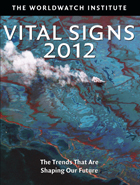 Vital Signs 2012: The Trends that are Shaping Our Future
The Worldwatch Institute
Island Press, 2012 Just as people schedule regular check-ups with physicians, our planet needs regular check-ups to catch issues as early as possible, before they become more serious and harder to heal. That is the much-needed service provided on a global scale by the Worldwatch Institute in this new book, Vital Signs 2012.
By taking stock of global consumption, Vital Signs 2012 offers the facts that need to guide our stewardship of the Earth's resources-and some of these facts are shocking. The report covers topics from obesity to ecosystem services, from grain production to nuclear power. Taken as a whole, it paints a picture of skyrocketing population, disappearing forests, and increasing consumption peppered with bright spots like growing investment in high-speed trains and other efficient transportation systems.
Vital Signs 2012 is based on Worldwatch's online project of the same name, which provides up-to-date figures on important global concerns, as well as the Institute's own additional research. The book compiles the most important of these into an accessible, informative resource for policymakers and anyone who wants a realistic look at the state of our planet.
Vital signs: contemporary American poetry from the university presses
Ronald Wallace
University of Wisconsin Press, 1989 The selections in this anthology represent the full range and vitality of contemporary American poetry--from minimalism to epic, from free verse to traditional form, from plain conversation to richly embroidered tapestry, form passionate political utterance to intense personal drama, from light verse to tough lyricism. Since 1950 university presses have published more than 900 volumes of original poetry , opening the canon to a wide range of rich and exciting voices. Nearly 200 of the those volumes are represented here. Vital Signs features poems by such well established poets as John Ashbery, Marge Piercy, Adrienne Rich, and James Wright. Because the presses have also played a role in discovering and promoting the work of new poets, the reader will find here poems by many younger writers as well.
Vital Signs: The Deadly Costs of Health Inequality
Lee Humber
Pluto Press, 2019 Nature is no longer the leading cause of death; society is. This makes health care one of the most important political issues today. This book looks at the reasons behind the declining condition of our bodies, as governments across the world choose to neglect the health of the majority of their citizens. Using hard data taken from service users, Lee Humber constructs a sharp analysis that gets to the heart of inequality in health care today, showing that 'wealthy means healthy'. Life expectancy for many in the UK and US is worse than it was 100 years ago, and more and more communities across the world can expect shorter and less healthy lives than their parents. Humber also suggests radical strategies for tackling this degenerative situation, providing a compelling vision for how we can shape our health and that of future generations.
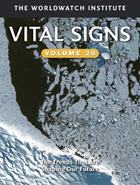 Vital Signs Volume 20: The Trends that are Shaping Our Future
The Worldwatch Institute
Island Press, 2013 From meat consumption to automobile production to hydropower, Vital Signs, Volume 20 documents over two dozen trends that are shaping our future in concise analyses and clear tables and graphs. The twentieth volume of the Worldwatch Institute series demonstrates that while remarkable progress has been made over the past year, much remains to be done to get the planet on a more sustainable track.
Worldwide, people are waking up to the realities of a resource-constrained planet: investments and subsidies for renewable energy have reached new heights, consumers are slowly shifting away from meat-heavy diets, and new employment structures like co-operatives are democratizing the global economy. Yet with over 1 billion people lacking access to electricity, natural disasters that are more costly than ever before, and an adherence to the factory farm model of food production, it is clear that many obstacles loom on the horizon.
Covering a wide range of environmental, economic, and social themes, Vital Signs, Volume 20 is the go-to source for straightforward data and analyses on the latest issues facing an increasingly crowded planet. By placing each trend within a global framework, Vital Signs, Volume 20 identifies the solutions we need to transition toward a more sustainable world.
This book will be especially useful for policymakers, environmental nonprofits, and students of environmental studies, sustainability, or economics.
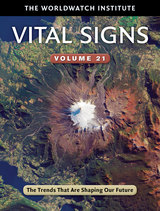 Vital Signs Volume 21: The Trends That Are Shaping Our Future
The Worldwatch Institute
Island Press, 2015 Vital Signs Volume 21 is all about growth. From natural disasters to cars to organic farming, the two dozen trends examined here indicate both increasing pressure on natural resources and scaled up efforts to live more sustainably. In 2012, world auto production set yet another record with passenger-car production rising to 66.7 million. That same year, the number of natural disasters climbed to 905, roughly one hundred more than the 10-year annual average, and 90 percent were weather related. Alongside these mounting pressures come investments in renewable energy and sustainable agriculture. The number of acres of land farmed organically has tripled since 1999, though it still makes up less than 1% of total farmland. Not all the statistics are going up. Key measures of development aid have fallen, as have global commodity prices. Yet the overall trend is expansion, both for the good and ill of the planet. Vital Signs provides the latest data available, but its value goes beyond simple numbers. Through insightful analysis of global trends, it offers a starting point for those seeking solutions to the future’s intensifying challenges.
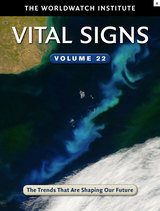 Vital Signs Volume 22: The Trends That Are Shaping Our Future
The Worldwatch Institute
Island Press, 2015 What we make and buy is a major indicator of society’s collective priorities. Among twenty-four key trends, Vital Signs Volume 22 explores significant global patterns in production and consumption. The result is a fascinating snapshot of how we invest our resources and the implications for the world’s well-being.
The book examines developments in six main areas: energy, environment and climate, transportation, food and agriculture, global economy and resources, and population and society. Readers will learn how aquaculture is making gains on wild fish catches, where high speed rail is accelerating, why plastic production is on the rise, who is escaping chronic hunger, and who is still suffering.
Researchers at the Worldwatch Institute not only provide the most up-to-date statistics, but put them in context. The analysis in Vital Signs teaches us both about our current priorities and how they could be shaped to create a better future.
The Vital South: How Presidents are Elected
Earl Black and Merle Black
Harvard University Press, 1992 Once again a southern governor has shown Democrats the road to the White House. As a native southerner, President Bill Clinton has the opportunity to rebuild Democratic strength in the region. For the Republicans, carrying the entire South still remains a crucial imperative.
The Vital South is the first book to chronicle the massive shift of southern electoral power to Republican presidential candidates, while also showing how Democrats can again become competitive in the region. Deftly combining political narrative, in-depth analysis, and telling anecdotes, this book will be a definitive source on southern presidential politics for years to come.
The VITAL SYSTEM: Poems
CM Burroughs
Tupelo Press, 2012 The Vital System is the first published book by a poet already setting off sparks among readers across the globe. In these poems, the body is always at stake — vulnerable — and the poet dares to try and illuminate what she has called “the protective capability of violence.” Burroughs’s compression of phrasing, subverted syntax, and ability to release a story through cinematically sequenced images allow her to expose particular tensions that are gendered and racial as well as essentially human.
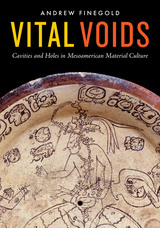 Vital Voids: Cavities and Holes in Mesoamerican Material Culture
By Andrew Finegold
University of Texas Press, 2021 The Resurrection Plate, a Late Classic Maya dish, is decorated with an arresting scene. The Maize God, assisted by two other deities, emerges reborn from a turtle shell. At the center of the plate, in the middle of the god’s body and aligned with the point of emergence, there is a curious sight: a small, neatly drilled hole. Art historian Andrew Finegold explores the meanings attributed to this and other holes in Mesoamerican material culture, arguing that such spaces were broadly understood as conduits of vital forces and material abundance, prerequisites for the emergence of life. Beginning with, and repeatedly returning to, the Resurrection Plate, this study explores the generative potential attributed to a wide variety of cavities and holes in Mesoamerica, ranging from the perforated dishes placed in Classic Maya burials, to caves and architectural voids, to the piercing of human flesh. Holes are also discussed in relation to fire, based on the common means through which both were produced: drilling. Ultimately, by attending to what is not there, Vital Voids offers a fascinating approach to Mesoamerican cosmology and material culture.
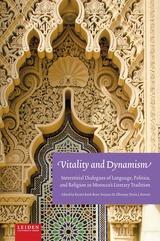 Vitality And Dynamism: Interstitial Dialogues of Language, Politics, and Religion in Morocco's Literary Tradition
Kirstin Bratt
Amsterdam University Press, 2014 "Anti-colonial literature is not necessarily ‘combat literature’ as Fanon and Déjeux have both suggested in their own writings. While it is often combative, there is also anti-colonial literature that emphasizes the human and the humane rather than the oppositional and contentious; it cannot be fair to label all anti-colonial literature as combative, even if one were to expand the definition of “combat” to include peaceful struggles against oppression or dehumanization. This book suggests that the relationship between the West and the rest of the world has been imagined as a relationship of Self (the West) to Other (the rest of the world), ordered and bordered geographically by the whims of Europeans and creating a Center-Periphery paradigm. These invented boundaries of humanity serve to separate geographical sites, but more, they serve to enclose the Empire and exoticize other cultures. Boundaries are often spatial, but more often, they are related to relationships and colonialization."
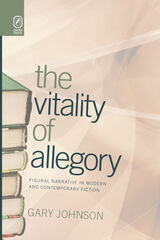 The Vitality of Allegory: Figural Narrative in Modern and Contemporary Fiction
Gary Johnson
Ohio State University Press, 2012 In The Vitality of Allegory Gary Johnson argues that the rumors of allegory’s death have been greatly exaggerated. Surveying the broad landscape of modern and contemporary narrative fiction, including works from Europe, Africa, and North America, Johnson demonstrates that, although wholly allegorical narratives have become relatively rare, allegory itself remains a vibrant presence in the ongoing life of the novel, a presence that can manifest itself in a variety of ways. Working from the premise that conventional conceptions of allegory have been inadequate, Johnson takes a rhetorical approach, defining allegory as the transformation of some phenomenon into a figural narrative for some larger purpose. This reconception allows us to recognize that allegory can govern a whole narrative—and can do so strongly or weakly—or be an embedded part or a thematic subject of a narrative and that it can even be used ironically. By developing these theoretical points through careful and insightful analysis of works such as Jackson’s “The Lottery,” Orwell’s Animal Farm, Kafka’s The Metamorphosis and The Trial, Achebe’s Things Fall Apart, Roth’s American Pastoral, Mann’s Death in Venice, Coetzee’s Elizabeth Costello, and several works by John Barth, Johnson himself transforms our understanding of allegory and of the history of the modern and contemporary novel.
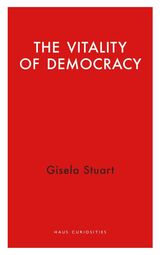 The Vitality of Democracy
Gisela Stuart
Haus Publishing, 2022 A reflection on the current state of and challenges to British democracy.
In The Vitality of Democracy, British-German politician Gisela Stuart argues for the urgency of expanded participation in the democratic process and considers the risks democracy currently faces. Although democracy is rife with difficult choices, she shows that if the people do not appreciate what makes this system work, they risk losing it. While no individual holds the answers, democracy allows for power to change hands, giving opportunities for different sides to have a chance at improving government for all.
Stuart reflects on challenges to British democracy since the mid-2010s. With the United Kingdom exiting the European Union and facing an overwhelming pandemic, restrictions to civil liberties were imposed that may have been unimaginable in the past. It is time to pause and reflect on the serious challenges currently posed to democracy and to the ability of the people to take part.
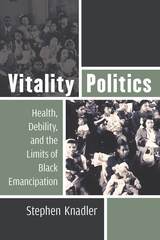 Vitality Politics: Health, Debility, and the Limits of Black Emancipation
Stephen Knadler
University of Michigan Press, 2019 Vitality Politics focuses on a slow racial violence against African Americans through everyday, accumulative, contagious, and toxic attritions on health. The book engages with recent critical disability studies scholarship to recognize that debility, or the targeted maiming and distressing of Black populations, is a largely unacknowledged strategy of the U.S. liberal multicultural capitalist state. This politicization of biological health serves as an instrument for insisting on a racial state of exception in which African Americans’ own unhealthy habits and disease susceptibility justifies their legitimate suspension from full rights to social justice, economic opportunity, and political freedom and equality. The book brings together disability studies, Black Studies, and African American literary history as it highlights the urgent need and gives weight to a biopolitics of debilitation and medicalization to better understand how Black lives are made not to matter in our supposedly race-neutral multicultural democracy.
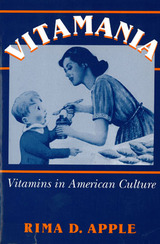 Vitamania: Vitamins in American Culture
Rima Apple
Rutgers University Press, 1996 "Have you taken your vitamins today?" That question echoes daily through American households. Thanks to intensive research in nutrition and medicine, the importance of vitamins to health is undisputed. But millions of Americans believe that the vitamins they get in their food are not enough. Vitamin supplements have become a multibillion-dollar industry. At the same time, many scientists, consumer advocacy groups, and the federal Food and Drug Administration doubt that most people need to take vitamin pills. Vitamania tells how and why vitamins have become so important to so many Americans. Rima Apple examines the claims and counterclaims of scientists, manufacturers, retailers, politicians, and consumers from the discovery of vitamins in the early twentieth century to the present. She reveals the complicated interests--scientific, professional, financial--that have propelled the vitamin industry and its would-be regulators. From early advertisements linking motherhood and vitamin D, to Linus Pauling's claims for vitamin C, to recent congressional debates about restricting vitamin products, Apple's insightful history shows the ambivalence of Americans toward the authority of science. She also documents how consumers have insisted on their right to make their own decisions about their health and their vitamins. Vitamania makes fascinating reading for anyone who takes--or refuses to take--vitamins. It will be of special interest to students, scholars, and professionals in public health, the biomedical sciences, history of medicine and science, twentieth-century history, nutrition, marketing, and consumer studies.
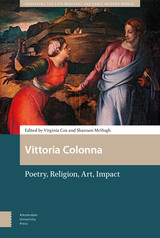 Vittoria Colonna: Poetry, Religion, Art, Impact
Virginia Cox
Amsterdam University Press, 2022 This edited collection presents fresh and original work on Vittoria Colonna, perhaps the outstanding female figure of the Italian Renaissance, a leading Petrarchist poet, and an important figure in the Italian Reform movement. Until recently best known for her close spiritual friendship with Michelangelo, she is increasingly recognized as a powerful and distinctive poetic voice, a cultural and religious icon, and an important literary model for both men and women. This volume comprises compelling new research by established and emerging scholars in the fields of literature, book history, religious history, and art history, including several studies of Colonna’s influence during the Counter-Reformation, a period long neglected by Italian cultural historiography. The Colonna who emerges from this new reading is one who challenges traditional constructions of women’s place in Italian literature: no mere imitator or follower, but an innovator and founder of schools in her own right.
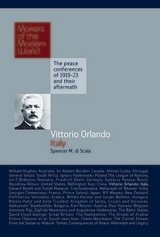 Vittorio Orlando: Italy
Spencer Di Scala
Haus Publishing, 2009 The Italian premier Vittorio Orlando came to Paris as one of the 'Big Four', yet in April 1919 walked out in one of the most dramatic crises of the Peace Conferences. Orlando's failure to win for Italy the territories she felt were owed to her was to have far-reaching consequences for both Italy and Europe as a whole. Italy in 1918 was in an ambivalent position: at the outbreak of war the country had been part of the Triple Alliance with Germany and Austria-Hungary, but had stayed neutral until joining the Allies in 1915 on the promise of territorial rewards. The war was a near-disaster for the Italians, culminating in the collapse of their armies at Caporetto in 1917. It was this crisis that brought Orlando to power, and he did much to restore the situation, but the Italians looked to Versailles to compensate them for the terrible losses they had suffered. In this book, the clash between Italy's territorial demands in the Balkans, which had been guaranteed by the Allies in 1915 and earned through her losses in the War, with the new Wilsonian doctrine of open diplomacy and national self-determination is detailed, and it traces the effects the failure of Orlando's delegation to satisfy their people's demands which directly to the rise of Fascism and to Mussolini's policies in the 1930s as he sought to obtain what Italy had been denied at Versailles.
Viva Baseball!: Latin Major Leaguers and Their Special Hunger
Samuel O. Regalado
University of Illinois Press, 2007 Lively and filled with vivid anecdotes, Viva Baseball! chronicles the struggles of Latin American professional baseball players in the United States from the late 1800s to the present. As Latino players, managers, and owners continue to blossom into baseball's biggest stars, they have benefited from a growing Spanish-language media, a group identity, an increase in financial leverage and attention, and a burgeoning Latino culture in the United States. Although there have been several positive developments in the treatment of Latin American players, many, such as Albert Pujols, Pedro Martinez, Alex Rodriguez, and Ozzie Guillen, still face shocking racism. Samuel O. Regalado draws upon archives and rich interviews with Latin baseball stars like Felipe Alou, Orlando Cepeda, and Minnie Minoso to show the changing tenor of discrimination in the twenty-first-century game.
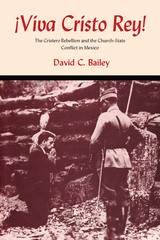 Viva Cristo Rey!: The Cristero Rebellion and the Church-State Conflict in Mexico
By David C. Bailey
University of Texas Press, 1974 Between 1926 and 1929, thousands of Mexicans fought and died in an attempt to overthrow the government of their country. They were the Cristeros, so called because of their battle cry, ¡Viva Cristo Rey!—Long Live Christ the King! The Cristero rebellion and the church-state conflict remain one of the most controversial subjects in Mexican history, and much of the writing on it is emotional polemic. David C. Bailey, basing his study on the most important published and unpublished sources available, strikes a balance between objective reporting and analysis. This book depicts a national calamity in which sincere people followed their convictions to often tragic ends. The Cristero rebellion climaxed a century of animosity between the Catholic church and the Mexican state, and this background is briefly summarized here. With the coming of the 1910 revolution the hostility intensified. The revolutionists sought to impose severe limitations on the Church, and Catholic anti-revolutionary militancy grew apace. When the government in 1926 decreed strict enforcement of anticlerical legislation, matters reached a crisis. Church authorities suspended public worship throughout Mexico, and Catholics in various parts of the country rose up in arms. There followed almost three years of indecisive guerrilla warfare marked by brutal excesses on both sides. Bailey describes the armed struggle in broad outline but concentrates on the political and diplomatic maneuvering that ultimately decided the issue. A de facto settlement was brought about in 1929, based on the government’s pledge to allow the Church to perform its spiritual offices under its own internal discipline. The pact was arranged mainly through the intercession of U.S. Ambassador Dwight Morrow. His role in the conflict, as well as that of other Americans who decisively influenced the course of events, receives detailed attention in the study. The position of the Vatican during the conflict and its role in the settlement are also examined in detail. With the 1929 settlement the clergy returned to the churches, whereupon the Cristeros lost public support and the rebellion collapsed. The spirit of the settlement soon evaporated, more strife followed, and only after another decade did permanent religious peace come to Mexico.
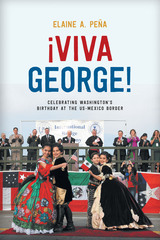 Viva George!: Celebrating Washington's Birthday at the US-Mexico Border
By Elaine A. Peña
University of Texas Press, 2020 2021 Jim Parish Award for Documentation and Publication of Local and Regional History, Webb County Heritage Foundation
For 120 years, residents of the cross-border community of Laredo/Nuevo Laredo have celebrated George Washington's birthday together, and this account reveals the essential political work of a time-honored civic tradition.
Since 1898, residents of Laredo, Texas, and Nuevo Laredo, Tamaulipas, have reached across the US-Mexico border to celebrate George Washington's birthday. The celebration can last a whole month, with parade goers reveling in American and Mexican symbols; George Washington saluting; and “Pocahontas” riding on horseback. An international bridge ceremony, the heart and soul of the festivities, features children from both sides of the border marching toward each other to link the cities with an embrace. ¡Viva George! offers an ethnography and a history of this celebration, which emerges as both symbol and substance of cross-border community life. Anthropologist and Laredo native Elaine A. Peña shows how generations of border officials, civil society organizers, and everyday people have used the bridge ritual to protect shared economic and security interests as well as negotiate tensions amid natural disasters, drug-war violence, and immigration debates. Drawing on previously unknown sources and extensive fieldwork, Peña finds that border enactments like Washington's birthday are more than goodwill gestures. From the Rio Grande to the 38th Parallel, they do the meaningful political work that partisan polemics cannot.
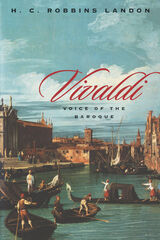 Vivaldi: Voice of the Baroque
H. C. Robbins Landon
University of Chicago Press, 1996 Vivaldi boasted that he could compose a concerto faster than a scribe could copy one. Despite his prolificacy, The Four Seasons, and the majority of his already published work had fallen into obscurity by the time of his death in poverty in 1741. Most of his music-concertos, sonatas, operas, and sacral music-has been published only recently.
Very little has been written on Vivaldi for the nonspecialist, especially in English. Landon rediscovers the composer in this accessible and musically informed biography while presenting documentation of the musician's life discovered after the Baroque revival in the 1930s. This book includes illustrations of eighteenth-century Venice and several newly translated letters, thoroughly evoking the style of the time and revealing some of the more personal aspects of Vivaldi's life.
"Belongs on the shelf of every serious music student."—Kirkus
"Gives a good feel for Vivaldi's life and times . . . and describes particularly well how Vivaldi has been revived."—Booklist
"Robbins Landon is marvelously entertaining, extravagantly learned."—The Independent
 Vivarium
Natasha Sajé
Tupelo Press, 2014 A vivarium is an enclosure for living things — plants or animals — which might likewise be said of a poem. With a vivacious sensibility and unruly leaps from elegiac to ironic, Sajé’s new book is an abecedarium, fully using the page, and challenging all manner of received wisdom. Employing lyrics, lists, arguments, narratives, and meditations, and including prose poems devoted to particular letters as well as invented visual or conceptual pieces, in Vivarium the alphabet is endowed with power far beyond usefulness. Form breathes life in this book, and the lived emotion of these poems defies death. “In Vivarium, Natasha Sajé, one of poetry’s most ludic and encyclopedic essayists, explores language — and the alphabet — in terms both acerbic and lush, exposing the roots of the world’s ills, and its many rooted pleasures. In a word, zowie!” — Mary Ruefle “Resourceful, restless, witty and substantially intelligent — what a rare combination of erudition and nimbleness this group of poems exhibits. Their range is marvelously wide in both form and tone… Each poem surprised me, taught me something, delighted and illuminated and stretched.” —Dean Young, in a citation for the Academy of American Poets’ 2008 Alice Fay di Castagnola Award
 Vivian Maier: A Photographer’s Life and Afterlife
Pamela Bannos
University of Chicago Press, 2017 Who was Vivian Maier? Many people know her as the reclusive Chicago nanny who wandered the city for decades, constantly snapping photographs, which were unseen until they were discovered in a seemingly abandoned storage locker. They revealed her to be an inadvertent master of twentieth-century American street photography. Not long after, the news broke that Maier had recently died and had no surviving relatives. Soon the whole world knew about her preternatural work, shooting her to stardom almost overnight.
But, as Pamela Bannos reveals in this meticulous and passionate biography, this story of the nanny savant has blinded us to Maier’s true achievements, as well as her intentions. Most important, Bannos argues, Maier was not a nanny who moonlighted as a photographer; she was a photographer who supported herself as a nanny. In Vivian Maier: A Photographer’s Life and Afterlife, Bannos contrasts Maier’s life with the mythology that strangers—mostly the men who have profited from her work—have created around her absence. Bannos shows that Maier was extremely conscientious about how her work was developed, printed, and cropped, even though she also made a clear choice never to display it. She places Maier’s fierce passion for privacy alongside the recent spread of her work around the world, and she explains Maier’s careful adjustments of photographic technique, while explaining how the photographs have been misconstrued or misidentified. As well, Bannos uncovers new information about Maier’s immediate family, including her difficult brother, Karl—relatives that once had been thought not to exist.
This authoritative and engrossing biography shows that the real story of Vivian Maier, a true visionary artist, is even more compelling than the myth.
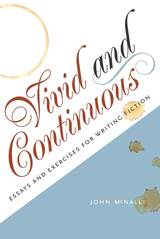 Vivid and Continuous: Essays and Exercises for Writing Fiction
John McNally
University of Iowa Press, 2013 Taking off from The Creative Writer’s Survival Guide, John McNally’srelentlessly blunt, bracingly cheerful, and immensely helpful map to being a writer, Vivid and Continuousis an equally blunt, cheerful, and helpful map to learning to be a writer. While acknowledging that many fine books cover such essentials of fiction writing as point of view, characterization, and setting, McNally sets out in this new book—intended as a supplement to beginning fiction-writing classes or as the sole text for upper-level or graduate courses—to solve the tricky second-tier problems that those books cover only in footnotes. Vivid and Continuous takes its inspiration from John Gardner, whose essential truths in On Becoming a Novelist clarified McNally’s goal of communicating a “vivid and continuous dream” with his own writing. In fifteen concise, energizing chapters, he dispenses advice gained from almost thirty years of studying, writing, and teaching. How do you avoid the pitfalls inherent in the most common subjects for stories? How do you create memorable minor characters? What about managing references to pop culture without distracting your readers, revising a story to bring its subtext into focus, or exploring the twenty most common craft-related quirks that lessen immediacy for your readers? How do you keep from overdosing on similes and metaphors or relying on too many flashbacks to provide necessary backstory? How do you learn to listen when your story tries to talk to you? Finally, how can you resist “John McNally’s Sure-Fire Formula for Becoming Funnier in 30 Days”? McNally cites many novels and short stories as examples that best illustrate the lessons he wants to impart, the writer’s life, or the writer’s craft, as well as his own favorite authors’ novels and short story collections. Exercises at the end of each chapter reinforce its point and serve as practical catalysts for new writings and directions. Just blunt enough to get your attention but not blunt enough to crush you, challenging but not discouraging, personal but not ego-ridden, snarky but not mean, John McNally will prompt you to think more deeply about a variety of issues that will push you toward writing more meaningful, more accomplished work.
VIVID COMPANION
Irene McKinney
West Virginia University Press, 2004 This fifth collection of poetry from West Virginia's poet laureate and author of Six O'Clock Mine Report is an extraordinary set of poems which reflects the complexity, the magnanimity, and the resilience of the human spirit. McKinney writes with candor, precision, and compassion; most importantly, though, her poems are accessible to all types of readers.
Vixen
Cherene Sherrard
Autumn House Press, 2017 Cherene Sherrard’s poetry collection Vixen takes to task the historical narratives and artistic mediums that have shaped racial and gender identity. She asks her readers to closely examine the hand that guides the pen, the photographer behind the lens, and the star on stage. In powerful, finely crafted lines, Sherrard’s poems interrupt and redirect the conversation. Sherrard’s voice-driven poems are accessible to any reader interested in work that examines racial and black female representation within a historical, cultural, and artistic framework.
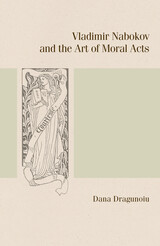 Vladimir Nabokov and the Art of Moral Acts
Dana Dragunoiu
Northwestern University Press, 2022 Winner, 2022 Brian Boyd Prize for Best Second Book on Nabokov This book shows how ethics and aesthetics interact in the works of one of the most celebrated literary stylists of the twentieth century: the Russian American novelist Vladimir Nabokov. Dana Dragunoiu reads Nabokov’s fictional worlds as battlegrounds between an autonomous will and heteronomous passions, demonstrating Nabokov’s insistence that genuinely moral acts occur when the will triumphs over the passions by answering the call of duty.
Dragunoiu puts Nabokov’s novels into dialogue with the work of writers such as Alexander Pushkin, William Shakespeare, Leo Tolstoy, and Marcel Proust; with Kantian moral philosophy; with the institution of the modern duel of honor; and with the European traditions of chivalric literature that Nabokov studied as an undergraduate at Cambridge University. This configuration of literary influences and philosophical contexts allows Dragunoiu to advance an original and provocative argument about the formation, career, and legacies of an author who viewed moral activity as an art, and for whom artistic and moral acts served as testaments to the freedom of the will.
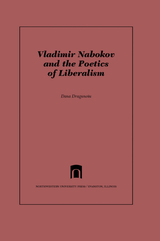 Vladimir Nabokov and the Poetics of Liberalism
Dana Dragunoiu
Northwestern University Press, 2011 Alongside the puzzles contained in Nabokov’s fiction, scholars have been unable to untangle the seemingly contradictory relationship between, on one hand, the fiction and the beliefs and principles suggested by Nabokov’s biography and, on the other hand, the statements he made outside of his work. Through a close examination of Nabokov’s father’s political, moral, and aesthetic values and, more generally, Russian liberalism as it existed in the first few decades of the twentieth century, Dragunoiu provides persuasive answers to many long-standing questions in this deeply researched, innovative study.
Showing the particular influence of the thought of Kant and Berkeley, she focuses on what she calls Nabokov’s “most deceptively apolitical novels”: The Gift, Lolita, Pale Fire, and Ada. In bringing to them a more extensive context than previous Nabokov scholars, Dragunoiu argues that their treatment of various moral and political subjects can be more clearly understood in the light of ideas inherited by Nabokov from his father and his father’s generation.
 Vladimir's Carrot: Modern Drama and the Modern Imagination
John Peter
University of Chicago Press, 1987 What is modern in modern drama? What defines it, unmistakably, as being of our time? This quality if the subject of John Peter's inquiry.
For Peter, Beckett's Waiting for Godot makes such a radical break with dramatic tradition that it prompts the question: Is this play the single most important event in the theater since Aeschylus? Or is it the fulfillment of forces at work long before Beckett wrote it? Peter shows how Beckett's work represents a change in the very subject matter of drama, a fundamental revision of concepts of character, plot, and meaning, which in turn requires a new way of responding to drama. Where plays have traditionally engaged audiences in critical and moral dialogue, theater like Beckett's, according to Peter, is closed to questioning; it presents a vision of the world which can only be accepted or rejected. As such, it not only signals a new form of drama, but also posits a fundamentally changed audience.
Peter views this change—essentially, a change of mind—in its wider context. The times and the thought that contribute to the modern imagination are represented here by novels, paintings, and music—works by Wagner, Kafka, Proust, Picasso, and Braque—as well as plays. Peter shows how the depiction of the world by these artists echoes—and is echoed by—the work of modern thinkers such as Schopenhauer, Nietzsche, and Freud.
Vladimir's Carrot will provoke and stimulate readers who find themselves either lost or perfectly at home in "modern" culture.
VLSI and Post-CMOS Devices, Circuits and Modelling
Rohit Dhiman
The Institution of Engineering and Technology, 2019 VLSI, or Very-Large-Scale-Integration, is the practice of combining billions of transistors to create an integrated circuit. At present, VLSI circuits are realised using CMOS technology. However, the demand for ever smaller, more efficient circuits is now pushing the limits of CMOS. Post-CMOS refers to the possible future digital logic technologies beyond the CMOS scaling limits. This book addresses the current state of the art in VLSI technologies and presents potential options for post-CMOS approaches.
VLSI and Post-CMOS Electronics: Design, modelling and simulation, Volume 1
Rohit Dhiman
The Institution of Engineering and Technology, 2019 VLSI, or Very-Large-Scale-Integration, is the practice of combining billions of transistors to create an integrated circuit. At present, VLSI circuits are realised using CMOS technology. However, the demand for ever smaller, more efficient circuits is now pushing the limits of CMOS. Post-CMOS refers to the possible future digital logic technologies beyond the CMOS scaling limits. This 2-volume set addresses the current state of the art in VLSI technologies and presents potential options for post-CMOS processes.
VLSI and Post-CMOS Electronics: Devices, circuits and interconnects, Volume 2
Rohit Dhiman
The Institution of Engineering and Technology, 2019 VLSI, or Very-Large-Scale-Integration, is the practice of combining billions of transistors to create an integrated circuit. At present, VLSI circuits are realised using CMOS technology. However, the demand for ever smaller, more efficient circuits is now pushing the limits of CMOS. Post-CMOS refers to the possible future digital logic technologies beyond the CMOS scaling limits. This 2-volume set addresses the current state of the art in VLSI technologies and presents potential options for post-CMOS processes.
VLSI Architectures for Future Video Coding
Maurizio Martina
The Institution of Engineering and Technology, 2019 This book addresses future video coding from the perspective of hardware implementation and architecture design, with particular focus on approximate computing and the energy-quality scalability paradigm. Challenges in deploying VLSI architectures for video coding are identified and potential solutions postulated with reference to recent research in the field. The book offers systematic coverage of the designs, techniques and paradigms that will most likely be exploited in the design of VLSI architectures for future video coding systems.
VLSI Testing: Digital and mixed analogue/digital techniques
Stanley L. Hurst
The Institution of Engineering and Technology, 1998 The importance of testing integrated circuits (ICs) has escalated with the increasing complexity of circuits fabricated on a single IC chip. No longer is it possible to design a new IC and then think about testing: such considerations must be part of the initial design activity, and testing strategies should be part of every circuit and system designer's education. This book is a comprehensive introduction and reference for all aspects of IC testing. It includes all of the basic concepts and theories necessary for advanced students, from practical test strategies and industrial practice, to the economic and managerial aspects of testing. In addition to detailed coverage of digital network testing, VLSI testing also considers in depth the growing area of testing analogue and mixed analogue/digital ICs, used particularly in signal processing.
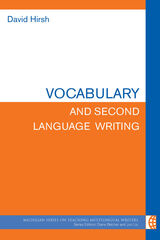 Vocabulary and Second Language Writing
David Hirsh
University of Michigan Press, 2021 In this volume, David Hirsh compellingly makes the case for why vocabulary should be a necessary component of L2 writing proficiency and L2 writing instruction. He examines why vocabulary size and context matter, how productive use of vocabulary can be scaffolded, how to treat vocabulary errors, and the ways that technology like corpora and concordances can support teachers and improve students’ independent vocabulary acquisition. In fact, one chapter is devoted to fostering learner autonomy, an important contribution to pedagogy that is often neglected in similar texts.
Each chapter concludes with a list of key points and tasks and discussion questions for pre- and in-service instructors. Several chapters also include sample activities for teaching vocabulary at various instructional levels, designed to encourage readers to consider more deeply how they will include vocabulary instruction in their classrooms.
Vocabulary and Second Language Writing will be an excellent guide for all college-level writing instructors and help them understand the critical role that vocabulary plays in writing quality—something that is often disregarded in favor of holistic features like genre and rhetoric. The volume may also be useful for writing center administrators and those who train writing tutors.
Vocabulary Building in Indonesian: An Advanced Reader
Soenjono Dardjowidjojo
Ohio University Press, 1984 An outstanding advanced text intended to complement and supplement Indonesian language materials now available. The author takes the student through a series of original essays and previously published material on a variety of subjects, not merely explaining grammatical and vocabulary matters, but offering detailed discussions of nuances, alternative meanings, synonyms and antonyms. This unique vocabulary exploration device forms about one–third of the book, and makes the lessons powerful aids to efficient and in–depth language learning.
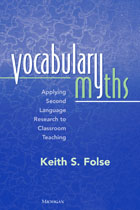 Vocabulary Myths: Applying Second Language Research to Classroom Teaching
Keith S. Folse
University of Michigan Press, 2004
In Vocabulary Myths, Keith S. Folse breaks down the teaching of second language vocabulary into eight commonly held myths. In debunking each myth, he introduces the myth with a story based on his 25 years of teaching experience (in the United States and abroad), continues with a presentation of what empirical research has shown on the topic, and finishes with a list of what teachers can do in their classrooms to facilitate true vocabulary acquisition.
The goal of Vocabulary Myths is to foster a paradigm shift that correctly views vocabulary as fundamental in any second language learning process and demonstrates that research supports this goal-that in fact there is a wealth of empirical evidence to support these views. In addition, an important theme is that teachers have overestimated how much vocabulary students really understand, and as a result, the so-called "comprehensible input" is neither comprehensible nor input.
The second language vocabulary acquisition myths reexamined in this book are:
*In learning another language, vocabulary is not as important as grammar or other areas.
*Using word lists to learn L2 vocabulary is unproductive.
*Presenting new vocabulary in semantic sets facilitates learning.
*The use of translations to learn new vocabulary should be discouraged.
*Guessing words from context is an excellent strategy for learning L2 vocabulary.
*The best vocabulary learners make use of one or two really specific vocabulary learning strategies.
*The best dictionary for L2 learners is a monolingual dictionary.
*Teachers, textbooks, and curricula cover L2 vocabulary adequately.
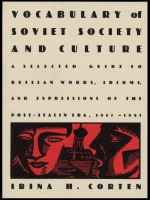 Vocabulary of Soviet Society and Culture: A Selected Guide to Russian Words, Idioms, and Expressions of the Post-Stalin Era, 1953–1991
Irina H. Corten
Duke University Press, 1992 Irina H. Corten's Vocabulary of Soviet Society and Culture is an experiment in what Soviet scholars call lingvostranovedenie—the study of a country and its culture through the peculiarities of its language. Not a conventional dictionary, Corten's lexicon is selective, offering a broad sampling of culturally significant words in the areas of politics, ideology, the economy, education, arts and letters, social problems and everyday life as well as language associated with the personalities and activities of individual Soviet leaders. The entries are listed alphabetically in English transliteration followed by the Cyrillic, although readers familiar with Russian may prefer to use the Cyrillic alphabet listing included in this volume. In each entry, the author provides a succinct but full explanation of the term and, whenever possible, cross-references to other entries, authentic examples of its use, and samples of relevant Soviet jokes. A reader may approach the lexicon either sequentially or with the aid of a subject thesaurus that divides the material into specific topics. A listing of complementary sources of reference appears in a useful bibliography. With this fascinating lexicon of "Sovietisms," Corten provides an invaluable and easily accessible medium for those general readers and scholars of the Russian language and Soviet culture interested in understanding contemporary Soviet life. Selected entries from the Vocabulary of Soviet Society and Culture Anekdótchik (anekdótchitsa) (cyrillic spelling) (n.)
1: A person who tells jokes (anekdoty); 2: coll. since the late Stalin era, a person arrested and given a prison sentence for the telling of political jokes. The phenomenon indicates the important role of the political joke in Soviet culture and, specifically, in the dissident movement. See iazychnik; sident. The following jokes were popular during the Brezhnev era:
1. "Comrade Brezhnev, what is your hobby?"
"Collecting jokes about myself."
"And how many have you collected so far?"
"Two and a half labor camps."
2. Question: What is a marked-down joke?
Answer: A joke which, under Stalin, got you ten years in a labor camp, and now gets you only five. egoístiki (cyrillic) (n.; pl.). Lit., little egotists; coll. since the 1970s referring to headsets worn by music lovers, especially teenage fans of rock music. The idea is that, by wearing headsets, one shuts out the world and becomes indifferent to everything except oneself. zhrál'nia (cyrillic) (n.). Der. zhrat', to gorge, devour (vulg.); coll. since the 1970s denoting an eating establishment with inexpensive and often bad-tasting food. In the late 1980s, the term also has been applied to new fast-food restaurants which have been built in Soviet cities by Western concerns, for example, McDonald's. See amerikanka; stekliashka; stoiachka.
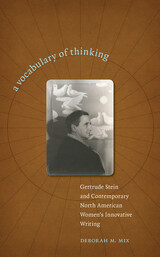 A Vocabulary of Thinking: Gertrude Stein and Contemporary North American Women's Innnovative Writing
Deborah M. Mix
University of Iowa Press, 2007 Using experimental style as a framework for close readings of writings produced by late twentieth-century North American women, Deborah Mix places Gertrude Stein at the center of a feminist and multicultural account of twentieth-century innovative writing. Her meticulously argued work maps literary affiliations that connect Stein to the work of Harryette Mullen, Daphne Marlatt, Betsy Warland, Lyn Hejinian, and Theresa Hak Kyung Cha. By distinguishing a vocabulary-which is flexible, evolving, and simultaneously individual and communal--from a lexicon-which is recorded, fixed, and carries the burden of masculine authority--Mix argues that Stein's experimentalism both enables and demands the complex responses of these authors.
Arguing that these authors have received relatively little attention because of the difficulty in categorizing them, Mix brings the writing of women of color, lesbians, and collaborative writers into the discussion of experimental writing. Thus, rather than exploring conventional lines of influence, she departs from earlier scholarship by using Stein and her work as a lens through which to read the ways these authors have renegotiated tradition, authority, and innovation.
Building on the tradition of experimental or avant-garde writing in the United States, Mix questions the politics of the canon and literary influence, offers close readings of previously neglected contemporary writers whose work doesn't fit within conventional categories, and by linking genres not typically associated with experimentalism-lyric, epic, and autobiography-challenges ongoing reevaluations of innovative writing.
The Vocation of a Teacher: Rhetorical Occasions, 1967-1988
Wayne C. Booth
University of Chicago Press, 1989 This critically acclaimed collection is both a passionate celebration of teaching as a vocation and an argument for rhetoric as the center of liberal education. While Booth provides an eloquent personal account of the pleasures of teaching, he also vigorously exposes the political and economic scandals that frustrate even the most dedicated educators.
"[Booth] is unusually adept at addressing a wide variety of audiences. From deep in the heart of this academic jungle, he shows a clear eye and a firm step."—Alison Friesinger Hill, New York Times Book Review
"A cause for celebration. . . . What an uncommon man is Wayne Booth. What an uncommon book he has provided for our reflection."—James Squire, Educational Leadership
"This book stands as a vigorous reminder of the traditional virtues of the scholar-teacher."—Brian Cox, Times Literary Supplement
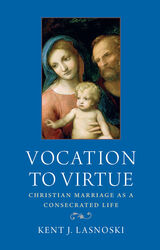 Vocation to Virtue: Christian Marriage as a Consecrated Life
Kent Lasnoski
Catholic University of America Press, 2014 Vocation to Virtue seeks to answer a perennial difficulty in the Catholic theology of marriage: how do the practice and bond of marriage lead to Christian perfection in spouses and their children? If the Second Vatican Council is correct in saying that all in the church are called to Christian perfection, we need an account of how those consecrated in the sacrament of marriage can fulfill that vocation. If the perfection of charity consists in Christ himself, then couples must imitate Christ. But how? If Christ is the poor, chaste, and obedient bridegroom of the church, then spouses achieve holiness inasmuch as they participate in Christ's own virtues: poverty, chastity, and obedience. The thesis is that the language of the evangelical virtues (poverty, chastity, and obedience), a rule of life, and robust preparation (maybe a novitiate) belongs as properly to marriage as to consecrated religious life. Both states are specifications of a common baptismal consecration to Christ himself. Lasnoski seeks to establish this fact and constructively apply this language to conjugal life.
The book begins by explaining our marriage crisis and theological paradigms for speaking about Christian marriage as "relationship" or as "practice," and considers modern scholarly attempts to relate conjugal life and consecrated religious life. The book then offers a theological groundwork in Christ and the Trinity for a deeper, noncompetitive relationship between the consecrated religious life and married life. It offers an Augustinian account of the relationship between marriage and consecrated life, and develops the ecclesial connection between the states with recourse to John's Gospel, which sees Christian life in terms of "householding." The church's tradition has a dialogical relationship between the consecrated and married - a mutual sharing of both "monastic" and "domestic" language. The final chapter develops practices of Christian householding for conjugal life using the language of poverty, chastity, and obedience, a rule of life, and a kind of novitiate preparation.
 Vocational Interest Measurement: Theory and Practice
John G. Darley and Theda Hagenah
University of Minnesota Press, 1955
Vocational Interest Measurement was first published in 1955. Minnesota Archive Editions uses digital technology to make long-unavailable books once again accessible, and are published unaltered from the original University of Minnesota Press editions.
Many years of clinical experience at the University of Minnesota, using the Strong Vocational Interest Bank in counseling services, form the basis for this book. The work will help other counselors to understand the meaning of the interest scores which they obtain with this test. In successive chapters, the authors discuss the meaning of work and jobs in our society, deal with the anatomy of interests, analyze interest patterns and outline a normative framework for their system of analysis, discuss personality factors as related to interests, review theories of origin and development of interests, and illustrate the use of interest measurement in counseling through a series of case studies. A volume in the Minnesota Library on Student Personnel Work.
 Vocational Interests 18 Years After College
Edward K. Strong Jr.
University of Minnesota Press, 1955
Vocational Interests 18 Years After College was first published in 1955. Minnesota Archive Editions uses digital technology to make long-unavailable books once again accessible, and are published unaltered from the original University of Minnesota Press editions.
A pioneer in scientific vocational counseling, Edward K. Strong, Jr., devised the Strong Vocational Interest Blank some years ago as a tool to help the counselor find out what kind of work a young person is best suited for. In this volume Mr. Strong reports on a study which he undertook to determine the validity of the interest blank in predicting the future vocations of individuals.
For this study, the interest scores of several hundred former college students were compared with the occupations in which these men were engaged 18 years later. The results provide answers to basic questions regarding the use of interest scores in vocational counseling. The findings also serve to confirm or modify the conclusions published earlier by Mr. Strong in his book Vocational Interests in Men and Women (a volume for which he was awarded the Butler Silver Medal by Columbia University).
The original group whim the present study is based consisted of 884 Stanford University graduates whose interests had been revealed by the use of the Vocational Interest Blank while they were in college. Follow-up data on their actual careers are presented and analyzed for approximately three fourths of this number, the remainder being eliminated because they were engaged in occupations for which no specific scales were available.
In addition to revising and amplifying Mr. Strong's earlier work on the subject, this volume outlines a number of developments which provoke new problems and point the way for future research.
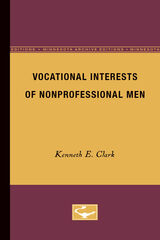 Vocational Interests of NonProfessional Men
Kenneth Clark
University of Minnesota Press, 1961
Vocational Interests of Non-Professional Men was first published in 1961.In contrast to most psychological research about occupational interests and related achievement, which has centered on professional and managerial occupations, the study reported here deals with the vocational interests of skilled trades workers. The study is important because, among young people not planning to go to college, many each year select occupations when they have only fragmentary information about the occupation and its requirements and about their own characteristics and needs; the findings of this study will contribute to better counseling of such young people in the future.Dr. Clark’s investigation is based on the responses of approximately 25,000 persons to the Minnesota Vocational Interest Inventory. About 6,000 of the subjects were civilians and the rest were enlisted personnel in the U.S. Navy. He describes the development of the Minnesota Vocational Interest Inventory and of scoring keys for use with it, examines the characteristics of these keys, and summarizes various studies of the psychometric characteristics of keys developed by different methods. He discusses use of keys in classifying individuals into occupational groups, then turns to the use of interest measures in predicting achievement and choice of specialty. In conclusion he suggests ways in which improved interest measures may be developed to the end that there may be not only better counseling of individuals but also greater understanding of the processes by which occupational choices occur.Vocational counselors, industrial psychologists, personnel managers, and psychometrists will find the book especially useful.
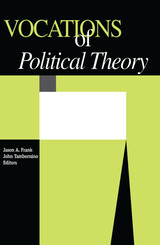 Vocations Of Political Theory
Jason A. Frank
University of Minnesota Press, 2000 Eminent and emerging thinkers seek to bridge the gap between political thought and political action. Political Science Eminent and emerging thinkers seek to bridge the gap between political thought and political action. Written by scholars with a rare sense of the historical and conceptual breadth of politics and theory, the essays in this volume explore possibilities for political theory in a world marked by disorienting political transformations. In doing so, they document and address the character and status of contemporary political theory, its changing place in the academy, and its role in public life. Whether challenging the settlement between political theory and political science, whereby theorists stuck to the "old texts" and left the "real world" to their empirical colleagues, or interrogating the relationship between political theory and political action, these essays expand and elaborate the parameters of political discourse-making their timeliness, relevance, and reach powerfully apparent.Contributors: Mark B. Brown; Wendy Brown, UC Santa Cruz; William E. Connolly, Johns Hopkins U; Thomas L. Dumm, Amherst College; J. Peter Euben, UC Santa Cruz; Russell Arben Fox; Samantha Frost, UC Santa Cruz; Shane Gunster; Jill Locke, Gustavus Adolphus College; David Paul Mandell, Reed College; Lon Troyer; Sheldon S. Wolin; Linda M. B. Zerilli, Northwestern U.Translation Inquiries: University of Minnesota Press
Voces Femeninas de Hispanoamerica
Gloria Bautista Gutiérrez
University of Pittsburgh Press, 1996 Voces Femeninas de Hispanoamerica presents in one volume a selection of the most representative and outstanding writing by Latin American women writers from the seventeenth century to the present. Designed as a text for third and fourth-year students, the selections, writers’ biographies, historical introduction, and appendixes are entirely in Spanish, with notes to help students with difficult words or passages.
 Vodou Nation: Haitian Art Music and Cultural Nationalism
Michael Largey
University of Chicago Press, 2006 While the Haitian musical tradition is probably best known for the Vodou-inspired roots music that helped topple the two-generation Duvalier dictatorship, the nation’s troubled history of civil unrest and its tangled relationship with the United States is more intensely experienced through its art music, which combines French and German elements of classical music with Haiti's indigenous folk music. Vodou Nation examines art music by Haitian and African American composers who were inspired by Haiti’s history as a nation created by slave revolt.
Around the time of the United States’s occupation of Haiti in 1915, African American composers began to incorporate Vodou-inspired musical idioms to showcase black artistry and protest white oppression. Together with Haitian musicians, these composers helped create what Michael Largey calls the “Vodou Nation,” an ideal vision of Haiti that championed its African-based culture as a bulwark against America’s imperialism. Highlighting the contributions of many Haitian and African American composers who wrote music that brought rhythms and melodies of the Vodou ceremony to local and international audiences, Vodou Nation sheds light on a black cosmopolitan musical tradition that was deeply rooted in Haitian culture and politics.
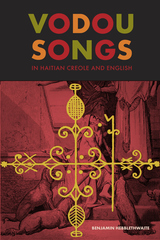 Vodou Songs in Haitian Creole and English
Benjamin Hebblethwaite
Temple University Press, 2011 Vodou songs constitute the living memory of Haitian Vodou communities, and song texts are key elements to understanding Haitian culture. Vodou songs form a profound religious and cultural heritage that traverses the past and refreshes the present. Offering a one-of-a-kind research tool on Vodou and its cultural roots in Haiti and pre-Haitian regions, Vodou Songs in Haitian Creole and English provides a substantial selection of hard to find or unpublished sacred Vodou songs in a side-by-side bilingual format. Esteemed scholar Benjamin Hebblethwaite introduces the language, mythology, philosophy, origins, and culture of Vodou through several chapters of source songs plus separate analytical chapters. He guides readers through songs, chants, poems, magical formulae, invocations, prayers, historical texts and interviews, as well as Haitian Creole grammar and original sacred literature. An in-depth dictionary of key Vodou terms and concepts is also provided. This corpus of songs and the research about them provide a crucial understanding of the meaning of Vodou religion, language, and culture.
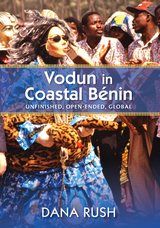 Vodun in Coastal Benin: Unfinished, Open-Ended, Global
Dana Rush
Vanderbilt University Press, 2013 Centered on the former slaving port of Ouidah, Benin, Dana Rush's research extends through Togo to Ghana, a region where exchanges of histories, ideas, and belief systems are given material forms. This is a land where Shango, Jesus, and the Buddha are all gods of Vodun; where Hindu and Vodun deities co-exist in symbiosis; where the spirits of people enslaved 150 years ago are paid tribute by the children of their long-lost masters; and where Haitian, Brazilian, and Cuban images, artists, and spirits remain relevant to contemporary West African practices. The book is richly illustrated with color photographs of Vodun shrines, temple wall paintings, masquerades, and Hindu chromolithographs.
This book is the first publication in a new series called "Critical Investigations of the African Diaspora." The series grows out of Issues in Critical Investigation, a Vanderbilt initiative to assist junior scholars through critical feedback from senior faculty, annual symposia, and prize competitions in the humanities and social sciences. Dana Rush's Vodun in Coastal Benin is the winner of the inaugural Anna Julia Cooper Prize in the Humanities.
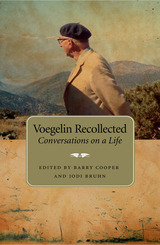 Voegelin Recollected: Conversations on a Life
Edited by Barry Cooper & Jodi Bruhn
University of Missouri Press, 2007 Although his contributions to philosophy are revered and his writings have been collected, Eric Voegelin’s persona will inevitably fade with the memories of those who knew him. This book preserves the human element of Voegelin by capturing those valuable personal recollections. Barry Cooper and Jodi Bruhn conducted intensive interviews with Voegelin’s wife, his closest friends, and his first-generation students—many of whom have since passed on—in order to bring to print everything important about his life and personality. American scholars will especially appreciate the glimpses provided by Voegelin’s German colleagues into his life in Munich, as well as the thoughts of his students in Vienna. Reflections of people such as Paul Caringella, Bruno Schlesinger, and Heinz Barazon capture Voegelin’s greatness and shortcomings alike and also shed new light on his philosophical quest for truth. By descending progressively further into the past, the book takes readers deeper into the essence of Voegelin as reminiscences become more dramatic. Ranging widely from America back to Germany—with recollections of Gestapo intimidation and eventual emigration—the accounts interweave episodes of pathos, humor, fear, rivalry, and ambition. We witness Voegelin’s persistent and partly self-imposed communication problems and impatience with administrative duties, his respect for prudent political actors and public servants, and his genuine affection not only for his colleagues and best students but also for diligent secretaries and empathetic nurses. Through these recollections, key elements of his personality repeatedly emerge: his intelligence, optimism, and integrity, combined with an acute perception of the significance of his work. This is the most revealing and comprehensive biographical work yet available on a man known to be captivating as a thinker—and now shown to be equally fascinating as a human being. His own publications attest to his mind and methods; Voegelin Recollected provides a deeper understanding of the man himself.
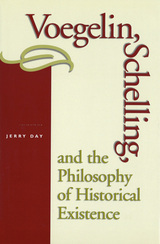 Voegelin, Schelling, and the Philosophy of Historical Existence
Jerry Day
University of Missouri Press, 2003 In this important new work, Jerry Day brings to light the need for an extensive reinterpretation of the mature philosophy of Eric Voegelin, based on Voegelin’s published and unpublished appreciation for nineteenth-century German philosopher F. W. J. Schelling. Schelling, whom Day maintains was one of the most important guides to Voegelin’s mature philosophy of consciousness and historiography, has been described as the father of several disparate movements and schools of continental philosophy—chief among them being “Hegelian” idealism and existentialism. This characterization implies that Schelling was a scattered thinker with little or no appreciation for philosophy as a disciplined inquiry into the nature of human affairs. Voegelin was critical of this portrayal of Schelling. He argued that it lacked proper sensitivity for the impressive extent to which this giant of continental thought was able to rise above the “creed communities” of his time and recover the abiding concern of mature philosophers everywhere: the philosophia perennis. Those who claim that Schelling was scattered have failed, according to Voegelin, to appreciate the nonideological breadth of this great philosopher, misled by the splinter movements and schools that arose from mere fragments of his thought. In truth, Schelling founded no school and launched no movement. Instead, he reasoned with the disciplined integrity and wonder of a “spiritual realist.” Day argues that Voegelin was a fine interpreter of Schelling, particularly during the decisive years when the central orientation of Voegelin’s mature thought was beginning to take hold—between the writing of his History of Political Ideas and its eventual transformation into Order and History. Day gathers an impressive array of evidence to interpret Voegelin’s little-known support for Schelling’s achievements, while offering detailed analyses and helpful summaries of a vast body of literature that has yet to be translated into English. Day’s partial agreement with Voegelin’s uncommon assessment of Schelling provides him with the point of departure that leads to one of this book’s most distinctive contributions to contemporary thought. It has the rare ability to help clear the way for philosophical realists to make peace with many of their contemporaries, giving them further grounds for accepting the strongest anthropological and psychological insights of recent continental philosophy, while helping them to avoid its tendencies toward nihilistic despair or fideistic historicism. By reading each philosopher through the eyes of the other, Day provides an analysis that will be illuminating for Voegelin scholars and Schelling scholars alike. The book will also appeal to readers with more general interests in the history and development of continental philosophy, political theory, and comparative religion over the past century.
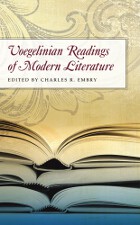 Voegelinian Readings of Modern Literature
Edited by Charles R. Embry
University of Missouri Press, 2011 The work of renowned thinker Eric Voegelin is largely rooted in his literary sensibility. Voegelin’s contributions to the field of philosophy grew from the depths of his knowledge of history’s most important texts, from ancient to modern times. Many of the concepts he emphasized, such as participatory experience and symbolization in philosophy, have long been significant to literary criticism as well as philosophical study. Voegelin himself even ventured into the field of criticism, publishing a critical examination of Henry James’s The Turn of the Screw in 1971. Since it is so strongly influenced by the written record of man’s search for meaning, Voegelinian thought makes an ideal framework for the study of twentieth-century literature.
For Voegelinian Readings of Modern Literature, scholar Charles R. Embry has collected essays that consider particular pieces of literature in light of the philosopher’s work. These essays supply a theoretical grounding for the reading of novels, poems, and plays and reveal how the Voegelinian perspective exposes the existential and philosophical dimensions of the literary works themselves. As a unit, this collection of essays shows how modern pieces of literature can symbolize their creators’ participation in the human search for the truth of existence—just as myths, philosophical works, and religious texts always have.
Voegelin’s primary concern as a philosopher was to expose the roots of the disturbances of the modern era—religious conflict, imperialism, war—so that the sources of order leading to meaning are revealed. The openness of Voegelinian thought and the many ways he considered the levels of reality generate intriguing themes for literary criticism. In these essays, noted Voegelin scholars focus on American and European literary artists from the 1700s through the late twentieth century, including Emily Dickinson, Henrik Ibsen, Thomas Carlyle, D. H. Lawrence, Marcel Proust, and Hermann Broch.
While the intersection of the work of Eric Voegelin and literature has been a part of Voegelin scholarship for decades, this book explores that relationship in an extended form. Through a broad collection of thoughtful essays, Voegelinian Readings of Modern Literature reveals how much Voegelin did to break down the barriers between literature and philosophy and makes an engaging contribution to Voegelin scholarship.
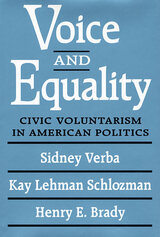 Voice and Equality: Civic Voluntarism in American Politics
Sidney Verba, Kay Lehman Schlozman, and Henry E. Brady
Harvard University Press, 1995 This book confirms Alexis de Tocqueville’s idea, dating back a century and a half, that American democracy is rooted in civil society. Citizens’ involvement in family, school, work, voluntary associations, and religion has a significant impact on their participation as voters, campaigners, donors, community activists, and protesters.
The authors focus on the central issues of involvement: how people come to be active and the issues they raise when they do. They find fascinating differences along cultural lines, among African-Americans, Latinos, and Anglo-Whites, as well as between the religiously observant and the secular. They observe family activism moving from generation to generation, and they look into the special role of issues that elicit involvement, including abortion rights and social welfare.
This far-reaching analysis, based on an original survey of 15,000 individuals, including 2,500 long personal interviews, shows that some individuals have a greater voice in politics than others, and that this inequality results not just from varying inclinations toward activity, but also from unequal access to vital resources such as education. Citizens’ voices are especially unequal when participation depends on contributions of money rather than contributions of time. This deeply researched study brilliantly illuminates the many facets of civic consciousness and action and confirms their quintessential role in American democracy.
Voice and Grammatical Functions in Austronesian Languages
Edited by Peter K. Austin and Simon Musgrave
CSLI, 2005 This volume explores various problems in the syntax of Austronesian languages, which are found primarily in Malaysia and the Polynesian islands. Using the framework of constraint-based theories of syntax, contributors discuss the nature of these voice systems, the function of their verbal morphology, valence, verbal diathesis and transitivity in such languages, and the nature of their lexical categories. Each analysis is presented within the frameworks of lexical-functional grammar and head-driven phrase structure grammar.
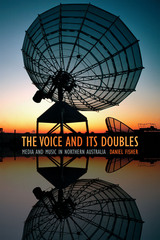 The Voice and Its Doubles: Media and Music in Northern Australia
Daniel Fisher
Duke University Press, 2016 Beginning in the early 1980s Aboriginal Australians found in music, radio, and filmic media a means to make themselves heard across the country and to insert themselves into the center of Australian political life. In The Voice and Its Doubles Daniel Fisher analyzes the great success of this endeavor, asking what is at stake in the sounds of such media for Aboriginal Australians. Drawing on long-term ethnographic research in northern Australia, Fisher describes the close proximity of musical media, shifting forms of governmental intervention, and those public expressions of intimacy and kinship that suffuse Aboriginal Australian social life. Today’s Aboriginal media include genres of country music and hip-hop; radio requests and broadcast speech; visual graphs of a digital audio timeline; as well as the statistical media of audience research and the discursive and numerical figures of state audits and cultural policy formation. In each of these diverse instances the mediatized voice has become a site for overlapping and at times discordant forms of political, expressive, and institutional creativity.
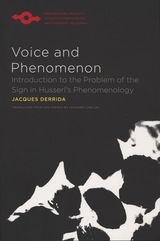 Voice and Phenomenon: Introduction to the Problem of the Sign in Husserl's Phenomenology
Jacques Derrida, Translated from the French by Leonard Lawlor
Northwestern University Press, 2011 Published in 1967, when Derrida is 37 years old, Voice and Phenomenon appears at the same moment as Of Grammatology and Writing and Difference. All three books announce the new philosophical project called “deconstruction.” Although Derrida will later regret the fate of the term “deconstruction,” he will use it throughout his career to define his own thinking. While Writing and Difference collects essays written over a 10 year period on diverse figures and topics, and Of Grammatology aims its deconstruction at “the age of Rousseau,” Voice and Phenomenon shows deconstruction engaged with the most important philosophical movement of the last hundred years: phenomenology.
Only in relation to phenomenology is it possible to measure the importance of deconstruction. Only in relation to Husserl’s philosophy is it possible to understand the novelty of Derrida’s thinking. Voice and Phenomenon therefore may be the best introduction to Derrida’s thought in general. To adapt Derrida’s comment on Husserl’s Logical Investigations, it contains “the germinal structure” of Derrida’s entire thought. Lawlor’s fresh translation of Voice and Phenomenon brings new life to Derrida’s most seminal work.
 Voice and Vision: A Guide to Writing History and Other Serious Nonfiction
Stephen J. Pyne
Harvard University Press, 2009 It has become commonplace these days to speak of “unpacking” texts. Voice and Vision is a book about packing that prose in the first place. While history is scholarship, it is also art—that is, literature. And while it has no need to emulate fiction, slump into memoir, or become self-referential text, its composition does need to be conscious and informed.
Voice and Vision is for those who wish to understand the ways in which literary considerations can enhance nonfiction writing. At issue is not whether writing is scholarly or popular, narrative or analytical, but whether it is good. Fiction has guidebooks galore; journalism has shelves stocked with manuals; certain hybrids such as creative nonfiction and the new journalism have evolved standards, esthetics, and justifications for how to transfer the dominant modes of fiction to topics in nonfiction. But history and other serious or scholarly nonfiction have nothing comparable.
Now this curious omission is addressed by Stephen Pyne as he analyzes and teaches the craft that undergirds whole realms of nonfiction and book-based academic disciplines. With eminent good sense concerning the unique problems posed by research-based writing and with a wealth of examples from accomplished writers, Pyne, an experienced and skilled writer himself, explores the many ways to understand what makes good nonfiction, and explains how to achieve it. His counsel and guidance will be invaluable to experts as well as novices in the art of writing serious and scholarly nonfiction.
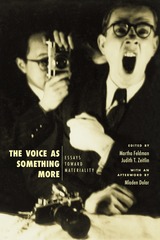 The Voice as Something More: Essays toward Materiality
Edited by Martha Feldman and Judith T. Zeitlin
University of Chicago Press, 2019 In the contemporary world, voices are caught up in fundamentally different realms of discourse, practice, and culture: between sounding and nonsounding, material and nonmaterial, literal and metaphorical. In The Voice as Something More, Martha Feldman and Judith T. Zeitlin tackle these paradoxes with a bold and rigorous collection of essays that look at voice as both object of desire and material object.
Using Mladen Dolar’s influential A Voice and Nothing More as a reference point, The Voice as Something More reorients Dolar’s psychoanalytic analysis around the material dimensions of voices—their physicality and timbre, the fleshiness of their mechanisms, the veils that hide them, and the devices that enhance and distort them. Throughout, the essays put the body back in voice. Ending with a new essay by Dolar that offers reflections on these vocal aesthetics and paradoxes, this authoritative, multidisciplinary collection, ranging from Europe and the Americas to East Asia, from classics and music to film and literature, will serve as an essential entry point for scholars and students who are thinking toward materiality.
Voice Biometrics: Technology, trust and security
Carmen García-Mateo
The Institution of Engineering and Technology, 2021 Voice biometrics are being implemented globally in large scale applications such as remote banking, government e-services, transportation and building security access, autonomous vehicles, and healthcare. They have been integrated in numerous apps, often coupled with face biometrics and artificial intelligence methods. Voice biometrics products and solutions must meet three key requirements for the success in their deployment: they must be highly trustable regarding privacy protection; easy to use and always be available.
 A Voice but No Power: Organizing for Social Justice in Minneapolis
David Forrest
University of Minnesota Press, 2022 Examining the work of social justice groups in Minneapolis following the 2008 recession
Since the Great Recession, even as protest and rebellion have occurred with growing frequency, many social justice organizers continue to displace as much as empower popular struggles for egalitarian and emancipatory change. In A Voice but No Power, David Forrest explains why this is the case and explores how these organizers might better reach their potential as advocates for the abolition of exploitation, discrimination, and other unjust conditions. Through an in-depth study of post-2008 Minneapolis—a center of progressive activism—Forrest argues that social justice organizers so often fall short of their potential largely because of challenges they face in building what he calls “contentious identities,” the public identities they use to represent their constituents and counteract stigmatizing images such as the “welfare queen” or “the underclass.” In the process of assembling, publicizing, and legitimating contentious identities, he shows, these organizers encounter a series of political hazards, each of which pushes them to make choices that weaken movements for equality and freedom. Forrest demonstrates that organizers can achieve better outcomes, however, by steadily working to remake their hazardous political terrain. The book’s conclusion reflects on the 2020 uprising that followed the police killing of George Floyd, assessing what it means for the future of social justice activism. Ultimately, Forrest’s detailed analysis contributes to leading theories about organizing and social movements and charts possibilities for further emboldening grassroots struggles for a fairer society.
 Voice, Choice, and Action: The Potential of Young Citizens to Heal Democracy
Felton Earls and Mary Carlson
Harvard University Press, 2020 Compiling decades of fieldwork, two acclaimed scholars offer strategies for strengthening democracies by nurturing the voices of children and encouraging public awareness of their role as citizens.
Voice, Choice, and Action is the fruit of the extraordinary personal and professional partnership of a psychiatrist and a neurobiologist whose research and social activism have informed each other for the last thirty years. Inspired by the 1989 United Nations Convention on the Rights of the Child, Felton Earls and Mary Carlson embarked on a series of international studies that would recognize the voice of children. In Romania they witnessed the consequences of infant institutionalization under the Ceaușescu regime. In Brazil they encountered street children who had banded together to advocate effectively for themselves. In Chicago Earls explored the origins of prosocial and antisocial behavior with teenagers. Children all over the world demonstrated an unappreciated but powerful interest in the common good.
On the basis of these experiences, Earls and Carlson mounted a rigorous field study in Moshi, Tanzania, which demonstrated that young citizens could change attitudes about HIV/AIDS and mobilize their communities to confront the epidemic. The program, outlined in this book, promoted children’s communicative and reasoning capacities, guiding their growth as deliberative citizens. The program’s success in reducing stigma and promoting universal testing for HIV exceeded all expectations.
Here in vivid detail are the science, ethics, and everyday practice of fostering young citizens eager to confront diverse health and social challenges. At a moment when adults regularly profess dismay about our capacity for effective action, Voice, Choice, and Action offers inspiration and tools for participatory democracy.
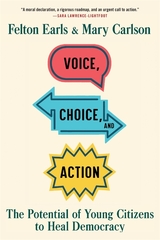 Voice, Choice, and Action: The Potential of Young Citizens to Heal Democracy
Felton Earls and Mary Carlson
Harvard University Press “A book for these times as we confront the fault lines in our democracy…A deeply provocative work about the place of children in strengthening our sense of community.”
—Alex Kotlowitz, author of There Are No Children Here
“Earls and Carlson have discovered…an aspect of development previously unrecognized: how children and youth can find their voice, feel empowered to use that voice, and translate that voice into political action. This is a remarkable book.”
—Gordon Harper, Journal of the American Academy of Child & Adolescent Psychiatry
“An inspiring vision of a newly inclusive democracy.”
—Kirkus Reviews (starred review)
Voice, Choice, and Action is the fruit of the extraordinary personal and professional partnership between a psychiatrist and neurobiologist whose research and social activism have informed each other for the last thirty years. Inspired by the UN Convention on the Rights of the Child, Felton Earls and Mary Carlson embarked on a series of studies to help children find their voice in the adult world. In Romania, they saw the devastating consequences of infant institutionalization. In Brazil, they found street children who had banded together to advocate for themselves. In Chicago, Earls sought to understand the origins of antisocial behavior in teenagers, and in Tanzania, they piloted a program to guide children’s growth as deliberative citizens.
Here in vivid detail are the science, ethics, and everyday practices needed to foster young citizens eager to confront social challenges. At a moment when adults regularly decry the state of our democracy, Voice, Choice, and Action offers invaluable tools to build a new generation of active citizens.
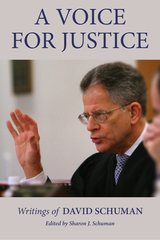 A Voice for Justice: Writings of David Schuman
Sharon Schuman
Oregon State University Press, 2021 As an educator, speaker, deputy attorney general, and judge, David Schuman was known for his ability to clarify difficult legal concepts. According to James Egan, chief judge of the Oregon Court of Appeals, he was the “intellectual giant of our generation.” A Voice for Justice reveals how David Schuman’s unique jurisprudence came to be.
His friends and associates knew that Oregon Supreme Court Justice Hans Linde convinced Schuman to turn to the Oregon Constitution rather than the federal one to protect individual rights. But even some of Schuman’s closest friends were unaware of his fiction, which provides a window into his deep capacity for empathy and casts new light on his ability to write elegant, sometimes funny, judicial opinions. His legal thinking also had deep roots in literature and political theory.
Schuman’s 672 judicial opinions are not just brilliant, but written so that anyone can understand them. Like Ruth Bader Ginsburg, he knew there was nothing to gain by communicating only to specialists. He wanted citizens to be able to make up their own minds about important issues.
A Voice for Justice brings together for the first time writings that span over fifty years. Lawyers and laypeople alike will appreciate Schuman’s lucid, engaging observations, which are highly relevant to our current anxieties about institutional racism and democracy under stress. The short stories, speeches, op-eds, articles, legal opinions, and dissents selected for this volume constitute a call to action for everyone to become voices for justice.
A Voice from the River: A Novel
Dan Gerber
Michigan State University Press, 2005 This novel is one of Dan Gerber's triumphs. From the author of American Atlas, Out of Control, and Grass Fires, Gerber's A Voice From the River followed Grass Fires to prominence on national bestseller lists. This novel once again affirms the Gerber's solid reputation for writing about the confrontation of the Spirit World and what some consider to be the Last of Days.
 The Voice Imitator
Thomas Bernhard
University of Chicago Press, 1997 The Austrian playwright, novelist, and poet Thomas Bernhard (1931-89) is acknowledged as among the major writers of our times. At once pessimistic and exhilarating, Bernhard's work depicts the corruption of the modern world, the dynamics of totalitarianism, and the interplay of reality and appearance.
In this stunning translation of The Voice Imitator, Bernhard gives us one of his most darkly comic works. A series of parable-like anecdotes—some drawn from newspaper reports, some from conversation, some from hearsay—this satire is both subtle and acerbic. What initially appear to be quaint little stories inevitably indict the sterility and callousness of modern life, not just in urban centers but everywhere. Bernhard presents an ordinary world careening into absurdity and disaster. Politicians, professionals, tourists, civil servants—the usual victims of Bernhard's inspired misanthropy—succumb one after another to madness, mishap, or suicide. The shortest piece, titled "Mail," illustrates the anonymity and alienation that have become standard in contemporary society: "For years after our mother's death, the Post Office still delivered letters that were addressed to her. The Post Office had taken no notice of her death."
In his disarming, sometimes hilarious style, Bernhard delivers a lethal punch with every anecdote. George Steiner has connected Bernhard to "the great constellation of Kafka, Musil, and Broch," and John Updike has compared him to Grass, Handke, and Weiss. The Voice Imitator reminds us that Thomas Bernhard remains the most caustic satirist of our age.
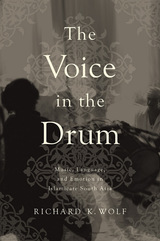 The Voice in the Drum: Music, Language, and Emotion in Islamicate South Asia
Richard K. Wolf
University of Illinois Press, 2014 Based on extensive field research in India and Pakistan, this new study examines the ways drumming and voices interconnect over vast areas of South Asia and considers what it means for instruments to be voice-like and carry textual messages in particular contexts. Richard K. Wolf employs a hybrid, novelistic form of presentation, in which a fictional protagonist interacts with Wolf's field consultants, to communicate ethnographic and historical realities that transcend the local details of any one person's life. The narrative explores how the themes of South Asian Muslims and their neighbors coming together, moving apart, and relating to God and spiritual intermediaries resonate across ritual and expressive forms such as drumming and dancing. Wolf weaves in the story of a family led by Ahmed Ali Khan, a North Indian ruler who revels in the glories of 19th century life, when many religious communities joined together harmoniously in grand processions. His journalist son Muharram Ali obsessively scours the subcontinent in pursuit of a music he naively hopes will dissolve religious and political barriers. The story charts the breakdown of this naiveté. A daring narrative of music, religion and politics in late twentieth century South Asia, The Voice in the Drum delves into the social and religious principles around which Muslims, Hindus, and others bond, create distinctions, reflect upon one another, or decline to acknowledge differences.
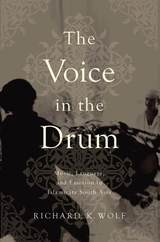 Voice in the Drum: Music, Language, and Emotion in Islamicate South Asia
Richard Wolf
University of Illinois Press, 2017 Based on extensive research in India and Pakistan, this new study examines the ways drumming and voices interconnect over vast areas of South Asia and considers what it means for instruments to be voice-like and carry textual messages in particular contexts. Richard K. Wolf employs a hybrid, novelistic form of presentation in which the fictional protagonist Muharram Ali, a man obsessed with finding music he believes will dissolve religious and political barriers, interacts with Wolf's field consultants, to communicate ethnographic and historical realities that transcend the local details of any one person's life. The result is a daring narrative that follows Muharram Ali on a journey that explores how the themes of South Asian Muslims and their neighbors coming together, moving apart, and relating to God and spiritual intermediaries resonate across ritual and expressive forms such as drumming and dancing.
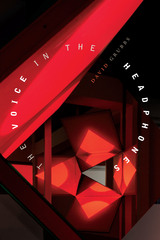 The Voice in the Headphones
David Grubbs
Duke University Press, 2020 The voice in the headphones says, “you’re rolling” . . .
The Voice in the Headphones is an experiment in music writing in the form of a long poem centered on the culture of the recording studio. It describes in intricate, prismatic detail one marathon day in a recording studio during which an unnamed musician struggles to complete a film soundtrack. The book extends the form of Grubbs's previous volume Now that the audience is assembled, sharing its goal of musicalizing the language of writing about music. Mulling the insight that “studio is the absence of pushback”—now that no audience is assembled—The Voice in the Headphones details one musician's strategies for applying the requisite pressure to the proceedings, for making it count. The Voice in the Headphones is both a literary work and a meditation on sound recording, delivered at a moment in which the commercial recording studio shades into oblivion. It draws upon Grubbs's own history of several decades as a recording artist, and its location could be described as every studio in which he has set foot.
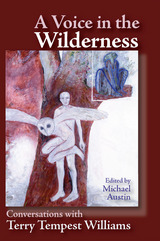 Voice in the Wilderness: Conversations with Terry Tempest Williams
edited by Michael Austin
Utah State University Press, 2006 In her writings, Terry Tempest Williams repeatedly invites us as readers into engagement and conversation with both her and her subject matter, whether it is nature or society, environment or art. From her evocation, in Desert Quartet: An Erotic Landscape, of an eroticism of place that defines erotic as "in relation," to the spiritual connectivity and familial bonds she explores in Refuge: An Unnatural History of Family and Place and the political engagement she urges in The Open Space of Democracy, much of her work is about relationship, connection, and community. Like much good writing, her books invite readers into thoughtful dialogue with the text. Frequently in demand for workshops, lectures, and other speaking venues and well known as an environmental activist, Williams has a public persona and voice almost indistinguishable from her written ones. Thus, the interviews she has often granted--in print, on the radio, on the Web--seamlessly elaborate the ideas and extend the explorations of her written texts. They also tell us much about the genesis, context, and intent of her books. With her distinctive, impassioned voice and familiar felicity of language, she talks about wilderness and wildlife, place and eroticism, art and literature, democracy and politics, family and heritage, Mormonism and religion, writing and creativity, and other subjects that engage her agile mind. The set of interviews gathered and introduced by Michael Austin in A Voice in the Wilderness represent the span of Terry Tempest Williams's career as a naturalist, author, and activist.
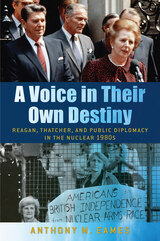 A Voice in Their Own Destiny: Reagan, Thatcher, and Public Diplomacy in the Nuclear 1980s
Anthony M. Eames
University of Massachusetts Press, 2023 On June 8, 1982, Ronald Reagan delivered a historic address to the British Parliament, promising that the United States would give people around the world “a voice in their own destiny” in the struggle against Soviet totalitarianism. While British Prime Minister Margaret Thatcher celebrated Reagan’s visit and thanked him for putting “freedom on the offensive,” over 100,000 Britons marched from Hyde Park to Trafalgar Square to protest his arrival and call for nuclear disarmament. Reagan’s homecoming was equally eventful, with 1,000,000 protesters marking his return with a rally for nuclear disarmament in Central Park—the largest protest in American history up to that point. Employing a wide range of previously unexamined primary sources, Anthony M. Eames demonstrates how the Reagan and Thatcher administrations used innovations in public diplomacy to build back support for their foreign policy agendas at a moment of widespread popular dissent. A Voice in Their Own Destiny traces how competition between the governments of Reagan and Thatcher, the Anglo-American antinuclear movement, and the Soviet peace offensive sparked a revolution in public diplomacy.
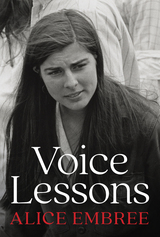 Voice Lessons
By Alice Embree
University of Texas Press, 2021 Voice Lessons explores the rich personal and political terrain of Alice Embree, a 1960s activist and convert to the women’s liberation movement of the 1970s, bringing a woman’s perspective to a transformational time in US history. This riveting memoir traces the author’s roots in segregated Austin and her participation in efforts to integrate the University of Texas. It follows her antiwar activism from a vigil in front of President Lyndon Johnson’s ranch in 1965 to a massive protest after the shootings at Kent State in 1970. Embree’s activism brought her and the Students for a Democratic Society into conflict with Frank Erwin, the powerful chairman of the UT Board of Regents, and inspired a campus free speech movement. She recounts her experiences living in New York during the tumultuous years of 1968 and 1969, including the Columbia University strike and the Woodstock music festival. She also tells about protesting at the Chicago Democratic Convention, her interactions with Yippies and poets, and her travels to Chile, Cuba, and Mexico. Embree highlights the radical roots of the women’s liberation movement in Austin and the audacious women’s community that challenged gender roles, fought for reproductive justice, and inspired a lifetime of activism.
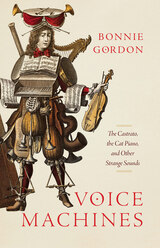 Voice Machines: The Castrato, the Cat Piano, and Other Strange Sounds
Bonnie Gordon
University of Chicago Press, 2023 An exploration of the castrato as a critical provocation to explore the relationships between sound, music, voice instrument, and machine.
Italian courts and churches began employing castrato singers in the late sixteenth century. By the eighteenth century, the singers occupied a celebrity status on the operatic stage. Constructed through surgical alteration and further modified by rigorous training, castrati inhabited human bodies that had been “mechanized” to produce sounds in ways that unmechanized bodies could not. The voices of these technologically enhanced singers, with their unique timbre, range, and strength, contributed to a dramatic expansion of musical vocabulary and prompted new ways of imagining sound, the body, and personhood.
Connecting sometimes bizarre snippets of history, this multi-disciplinary book moves backward and forward in time, deliberately troubling the meaning of concepts like “technology” and “human.” Voice Machines attends to the ways that early modern encounters and inventions—including settler colonialism, emergent racialized worldviews, the printing press, gunpowder, and the telescope—participated in making castrati. In Bonnie Gordon’s revealing study, castrati serve as a critical provocation to ask questions about the voice, the limits of the body, and the stories historians tell.
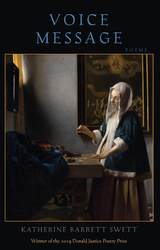 Voice Message
Katherine Barrett Swett
Autumn House Press, 2020 Through the poems of Voice Message, Katherine Barrett Swett reflects on her personal tragedy and the fragility of human lives and bodies with a tender care. Her debut collection explores the powers of art and poetry to participate in the processing of catastrophic grief, speaking through both the consolation and devastation these creative works can offer. Swett’s formal verse provides a lens through which sadness, destruction, and loss appear as aberrant and inevitable. In tragic lyric, the poet searches poetry, art, mythology, and her own memory for the fleeting image of her lost daughter “in music, painting, or a carved stone name.” Frequently looking to visual arts for inspiration, she finds that Vermeer’s paintings of distant rooms guide and contextualize pain, offering motivation, comfort, and release. Through villanelles, sonnets, quatrains, and free verse, Swett invokes the voices, narratives, and images, both personal and cultural, that haunt her speakers. Suspended in the aftermath of the unexpected and unspeakable death of her college-age daughter, the poet’s language is held together in a somber and necessary restraint. But this restraint does not signal the peace of closure. Rather, these poems quietly and steadily remind readers it is still “the open wound / not the scar,” that “all we have are words and flesh,” and that we are forever vulnerable. The rhythm of and echoes of sonnets and songs lead us to the sticky intersections of tragedy, recovery, and strange forms of beauty.
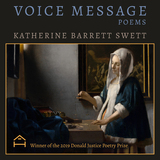 Voice Message
Katherine Barrett Swett
Autumn House Press, 2020 Through the poems of Voice Message, Katherine Barrett Swett reflects on her personal tragedy and the fragility of human lives and bodies with a tender care. Her debut collection explores the powers of art and poetry to participate in the processing of catastrophic grief, speaking through both the consolation and devastation these creative works can offer. Swett’s formal verse provides a lens through which sadness, destruction, and loss appear as aberrant and inevitable. In tragic lyric, the poet searches poetry, art, mythology, and her own memory for the fleeting image of her lost daughter “in music, painting, or a carved stone name.” Frequently looking to visual arts for inspiration, she finds that Vermeer’s paintings of distant rooms guide and contextualize pain, offering motivation, comfort, and release. Through villanelles, sonnets, quatrains, and free verse, Swett invokes the voices, narratives, and images, both personal and cultural, that haunt her speakers. Suspended in the aftermath of the unexpected and unspeakable death of her college-age daughter, the poet’s language is held together in a somber and necessary restraint. But this restraint does not signal the peace of closure. Rather, these poems quietly and steadily remind readers it is still “the open wound / not the scar,” that “all we have are words and flesh,” and that we are forever vulnerable. The rhythm of and echoes of sonnets and songs lead us to the sticky intersections of tragedy, recovery, and strange forms of beauty.
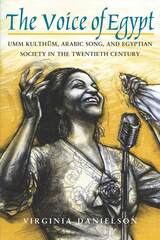 "The Voice of Egypt": Umm Kulthum, Arabic Song, and Egyptian Society in the Twentieth Century
Virginia Danielson
University of Chicago Press, 1997 Umm Kulthum, the "voice of Egypt," was the most celebrated musical performer of the century in the Arab world. More than twenty years after her death, her devoted audience, drawn from all strata of Arab society, still numbers in the millions. Thanks to her skillful and pioneering use of mass media, her songs still permeate the international airwaves. In the first English-language biography of Umm Kulthum, Virginia Danielson chronicles the life of a major musical figure and the confluence of artistry, society, and creativity that characterized her remarkable career.
Danielson examines the careful construction of Umm Kulthum's phenomenal popularity and success in a society that discouraged women from public performance. From childhood, her mentors honed her exceptional abilities to accord with Arab and Muslim practice, and as her stature grew, she remained attentive to her audience and the public reception of her work. Ultimately, she created from local precendents and traditions her own unique idiom and developed original song styles from both populist and neo-classical inspirations. These were enthusiastically received, heralded as crowning examples of a new, yet authentically Arab-Egyptian, culture. Danielson shows how Umm Kulthum's music and public personality helped form popular culture and contributed to the broader artistic, societal, and political forces that surrounded her.
This richly descriptive account joins biography with social theory to explore the impact of the individual virtuoso on both music and society at large while telling the compelling story of one of the most famous musicians of all time.
"She is born again every morning in the heart of 120 million beings. In the East a day without Umm Kulthum would have no color."—Omar Sharif
 Voice of Glory: The Life and Work of Davis Grubb
Thomas E. Douglass
University of Tennessee Press, 2017 Hailing from the small river town of Moundsville, West Virginia, Davis Grubb (1919–1980) became a key figure in the canon of Appalachian literature. The author of ten novels and dozens of short stories and radio plays, Grubb’s writings, as Tom Douglass observes, “catalogued his life”—and a turbulent life it was, marked by the traumatic loss of both the family home and his father during the Great Depression, the overbearing affections of his mother, the fear of failure, painful struggles with alcohol and drug abuse, profligate spending, and a conflicted sexuality.
Grubb originally aspired to be a visual artist but, thwarted by color blindness, turned to writing instead, honing his skills in the advertising industry. Today he is best remembered for his first novel, The Night of the Hunter (1953), a gripping story of a Depression-era serial killer and his pursuit of two young children along the Ohio River. This book spent twenty-eight weeks on The New York Times best-seller list and became the basis for a classic film directed by Charles Laughton, starring Robert Mitchum, Shelley Winters, and Lillian Gish. While his subsequent work never achieved that same level of popularity, the fierce thematic oppositions he set forth in his debut novel—between love and hate, good and evil, the corrupt and the pure, the rich and the poor—would inform his entire oeuvre. Although Grubb’s career took him to the great cities of New York, Philadelphia, and Los Angeles, his work was always rooted in key emblems of his Appalachian childhood—the river, the state penitentiary, and the largest Indian mound east of the Mississippi, all in his native Moundsville.
In his works, Douglass asserts, Grubb was “an avenging angel, righting the wrongs of the past in his own life, in his own country, and putting trust in his own vision of divine love.” Off the page, he was riven by personal demons, “more than once in danger of losing his life to self-annihilation and to the self-accusation that he was a fallen angel.” This biography, the first ever written of Grubb, captures his life and work in all their intriguing complexity.
THOMAS E. DOUGLASS, an associate professor of English at East Carolina University, is the author of A Room Forever: The Life, Work, and Letters of Breece D’J Pancake. He is also the fiction editor for the University of Tennessee Press’s Appalachian Echoes series.
 Voice of Glory: The Life and Work of Davis Grubb
Thomas E. Douglass
University of Tennessee Press, 2017 Hailing from the small river town of Moundsville, West Virginia, Davis Grubb (1919–1980) became a key figure in the canon of Appalachian literature. The author of ten novels and dozens of short stories and radio plays, Grubb’s writings, as Tom Douglass observes, “catalogued his life”—and a turbulent life it was, marked by the traumatic loss of both the family home and his father during the Great Depression, the overbearing affections of his mother, the fear of failure, painful struggles with alcohol and drug abuse, profligate spending, and a conflicted sexuality.
Grubb originally aspired to be a visual artist but, thwarted by color blindness, turned to writing instead, honing his skills in the advertising industry. Today he is best remembered for his first novel, The Night of the Hunter (1953), a gripping story of a Depression-era serial killer and his pursuit of two young children along the Ohio River. This book spent twenty-eight weeks on The New York Times best-seller list and became the basis for a classic film directed by Charles Laughton, starring Robert Mitchum, Shelley Winters, and Lillian Gish. While his subsequent work never achieved that same level of popularity, the fierce thematic oppositions he set forth in his debut novel—between love and hate, good and evil, the corrupt and the pure, the rich and the poor—would inform his entire oeuvre. Although Grubb’s career took him to the great cities of New York, Philadelphia, and Los Angeles, his work was always rooted in key emblems of his Appalachian childhood—the river, the state penitentiary, and the largest Indian mound east of the Mississippi, all in his native Moundsville.
In his works, Douglass asserts, Grubb was “an avenging angel, righting the wrongs of the past in his own life, in his own country, and putting trust in his own vision of divine love.” Off the page, he was riven by personal demons, “more than once in danger of losing his life to self-annihilation and to the self-accusation that he was a fallen angel.” This biography, the first ever written of Grubb, captures his life and work in all their intriguing complexity.
THOMAS E. DOUGLASS, an associate professor of English at East Carolina University, is the author of A Room Forever: The Life, Work, and Letters of Breece D’J Pancake. He is also the fiction editor for the University of Tennessee Press’s Appalachian Echoes series.
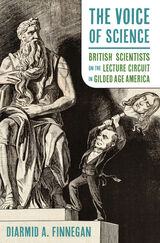 The Voice of Science: British Scientists on the Lecture Circuit in Gilded Age America
Diarmid A. Finnegan
University of Pittsburgh Press, 2021 For many in the nineteenth century, the spoken word had a vivacity and power that exceeded other modes of communication. This conviction helped to sustain a diverse and dynamic lecture culture that provided a crucial vehicle for shaping and contesting cultural norms and beliefs. As science increasingly became part of public culture and debate, its spokespersons recognized the need to harness the presumed power of public speech to recommend the moral relevance of scientific ideas and attitudes. With this wider context in mind, The Voice of Science explores the efforts of five celebrity British scientists—John Tyndall, Thomas Henry Huxley, Richard Proctor, Alfred Russel Wallace, and Henry Drummond—to articulate and embody a moral vision of the scientific life on American lecture platforms. These evangelists for science negotiated the fraught but intimate relationship between platform and newsprint culture and faced the demands of audiences searching for meaningful and memorable lecture performances. As Diarmid Finnegan reveals, all five attracted unrivaled attention, provoking responses in the press, from church pulpits, and on other platforms. Their lectures became potent cultural catalysts, provoking far-reaching debate on the consequences and relevance of scientific thought for reconstructing cultural meaning and moral purpose.
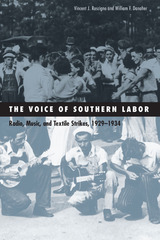 Voice Of Southern Labor: Radio, Music, And Textile Strikes, 1929-1934
Vincent J. Roscigno
University of Minnesota Press, 2004
Vividly shows how music united striking workers
The 1934 strike of southern textile workers, involving nearly 400,000 mill hands, remains perhaps the largest collective mobilization of workers in U.S. history. How these workers came together in the face of the powerful and coercive opposition of management and the state is the remarkable story at the center of this book.
The Voice of Southern Labor chronicles the lives and experiences of southern textile workers and provides a unique perspective on the social, cultural, and historical forces that came into play when the group struck, first in 1929, and then on a massive scale in 1934. The workers’s grievances, solidarity, and native radicalism of the time were often reflected in the music they listened to and sang, and Vincent J. Roscigno and William F. Danaher offer an in-depth context for understanding this intersection of labor, politics, and culture. The authors show how the message of the southern mill hands spread throughout the region with the advent of radio and the rise of ex–mill worker musicians, and how their sense of opportunity was further bolstered by Franklin D. Roosevelt’s radio speeches and policies.
The Voice of That Singing
Juliet Rodeman
Tupelo Press, 2017 Juliet Rodeman creates a visionary world in which the here and now—each remembered place, historical or mythical landscape, and moment alive with casual gesture—is redeemed by intimacy. Whimsical and sometimes shocking, these poems are filled with the heartbreak of what happens to our bodies. In a series of “anticipatory elegies” the poet journeys to the Underworld, moving through incantations and harmonies, hypnogogic terrors and quiet conversations under the stars, transforming individual grief with tenderness.
 The Voice of the Dawn: An Autohistory of the Abenaki Nation
Frederick Matthew Wiseman
University Press of New England, 2001 "[My] story is a sash woven of many strands of language. The first strand is the remembered wisdom of the Abenaki community. The second strand is our history and that of our relatives, written down by European, Native American, and Euroamerican observers. The third strand is what our Mother the Earth has revealed to us through the studies and writings of those who delve in her, the archaeologists and paleoecologists. The fourth strand is my own family history and its stories. The fifth strand is, of course, that which has come to me alone, stories which I create with my own beliefs and visions." So begins the first book about Abenaki history and culture written from the inside. Frederick Matthew Wiseman's extensive research and personal engagement breathe life into Voice of the Dawn, making it truly unique. Colin Calloway, Chair of Native American Studies at Dartmouth College, writes, "Going beyond all previous works on the Abenakis, Wiseman draws on family and community knowledge in a way that none of those authors could, speaks from an avowedly Abenaki perspective, and addresses aspects and issues ignored in other works. Moreover, no one that I know of has done as much work in locating and regathering items of Western Abenaki material culture. The quality and quantity of illustrations alone make this an attractive book, as well as a valuable visual record of change and persistence over time. As someone personally and pivotally involved in the Abenaki renaissance, Wiseman brings the story up to date without closing it."
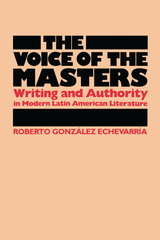 The Voice of the Masters: Writing and Authority in Modern Latin American Literature
By Roberto González Echevarría
University of Texas Press, 1985 By one of the most original and learned critical voices in Hispanic studies— a timely and ambitious study of authority as theme and authority as authorial strategy in modern Latin American literature. An ideology is implicit in modern Latin American literature, argues Roberto González Echevarría, through which both the literature itself and criticism of it define what Latin American literature is and how it ought to be read. In the works themselves this ideology is constantly subjected to a radical critique, and that critique renders the ideology productive and in a sense is what constitutes the work. In literary criticism, however, too frequently the ideology merely serves as support for an authoritative discourse that seriously misrepresents Latin American literature. In The Voice of the Masters, González Echevarría attempts to uncover the workings of modern Latin American literature by creating a dialogue of texts, a dynamic whole whose parts are seven illuminating essays on seminal texts in the tradition. As he says, "To have written a sustained, expository book ... would have led me to make the same kind of critical error that I attribute to most criticism of Latin American literature.... I would have naively assumed an authoritative voice while attempting a critique of precisely that critical gesture." Instead, major works by Barnet, Cabrera Infante, Carpentier, Cortázar, Fuentes, Gallegos, García Márquez, Roa Bastos, and Rodó are the object of a set of independent deconstructive (and reconstructive) readings. Writing in the tradition of Derrida and de Man, González Echevarría brings to these readings both the penetrative brilliance of the French master and a profound understanding of historical and cultural context. His insightful annotation of Cabrera Infante's "Meta-End," the full text of which is presented at the close of the study, clearly demonstrates these qualities and exemplifies his particular approach to the text.
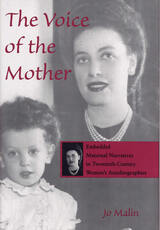 The Voice of the Mother: Embedded Maternal Narratives in Twentieth-Century Women's Autobiographies
Jo Malin
Southern Illinois University Press, 2000
Every woman autobiographer is a daughter who writes and establishes her identity through her autobiographical narrative. In The Voice of the Mother, Jo Malin argues that many twentieth-century autobiographies by women contain an intertext, an embedded narrative, which is a biography of the writer/daughter’s mother.
Analyzing this narrative practice, Malin examines ten texts by women who seem particularly compelled to tell their mothers’ stories: Virginia Woolf, Sara Suleri, Kim Chernin, Drusilla Modjeska, Joan Nestle, Carolyn Steedman, Dorothy Allison, Adrienne Rich, Cherríe Moraga, and Audre Lorde. Each author is, in fact, able to write her own autobiography only by using a narrative form that contains her mother’s story at its core. These texts raise interesting questions about autobiography as a genre and about a feminist writing practice that resists and subverts the dominant literary tradition.
Malin theorizes a hybrid form of autobiographical narrative containing an embedded narrative of the mother. The textual relationship between the two narratives is unique among texts in the auto/biographical canon. This alternative narrative practice—in which the daughter attempts to talk both to her mother and about her—is equally an autobiography and a biography rather than one or the other. The technique is marked by a breakdown of subject/object categories as well as auto/biographical dichotomies of genre. Each text contains a “self” that is more plural than singular, yet neither.
In addition to being a theoretical and textual analysis, Malin’s book is also a mother-daughter autobiography and biography itself. She shares her own story and her mother’s story as a way to connect directly with readers and as a way to bridge the gap between theory and practice.
The Voice of the Night: Complete Poetry and Prose of Chairil Anwar
Chairil Anwar
Ohio University Press, 1993 Chairil Anway (1922–1949) was the primary architect of the Indonesian literary revolution in both poetry and prose. In a few intense years he forged almost ingle-handedly a vital, mature literary language in Bahasa Indonesia, a language which formally came to exist in 1928. Anway led the way for the many Indonesian writers who have emerged during the past fifty years.
This volume contains all that has survived of Anwar’s writing. It not longer need the sort of introduction it did soem thirty years ago when Burton Raffel first published English translations of Anwar’s work. Raffel now presents the complete poems and the small amount of surviving prose in new translations with new interpretations.
The Voice of the Poor: Essays in Economic and Political Persuasion
John Kenneth Galbraith
Harvard University Press, 1983 What is surprising about these essays is not the insight and grace with which they are written—we have come to expect that—but the fact that nobody has expressed matters in quite this way before. John Kenneth Galbraith writes about what advice the poor nations (as, avoiding euphemism, he calls them) ought to offer to the more fortunate countries. In this little book there are essential lessons to ponder—for the governments of the rich countries, for those of the poor lands, and for the concerned citizens of both.
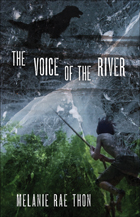 The Voice of the River: A Novel
Melanie Rae Thon
University of Alabama Press, 2011 Normal0falsefalsefalseMicrosoftInternetExplorer4 Missing: seventeen-year-old Kai Dionne and his dog Talia. The search for these two spans a single day, morning twilight to late evening, from the time Kai leaps in a half-frozen river to save the dog to the hour he and Talia are recovered. Each person who comes to the river brings his or her secret needs and desires; each has known loss, and all are survivors: a homeless boy tries to find himself, his lost twin, his double; a childless mother grieves for her son and daughter; a man who shot his father recalls a tender, intimate night “when the father was kind, and not afraid, and not angry.” Kai and Talia belong to, and are loved by, a whole community. As strangers work together toward a single cause, they become family—bound by love not only to the ones lost, but to all who gather. The perceiving consciousness is oceanic and atmospheric, embracing all living beings, swirling around a person, a bird, a bear, trillium blooming in dark woods, snow, stones, pines singing—moving closer and closer, loving, finally merging, sensing and knowing as one, before lightly whirling out again to embrace and love another. This powerful current of shared memory and experience, this ceaseless prayer, is a celebration of life, all life, mystery and miracle within an immense animate landscape, a song of praise, the voice of the river. Melanie Rae Thon opens a new genre: call it Eco Avant-Garde, a confession of faith, and a love song to the world.
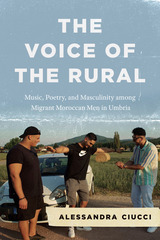 The Voice of the Rural: Music, Poetry, and Masculinity among Migrant Moroccan Men in Umbria
Alessandra Ciucci
University of Chicago Press, 2022 A moving portrait of the contemporary experiences of migrant Moroccan men.
Umbria is known to most Americans for its picturesque rolling hills and medieval villages, but to the many migrant Moroccan men who travel there, Umbria is better known for the tobacco fields, construction sites, small industries, and the outdoor weekly markets where they work. Marginalized and far from their homes, these men turn to Moroccan traditions of music and poetry that evoke the countryside they have left— l-‘arubiya, or the rural. In this book, Alessandra Ciucci takes us inside the lives of Moroccan workers, unpacking the way they share a particular musical style of the rural to create a sense of home and belonging in a foreign and inhospitable nation. Along the way, she uncovers how this culture of belonging is not just the product of the struggles of migration, but also tied to the reclamation of a noble and virtuous masculine identity that is inaccessible to Moroccan migrants in Italy.
The Voice of the Rural allows us to understand the contemporary experiences of migrant Moroccan men by examining their imagined relationship to the rural through sound, shedding new light on the urgent issues of migration and belonging.
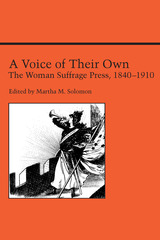 A Voice Of Their Own: The Woman Suffrage Press, 1840-1910
Martha Solomon
University of Alabama Press, 1991 A Voice of Their Own explores the consciousness-raising role of the American Suffrage press of the latter half of the 19th century. From the first women's rights convention--a modest gathering of three hundred sympathizers led by Elizabeth Cady Stanton--grew the ever-expanding movement for equal rights, greater protection, and improved opportunities. Although the leaders of that and subsequent conventions realized that such public rallies, with their exhortative speeches, were crucial in gaining support for the movement, they also recognized the potentioal impact of another medium--woman's suffrage periodicals, written and published by and expressly for women. The eleven essays of this volume demonstrate how the suffrage press-- in such works as Woman's Journal, Woman's Tribune, Woman's Exponent, and Farmer's Wife-- was able to educate an audience of women readers, crate a sense of community among them, and help alter their self-image.
 A Voice of Thunder: A BLACK SOLDIER'S CIVIL WAR
Edited by Donald Yacovone
University of Illinois Press, 1997 George E. Stephens, the most
important African-American war correspondent of his era, served in the
famed black Fifty-fourth Massachusetts Regiment, subject of the film Glory.
His letters from the front, published in the New York Weekly Anglo-African,
brilliantly detail two wars: one against the Confederacy and one against
the brutal, debilitating racism within his own Union Army. Together with
Donald Yacovone's biographical introduction detailing Stephens's life
and times, they provide a singular perspective on the greatest crisis
in the history of the United States.
Stephens chronicled the African-American
quest for freedom in reports from southern Maryland and eastern Virginia
in 1861 and 1862 that detailed, among other issues of the day, the Army
of the Potomac's initial encounter with slavery, the heroism of fugitive
slaves, and the brutality both Southerners and Union troops inflicted
on them.
From the inception of the
Fifty-fourth early in 1863 Stephens was the unit's voice, telling of its
struggle against slavery and its quest to win the pay it had been promised.
His description of the July 18, 1863, assault on Battery Wagner near Charleston,
South Carolina, and his writings on the unit's eighteen-month campaign
to be paid as much as white troops are gripping accounts of continued
heroism in the face of persistent insult.
The Weekly Anglo-African
was the preeminent African-American newspaper of its time. Stephens's
correspondence, intimate and authoritative, takes in an expansive array
of issues and anticipates nearly all modern assessments of the black role
in the Civil War. His commentary on the Lincoln administration's wartime
policy and his conviction that the issues of race and slavery were central
to nineteenth-century American life mark him as a major American social
critic.
 The Voice of Toil: Nineteenth-Century British Writings about Work
David J. Bradshaw
Ohio University Press, 1999 One of the most recurrent and controversial subjects of nineteenth–century discourse was work. Many thinkers associated work with honest pursuit of doing good, not the curse accompanying exile from Eden but rather “a great gift of God.” Sincerely undertaken work comprised a mission entailing a commitment to serve others and promote a better future for all.
Satisfaction with what work could do for individuals had its counterbalance in the anger and dismay expressed at the conditions of those whom Robert Owen, in 1817, first called the “working class.” What working–class people confronted both at the labor site and at their lodgings was construed as oppressive, and the misery of their lives became the subject of sentimental poetry, government report, popular fiction, and journalistic expose. Perhaps as heated as the discussion about conditions of lower–class workers was the conversation about separate spheres of work for men and women. This conversation, too, found its way into the literature and public discourse of the day.
In The Voice of Toil, the editors have collected the central writings from a pivotal place and time, including poems, stories, essays, and a play that reflect four prominent ways in which the subject of work was addressed: Work as Mission, Work as Opportunity, Work as Oppression, and (Separate) Spheres of Work. The resulting anthology offers a provocative text for students of nineteenth-century British literature and history and a valuable resource for scholars.
The text includes readings from John Wesley, William Blake, Elizabeth Gaskell, William Wordsworth, Charles Dickens, Florence Nightingale, William Morris, Joanna Baillie, Friedrich Engels, Matthew Arnold, Angela Burdett–Coutts, John Stuart Mill, Elizabeth Barrett Browning, Bernard Shaw and many others.
Voice Over IP (Internet Protocol): Systems and solutions
Richard Swale
The Institution of Engineering and Technology, 2001 Voice over Internet Protocol (VoIP) has recently evolved from a simple capability for transporting voice communications into a much more powerful technology capable of changing the way voice applications are constructed, delivered, marketed and sold. Whilst VoIP has clearly provided a focus for much debate within the telecommunications industry, there has been a clear gulf between hype and reality. However the questions now being asked have migrated from 'Will it work?' to 'What will the industry look like when it is delivered at scale?'
 Voice Over: The Making of Black Radio
William Barlow
Temple University Press, 1998 In Voice Over, a celebration and history, William Barlow explores the entire landscape of black radio from the early days - when the white public accepted the black-face buffoonery of "The Amos and Andy Show" and "Beulah" as a fair depiction of African American Life - to the rise of personality jocks and the contemporary scene of corporate buyouts and uncertain fate.
Barlow, whose voice has been heard on WPFW (Washington, D.C.) for many years, brings an insider's knowledge to this account of black radio as a predominantly local and still powerful medium. Many of the broadcasters he profiles -- Jack Cooper, Paul Robeson, Richard Durham, Cathy Hughes, Al Benson, Georgie Woods, Peggy Mitchell, Hal Jackson, Jocko Henderson, Mary Mason, Wesley South, Martha Jean "the Queen" Steinberg, to name a few -- became not only celebrities but also respected members of their communities. Atlanta's Jack "the Rapper" Gibson, for instance, tells how he literally shared his microphone with Rev. Martin Luther King Jr. to announce meetings and rally listeners around a key issue. By showing the extent to which so many black broadcasters achieved the status of trusted and influential community leaders, Barlow acknowledges that their grassroots activism was an indispensable and often overlooked part of the ongoing African American civil rights movement.
Voice Over also addresses black radio's broadly significant role in entertainment and shifting race relations. Until the rock and roll revolution, audiences had largely been segregated. The African American personality jocks who introduced white teens to rhythm and blues were a revelation; their wild style and personas and the music they played changed broadcasting while it enthralled a multiracial audience. Although the stations that introduced the enormously popular music were identified as black, virtually none was black-owned or managed. The broadcasters who distanced themselves from music industry perks and payoffs proposed an ambitious agenda for change. This little-known story sets the stage for how the proliferation of black-owned stations and networks occurred and for Barlow's assessment of the instability of today's black radio scene.
Written for a broad spectrum of readers -- from nostalgic fans of Jocko and Georgie Woods to loyal listeners of surviving stations and media watchers committed to diversity in broadcasting -- Voice Over tells the whole story of the making of black radio.
A Voice: Selected Poems
Anzhelina Polonskaya
Northwestern University Press, 2004 Anzhelina Polonskaya is considered one of the freshest voices among young Russian poets. Unlike most of her contemporaries, she was not educated in the classic literary tradition, nor nurtured by the well-known Moscow and Petersburg journals. This has freed her from self-consciously struggling under the weight of her country's literary tradition, and her independent, even idiosyncratic, voice informs poems filled with sharp images, acute observations, and both the pains and joys of personal experience.
Drawn from her most recent Russian collections, A Voice: Selected Poems explores the poet's ongoing fascinations—desolate places, long journeys, a synesthesia of sensory stimulation, and the presence of death. Also on display is her Chekhovian gift for unexpected closure. This is a promising English-language debut from a poet already gaining international attention.
 Voice, Silence and Gender in South Africa's Anti-Apartheid Struggle: The Shadow of a Young Woman
Rachel E. Johnson
University of London Press, 2025 In 1978, amidst the aftermath of the Soweto Uprisings and after being held in detention without charge for over a year, a young black woman who had just turned eighteen stepped into the witness box at Kempton Park Circuit Court, northeast of Johannesburg. She was there to testify in the apartheid State’s case against eleven Soweto school student activists, on trial for sedition. She confirmed her name as Mary Masabata Loate. Loate would live with the consequences of this decision to talk for the rest of her short life.
Who spoke about the liberation struggle whilst it was ongoing? When did they speak and how? And what effects do the gendered history of speech and silence within anti-apartheid politics continue to have upon our knowledge of the past? Arguing that she is emblematic of the way gendered narratives of the struggle have been made, this book listens for the voice and silence of Masabata Loate and her contemporaries within political trials; newspapers; photography; human rights reportage; creative fiction, drama, poetry and song; autobiography and memoir; and oral histories. The result is an unconventional biography that sees this young woman as a shadow within the story of South Africa’s anti-apartheid liberation struggle.
 Voice, Silence, and Self: Negotiations of Buraku Identity in Contemporary Japan
Christopher Bondy
Harvard University Press, 2015 The Burakumin. Stigmatized throughout Japanese history as an outcaste group, their identity is still “risky,” their social presence mostly silent, and their experience marginalized in public discourse. They are contemporary Japan’s largest minority group—between 1.5 and 3 million people. How do young people today learn about being burakumin? How do they struggle with silence and search for an authentic voice for their complex experience?
Voice, Silence, and Self examines how the mechanisms of silence surrounding burakumin issues are reproduced and challenged in Japanese society. It explores the ways in which schools and social relationships shape people’s identity as burakumin within a “protective cocoon” where risk is minimized. Based on extensive ethnographic research and interviews, this longitudinal work explores the experience of burakumin youth from two different communities and with different social movement organizations.
Christopher Bondy explores how individuals navigate their social world, demonstrating the ways in which people make conscious decisions about the disclosure of a stigmatized identity. This compelling study is relevant to scholars and students of Japan studies and beyond. It provides crucial examples for all those interested in issues of identity, social movements, stigma, and education in a comparative setting.
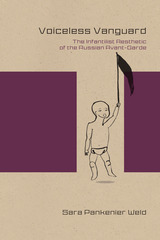 Voiceless Vanguard: The Infantilist Aesthetic of the Russian Avant-Garde
Sara Pankenier Weld
Northwestern University Press, 2014 Winner, 2015 International Research Society in Children's Literature (IRSCL) Book Award
Voiceless Vanguard: The Infantilist Aesthetic of the Russian Avant-Garde offers a new approach to the Russian avant-garde. It argues that central writers, artists, and theorists of the avant-garde self-consciously used an infantile aesthetic, as inspired by children’s art, language, perspective, and logic, to accomplish the artistic renewal they were seeking in literature, theory, and art. It treats the influence of children’s drawings on the Neo-Primitivist art of Mikhail Larionov, the role of children’s language in the Cubo-Futurist poetics of Aleksei Kruchenykh, the role of the naive perspective in the Formalist theory of Viktor Shklovsky, and the place of children’s logic and lore in Daniil Kharms’s absurdist writings for children and adults. This interdisciplinary and cultural study not only illuminates a rich period in Russian culture but also offers implications for modernism in a wider Western context, where similar principles apply.
Voices: An Anthropologist's Dialogue with an Italian-American Festival
Richard M. Swiderski
University of Wisconsin Press, 1987 This is a study of the St. Peter's Fiesta celebrated annually by the Italian, or better, Sicilian-American community of Gloucester, Massachusetts, USA. The study deals specifically with the fiesta that took place 25–28 June 1970.
Voices and Votes: How Democracy Works in Wisconsin
Jon Kasparek
Wisconsin Historical Society Press, 2006
Voices & Votes: How Democracy Works in Wisconsin invites upper elementary school students to explore the intersection of American civics and Wisconsin history. This sixth and final book in the New Badger History series introduces students to the basic structures of American democracy, state government, and Wisconsin's road to statehood. The first seven chapters help students grasp how the three branches of government function at the federal, state, local, and tribal levels, while tying these structural notions to Wisconsin history. Students will learn that citizens' voices and votes help government evolve to meet ever-changing societal needs. The last chapter emphasizes how young people can actively engage in their communities to bring about positive change.
 Voices and Votes: How Government Works in Wisconsin
Wisconsin Historical Society
Wisconsin Historical Society Press, 2025 An engaging introduction to civics for young readers with an emphasis on participation. What are the different levels of government in Wisconsin? How are laws made? What is a political party? Who is allowed to vote in elections? How can citizens get involved in their communities? These questions and many more are answered in this revised and updated edition of Voices and Votes, aimed at students in grades 3–5. Filled with color photos and illustrations—as well as diagrams, maps, and vocabulary words that make the material easy to absorb—this book explores: - The fundamentals of federal, state, local, and Tribal government
- How Wisconsin’s constitution was created and how it has changed
- The way elections work and why voting matters
Readers will also find compelling examples of citizens from our state’s past who spoke up and worked to change laws and policies in order to improve their communities, including: - Gaylord Nelson, who advocated for the environment as a state senator, member of Congress, and governor
- Vel Phillips, who helped expand housing opportunities as a member of Milwaukee’s city council
- Jesus Salas, who worked with state agencies to improve the lives of migrant farmworkers in Wisconsin
The book also offers contemporary stories of young people engaging with their communities, working to solve problems, and sharing their voices. This brilliantly updated edition of Voices and Votes will inspire a new generation of readers to understand and participate in our democracy.
Voices and Votes Teacher's Guide: How Democracy Works in Wisconsin TG
Jon Kasparek and Bobbie Malone
Wisconsin Historical Society Press, 2006
Voices and Votes: How Democracy Works in Wisconsin; Teacher's Guide and Student Materials features several activities for each chapter to engage students in a more in-depth exploration of the book. These activities, designed for both individual and small groups, demand the use of higher-level thinking skills while integrating a wide range of learning styles, and all have culminating components that can be used for assessment. The guide also features easily reproducible student pages, including maps, charts, and interesting illustrations.
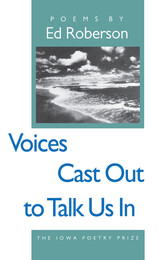 Voices Cast Out to Talk Us In
Ed Roberson
University of Iowa Press, 1995 There is no one else like Ed Roberson—certainly there is no other poet like him. His is an oblique, eccentric, totally fascinating talent. Because of these qualities, it may seem that he is difficult to follow—as Ornette Coleman or Gabriel García Márquez or Romare Beardon seems difficult to track at times. But his strength of vision is always evident; the quickness and inclusiveness of his voice can sweep a reader along into new and refreshing areas. Roberson's poetic moves are not tricks or affected traits. They are artistic and deeply considered techniques. Reading the two basic cycles of this elliptical and intriguing work could be likened to reading Ezra Pound or a more deliberate and lyrically touched Charles Olson, but with an unanchored allusiveness of things largely American taking the place of the Chinese and the Mayan. Roberson creates that rare combination of sophistication and simplicity which defines truly significant poetry. In this new work he makes the variety of our culture dance from his very special viewpoint.
 Voices: Educational Formation Of Conscience
Thomas F. Green
University of Notre Dame Press, 2001 Voices: The Educational Formation of Conscience aims to revise our thinking about moral education and thus to revise our grasp of how we ought to go about it. Moral education is the formation of conscience and conscience is simply the exercise of reflexive judgment. Thomas F. Green focuses on how conscience is formed by the acquisition of norms rather than concentrating on the foundations of norms or their logical status.
Norm acquisition is neither socialization nor simply a matter of learning to reason about conduct. It is, instead, a matter of governance, a question as to what it means to say that norms come to govern conduct even when the norms that govern and the conduct that results is morally less than we might hope for, sometimes even less than we have a right to expect. Green argues that human behavior may be shaped, but human conduct is governed. The proper business of moral education is to encourage the reflexive self-judgment of conscience to assume this office of governance. And, at least in a democratic order, conscience is encouraged to assume that office of governance, partly by taking on the norms of the office of citizen.
If conscience is understood as reflexive judgment and its formation as norm acquisition, then what counts as moral education is considerably enlarged. Self-governance of norms is implicated in the exercise of every craft and profession and in all the practices of inquiry. It is this that underlies our conceptions of excellence in every precinct of practice for which education pretends to offer preparation. Thus conscience does not speak with one voice, but with several. There is the conscience of craft, of membership, of duty, of course, but also of memory and imagination. There is no reason to suppose that these voices ever speak in unison or ever in total agreement. What moral education seeks is not to settle the quarrels of conscience, but to stimulate them, make them more rational, more passionate, and more discerning.
Thomas F. Green is Professor Emeritus of Philosophy and Education and was a founding Director of the Educational Policy Research Center at Syracuse University.
Reviews:
"[Voices ] soars. Not only is it worth reading, it bears studying! It affords a fresh new look on issues of great currency: the place of values in teaching; the nature of conscience in society and social aggregations like professions; what conscience is; and how we can come to know it has been developed." -The Educational Forum
|
|
